HORSE-HEALTH ISSUE
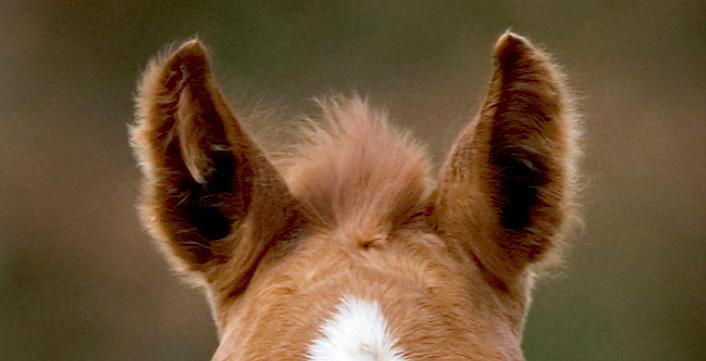

Nutrition for All Ages and Stages
Disaster Preparedness for Horse and Farm Owners (p. 46)
Does Rider Size Matter in Dressage? (p. 32)

July/August 2023 Official Publication of the United States Dressage Federation

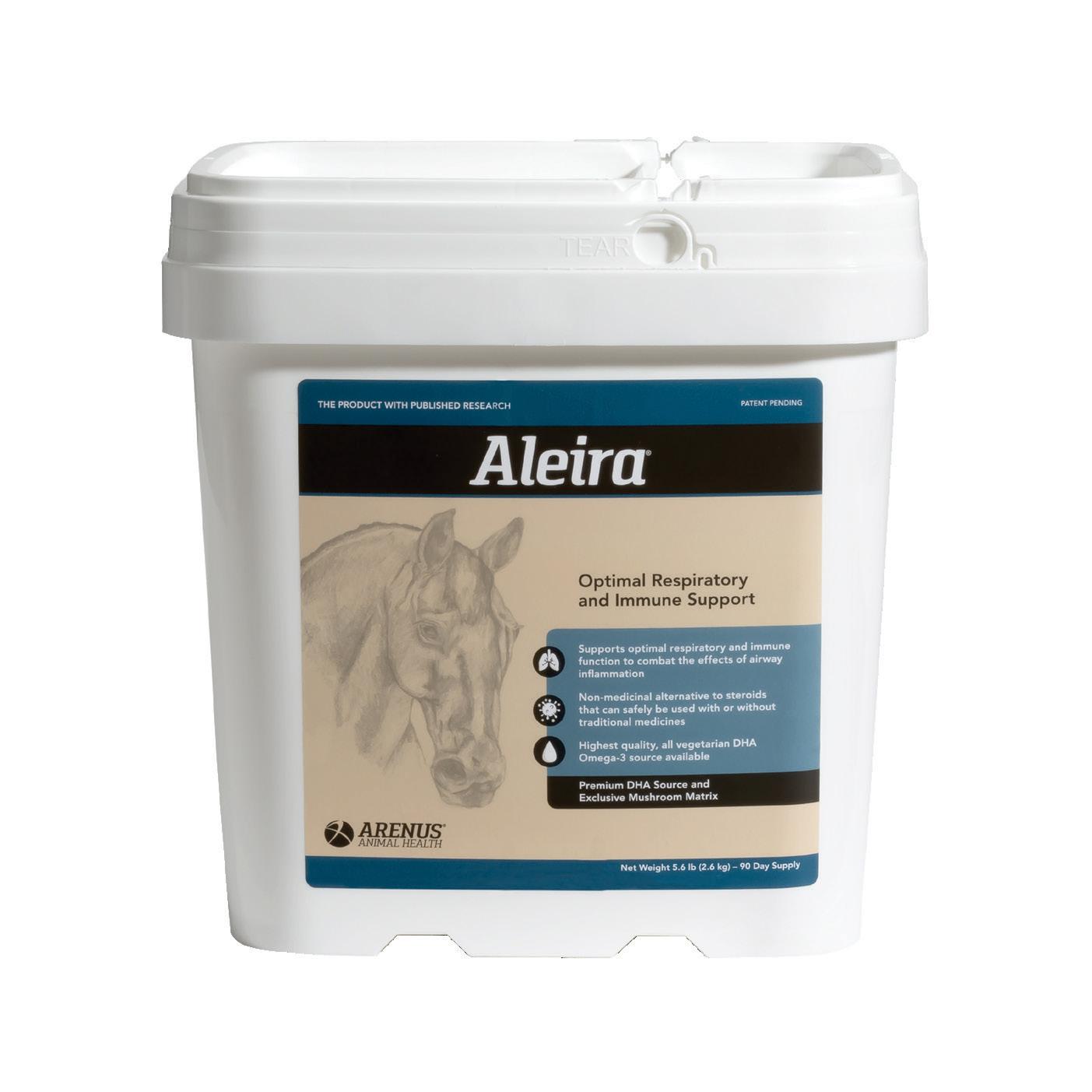

Hilton Omaha www.usdf.org/convention NOV 29 – DEC 2, 2023
YourDressage delivers exclusive dressage stories, editorial, and education, relevant to ALL dressage enthusiasts and is your daily source for dressage!
Look for these featured articles online at YourDressage.org
EDUCATION
“Let’s Ride the 2023 Tests!”
With great tips and insights from Jeanne McDonald and Jim Koford, get a front row seat at the Lehigh Valley Dressage Association’s symposium.
COMPETITION
“Unforgettable Moments from the FEI World Cup”
Travel with us to Omaha for a memorable week featuring the world’s best dressage, jumping, and vaulting athletes.
ACHIEVEMENT
“From Amish Plow Horse to Third Level Dressage”
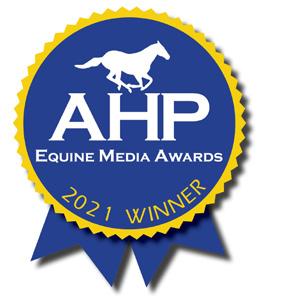
A junior rider shares about finding her heart horse moments before she stepped onto a slaughter truck, and how the Draft cross has gone on to defy dressage standards.
COMMUNITY
“A Mirror of Myself”
An equestrian in Region 2 shares about the rescue Mustang who helped her on her mental health journey with depression and anxiety.
It’s YourDressage, be a part of it! Visit https://yourdressage.org/ for all these stories & much more!
USDF CONNECTION
The Official Publication of the United States Dressage Federation
EXECUTIVE DIRECTOR Stephan Hienzsch (859) 271-7887 • stephh1enz@usdf.org
EDITOR Jennifer O. Bryant (610) 344-0116 • jbryant@usdf.org
CONTRIBUTING EDITOR Hilary M. Clayton, BVMS, PhD, MRCVS EDITORIAL ADVISORS
Margaret Freeman (NC), Anne Gribbons (FL), Roberta Williams (FL), Terry Wilson (CA)
TECHNICAL ADVISORS Janine Malone, Lisa Gorretta, Elisabeth Williams
PRODUCTION Emily Koenig • ekoenig@usdf.org
GRAPHIC & MULTIMEDIA COORDINATOR Katie Lewis (859) 271-7881 • klewis@usdf.org
ADVERTISING SALES REPRESENTATIVE Danielle Titland (720) 300-2266 • dtitland@usdf.org
USDF OFFICERS AND EXECUTIVE BOARD
PRESIDENT GEORGE WILLIAMS 421 Park Forest Way, Wellington, FL 33414 (937) 603-9134 • president@usdf.org
VICE PRESIDENT KEVIN REINIG, 6907 Lindero Lane, Rancho Murieta, CA 95683 (916) 616-4581 • vicepresident@usdf.org
SECRETARY DEBRA REINHARDT 16305 63rd Road N, Loxahatchee, FL 33470 (203) 264-2148 • secretary@usdf.org
TREASURER LORRAINE MUSSELMAN 7538 NC 39 Hwy, Zebulon, NC 27497 (919) 218-6802 • treasurer@usdf.org
REGIONAL DIRECTORS
REGION 1 DC, DE, MD, NC, NJ, PA, VA
BETTINA G. LONGAKER 8246 Open Gate Road, Gordonsville, VA 22942 (540) 832-7611 • region1dir@usdf.org
REGION 2 IL, IN, KY, MI, OH, WV, WI DEBBY SAVAGE 7011 Cobblestone Lane, Mentor, OH 44060 (908) 892-5335 • region2dir@usdf.org
REGION 3 AL, FL, GA, SC, TN
CHARLOTTE TRENTELMAN P.O. Box 381, Anthony, FL 32617 (352) 598-7704 • region3dir@usdf.org
REGION 4 IA, KS, MN, MO, NE, ND, SD
ANNE SUSHKO 1942 Clifford Street, Dubuque, IA 52002 (563) 580-0510 • region4dir@usdf.org
REGION 5 AZ, CO, E. MT, NM, UT, W. TX, WY
HEATHER PETERSEN 22750 County Road 37, Elbert, CO 80106 (303) 648-3164 • region5dir@usdf.org
REGION 6 AK, ID, W. MT, OR, WA
NOAH RATTNER 25033 SW Pacific Hwy, Sherwood, OR 97140 (503) 449-1274 • region6dir@usdf.org
REGION 7 CA, HI, NV
CAROL TICE 31895 Nicolas Road, Temecula, CA 92591 (714) 514-5606 • region7dir@usdf.org
REGION 8 CT, MA, ME, NH, NY, RI, VT
HELEN VAN DER VOORT 8 Boulevard West, PH4, Pelham, NY 10803 (917) 834-2635 • region8dir@usdf.org
REGION 9 AR, LA, MS, OK, TX
BESS BRUTON 5696 Piper Lane, College Station, TX 77845 (662) 702-9854 • region9dir@usdf.org
AT-LARGE DIRECTORS
ACTIVITIES COUNCIL
SUE MANDAS 9508 Bridlewood Trail, Dayton, OH 45458 (937) 272-9068 • ald-activities@usdf.org
ADMINISTRATIVE COUNCIL
BARBARA CADWELL 324 Benjamin Street, Fernandina Beach, FL (715) 350 1967 • ald-administrative@usdf.org
TECHNICAL COUNCIL
SUE MCKEOWN 6 Whitehaven Lane, Worcester, MA 01609 (508) 459-9209 • ald-technical@usdf.org
USDF Connection is published bimonthly by the United States Dressage Federation, 4051 Iron Works Parkway, Lexington, KY 40511. Phone: 859/971-2277. Fax: 859/971-7722. E-mail: usdressage@usdf.org, Web site: www. usdf.org. USDF members receive USDF Connection as a membership benefit, paid by membership dues. Copyright © 2023 USDF. All rights reserved.
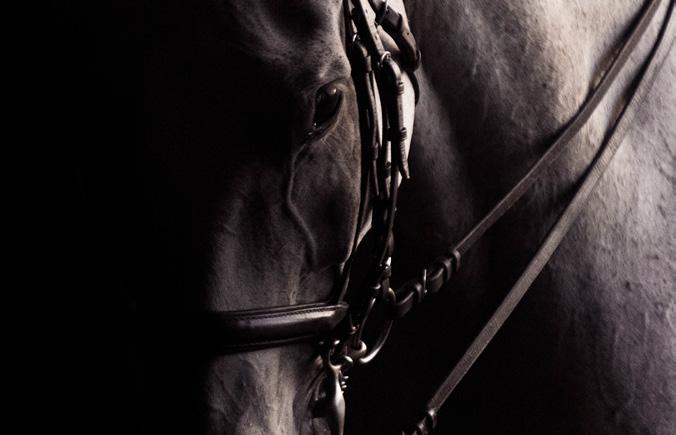
USDF reserves the right to refuse any advertising or copy that is deemed unsuitable for USDF and its policies. Excluding advertisements, all photos with mounted riders must have safety head gear or USEF-approved competition hat. USDF assumes no responsibility for the claims made in advertisements. Statements of fact and opinion are those of the experts consulted and authors, and do not necessarily reflect the opinions of the editors or the policy of USDF.
The publishers reserve the right to reject any advertising deemed unsuitable for USDF, as well as the right to reject or edit any manuscripts received for publication. USDF assumes no responsibility for unsolicited material. All materials must be accompanied by a self-addressed, stamped envelope.
Questions about your subscription or change in address? Contact USDF Membership Department, 859/971-2277, or usdressage@usdf.org.
POSTMASTER: SEND ADDRESS CHANGES TO: USDF, 4051 IRON WORKS PARKWAY, LEXINGTON, KY 40511. Canadian Agreement No. 1741527. Canada return address: Station A, P.O. Box 54, Windsor, Ontario N9A 6J5.
2 July/August 2023 | USDF CONNECTION
An official property of the United States Dressage Federation
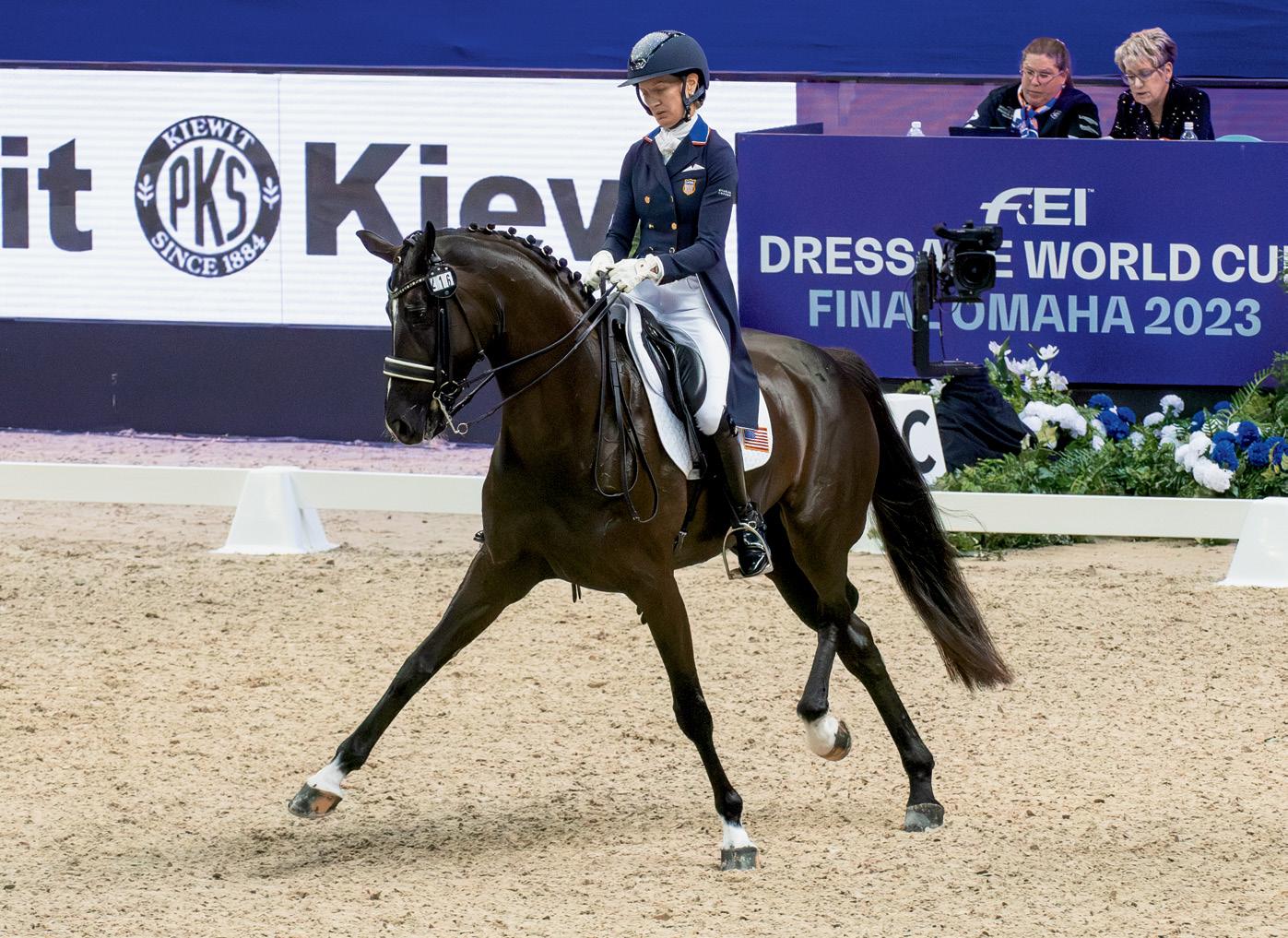
USDF CONNECTION | July/August 2023 3 Columns 4 Inside USDF Across the Spectrum By George Williams 6 Ringside Home Grown By Jennifer O. Bryant Departments 18 Clinic Immersed in Horses By Beth Baumert 22 The Judge’s Box Merry Christmas! By Marilyn Heath 24 Sport Horse Online Shopping By Patti Schofler 28 GMO Your GMO’s Best Marketing Tool By Penny Hawes 32 Rider Does Size Really Matter? By Jennifer Mellace 66 Reviews Practical Advice By Jennifer O. Bryant 72 Salute Para-Dressage Is Her Life’s Work By Katherine Walcott Basics 10 Sponsor Spotlight 11 Collection 68 Rider’s Market 70 USDF Connection Submission Guidelines 70 USDF Office Contact Directory 71 Advertising Index On Our Cover Photo by Arnd Bronkhorst/arnd.nl. Features 38 Nutrition for All Ages and Stages Feeding advice for the dressage horse, from foals and breeding stock to Grand Prix By Heather Smith Thomas 46 Prepare for the Worst Of course you hope for the best—but when severe weather threatens, you’d better have a plan in place. First of two parts. By Judy Nauseef 52 Building the Para-Dressage Pipeline Through designated Centers of Excellence, US Equestrian aims to expand the sport, beginning at the grass roots By Riley Garrett 56 Made in America The three US entrants wowed the home-country crowd at the 2023 FEI World Cup Dressage Final in Omaha By Jennifer O. Bryant USDF Connection JULY/AUGUST 2023 Volume 25, Number 2 56
Across the Spectrum
USDF’s spring Executive Board meeting highlights the importance of engaging all dressage enthusiasts
By George Williams, USDF President
With USDF’s 2023 spring Executive Board (EB) meeting set against the backdrop of this year’s FEI World Cup Finals in Omaha, Nebraska, we had an opportunity to take a broad view of our sport. (It also provided a wonderful opportunity for three current board members, two USDF committee chairs, and USDF’s immediate past president to be able to work “behind the scenes” at the Finals.)
It’s moments like these that make it clear how wide the spectrum of dressage truly is, and how important it is for our organization to remain connected not only to both ends of that spectrum, but also to everything in between. For the USDF to thrive it must be all-encompassing, and that is not an easy task.
This fall, when we return to Omaha for the 2023 Adequan®/ USDF Annual Convention, Cirque du Soleil will be performing in the very same arena that held the World Cup Finals in dressage, jumping, and vaulting. The convention will be literally across the street from the CHI Health Center, at the Hilton Omaha. Not surprisingly, the upcoming convention was an important item of discussion during our very productive board meeting, with much time spent trying to find the right mix of governance, education, and fun. Not all may agree, but I believe that in our current virtual-obsessed world, in-person meetings are still irreplaceable. Watch for more information on the convention and how we plan to celebrate USDF’s 50th anniversary!
Committee news. From time to time, as an organization we must look at our committees to determine whether they are still valuable in their current form, with their stated goals and objectives. Most of USDF’s committees have been in place from the organization’s early days. The Membership Committee chair and other committee members had expressed concerns that other committees now cover its objectives, and therefore that the committee no longer serves a unique purpose. They brought their concerns to the USDF Administrative Council, and ultimately it was recommended to the EB that the committee should be discontinued. The EB agreed, and so the Membership Committee will be dissolved as of June 15.
The EB also took a look at the Freestyle Committee. The board moved to explore consolidating the Freestyle Committee and the Test Writing Working Group with the Judges Committee. A lot has happened in the world of dressage freestyle since the Freestyle
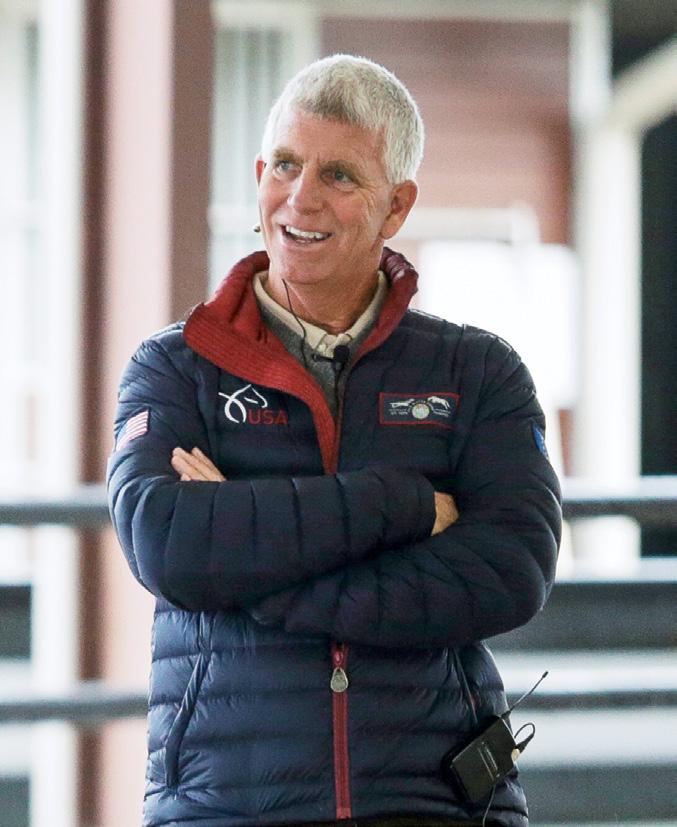
Committee was formed. For one, there are not as many pressing issues to address as when freestyles were introduced at the national levels many years ago. The stakeholders in these areas believe that it has become more important than ever to ensure good communication among freestyle advocates, judges, and those who write the dressage tests, and that we can more effectively facilitate this communication by consolidating the three groups.
It was a much easier decision to approve the recommendation by the Instructor/Trainer Committee to change its name to better reflect its goals. This group will now be known as the Instructor/Trainer Development Program Committee.
Likewise, the EB was happy to approve the Group Member Organizations Committee’s request to offer recognition pins to volunteers, to honor their years of service. Volunteers truly are the backbone of the GMOs and USDF.
We also were delighted to add Janet “Dolly” Hannon, of Arvada, Colorado, as a new USDF L Education Program faculty member. Dolly is a US Equestrian (USEF) “S” dressage judge with designations in equitation, freestyle, and young horse. A USDF bronze, silver, and gold medalist, Dolly chairs the USDF Freestyle Committee and is a faculty member of the USDF Instructor/Trainer Development Program.
Sport-horse news. The Sport Horse Committee successfully
4 July/August 2023 | USDF CONNECTION
Inside
PAGE 8
USDF CONTINUED ON

Home Grown
From the grass roots to the top, our sport is increasingly being made in the USA
This is USDF Connection’s annual horse-health issue, and it’s all about growing and developing excellence in US dressage (and paradressage) and in American-bred sport horses. Here’s an overview of what you’ll find in these pages.
You are what you eat, as the saying goes, and the same holds true for our horses. There are so many kinds of feeding regimens out there that it can be challenging to figure out what’s best for your dressage partner—not to mention for the stallions, mares, and youngsters that collectively represent our sport’s future.
For her story “Nutrition for All Ages and Stages” (p. 38), writer and longtime horse owner Heather Smith Thomas talked with equine-nutrition experts, sport-horse breeders, and the manager of a top dressage barn. They shared their insights and advice on how to keep breeding stock and performance horses well-fed and happy throughout the stages of their careers.
Excellence is built from the ground up, whether you’re training a horse or developing an equestrian athlete. In this issue’s “Clinic” (p. 18), Beth Baumert has a trainer-totrainer conversation with seven-time Swedish Olympian (and wintertime Florida resident) Tinne Vilhelmsen Silfvén, who reveals her keys to success. Spoiler alert: They involve basics, basics, basics.

While we’re nurturing and training those promising horses, we’re also nurturing and training promising riders. Not content to simply let potential para-dressage athletes stumble upon the sport, US Equestrian’s para-dressage program
is building a feeder system through which riders can test the waters and learn about para-dressage competition. Much of this activity takes place at equestrian facilities designated USEF Para-Dressage Centers of Excellence (COE). In “Building the Para-Dressage Pipeline” (p. 52), para-dressage rider and therapeuticriding instructor Riley Garrett explains the COE structure and drops in on a recent clinic with US para-dressage development coach Lisa Hellmer at a COE.
Building our sport sometimes means building in the literal sense. As climate change continues to result in increasingly severe weather events and so-called hundred-year storms become more like annual occurrences, horse and farm owners across the country have found themselves and their facilities tested and, in some cases, unable to withstand nature’s worst. Because the best defense is a good offense, we asked freelance writer and horse owner Judy Nauseef—whose own small Midwestern farm fell victim to a tornado as she was working on this
story—to explain what steps you should be taking to prepare your facility, horses, and boarders for swift and potentially life-saving action should you find yourselves in the bull’s eye of a dangerous weather event. Please read “Prepare for the Worst” (p. 46) and take its advice to heed— today! In the next issue, Judy will tackle the other side of the disasterpreparedness coin for dressage enthusiasts: when destructive conditions threaten dressage competitions and show grounds.
Finally, I couldn’t report on the 2023 FEI World Cup Dressage Final presented by Havensafe Farm (p. 56) without pointing out the “made in the USA” aspects of the tremendously successful competition. First, it was Omaha, Nebraska’s second time hosting the Final—the city’s debut edition, in 2017, was so successful that everyone involved was eager to do it again—and the first time since that year that the USA has hosted a Finals (the April event also included jumping and, for the first time, vaulting).
Second, audiences in Omaha got to cheer on three US horse-andrider pairs. And one of those pairs included a US-bred horse who is the product of one of our country’s best-known sport-horse breeders. If you were still harboring doubts that American-bred horses are the equal of their European counterparts, it’s time to put those aside. US-bred dressage horses have arrived!
Jennifer O. Bryant, Editor
 MICHAEL BRYANT
MICHAEL BRYANT
6 July/August 2023 | USDF CONNECTION
Ringside
FEI YOUTH CLINIC SERIES
George Williams
Internationally respected rider, trainer and instructor
Represented US in World Cup Finals and CHIO Aachen Team – Bronze Medalist
USEF High Performance and Pathway Development Advisor
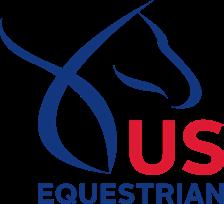
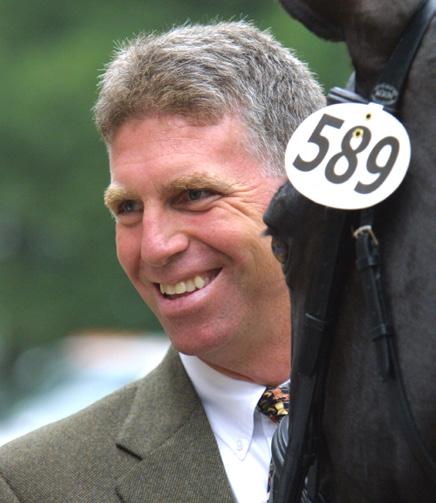
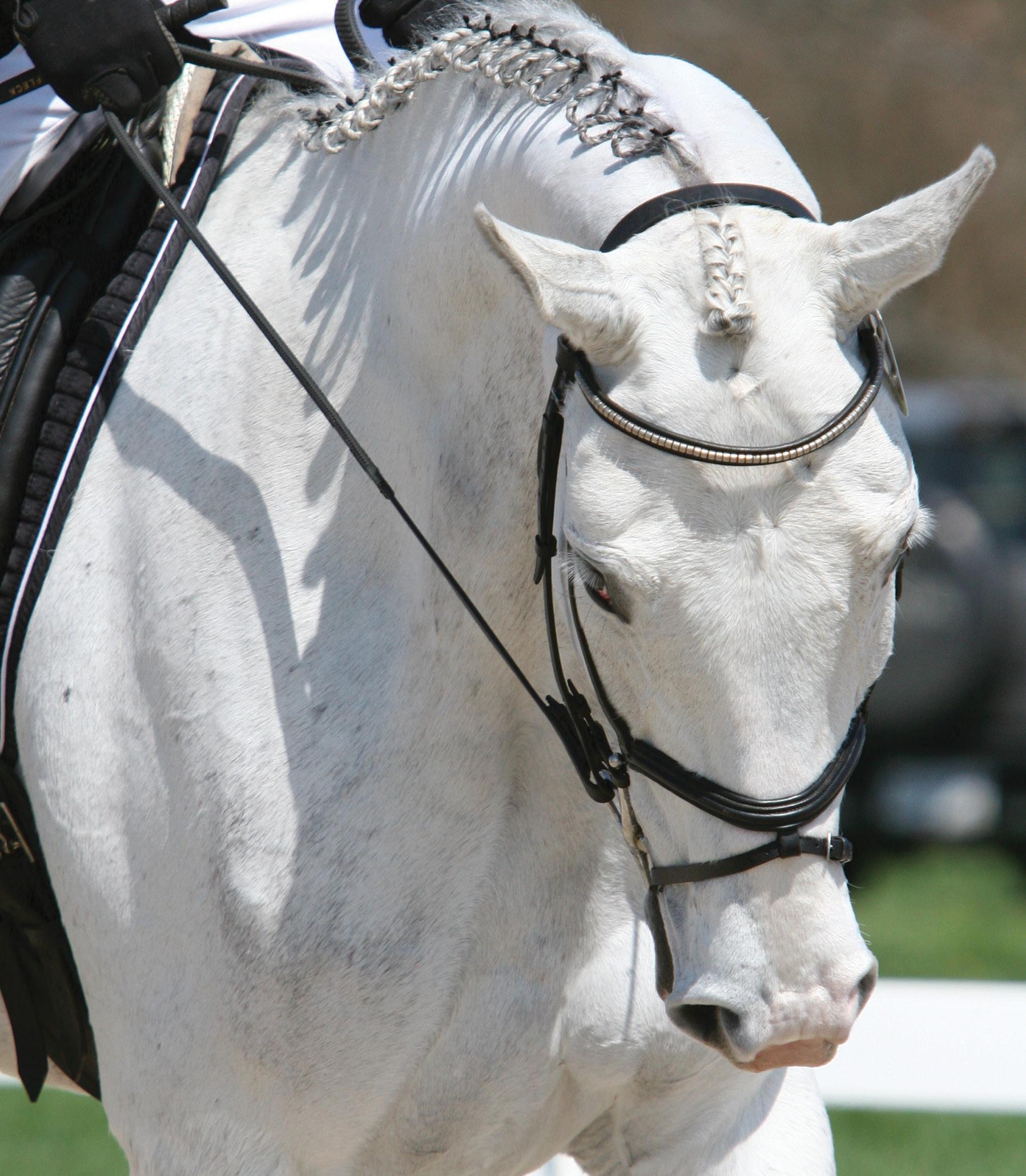
FEI Judges Advisory Group member

USEF Dressage Youth Coach
Sabine Schut-Kery
Internationally acclaimed Grand Prix rider, trainer, and instructor German Federation “Bereiter”
CHIO Wellington Team Gold Medalist
Pan Am Games Team Gold Medalist
Olympic Games Team Silver Medalist
Region 1 November 4–5
Location TBD
Region 2 September 9–10
Location TBD
Region 4 September 2–3
Providence Farms, Palmyra, NE
Region 5 September 16–17
Nighthawk Equestrian Center, Longmont, CO
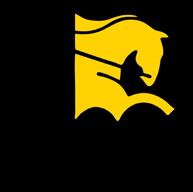
Region 9 November 18–19
Location TBD
Region 6 November 4–5
Devonwood Equestrian Centre, Sherwood, OR
Region 7 October 28–29
Starr Vaughn Equestrian, Inc, Elk Grove, CA
For the complete list of clinics scheduled for 2023, visit usdf.org
funding support provided by
YOUR CONNECTION
EDUCA TION • COMPETITION • ACHIEVEMENT
TO DRESSAGE
benefits of Safe Sport’s investigative

In light of these risks, the EB felt that it was in the best interest of USDF to suspend the program, effective immediately. Those competitors and show managers who have applied for the current year will be refunded.

Regional Championships news. As at every spring EB meeting, the following competition year’s Great American Insurance Group/USDF Regional Championships dates and locations were on the agenda. I’m happy to say that the proposed 2024 dates and locations were approved and are now posted on the USDF
USEF dressage-rules news. Kudos to the USDF Rules Advisory Working Group for its work reviewing the rule-change proposals (RCPs) potentially affecting dressage that have been submitted to USEF. RCPs are submitted by USEF staff members, USEF committees, or individual USEF members. As you can imagine, it is a lot to wade through. The working group is charged with making recommendations as to whether USDF should support a RCP—and if not, to supply a sound reasoning as to its concerns, and possibly also to show how the RCP could be redrafted to address those concerns. These recommendations and comments come before the EB prior to the RCPs’ being submitted to USEF for consideration.
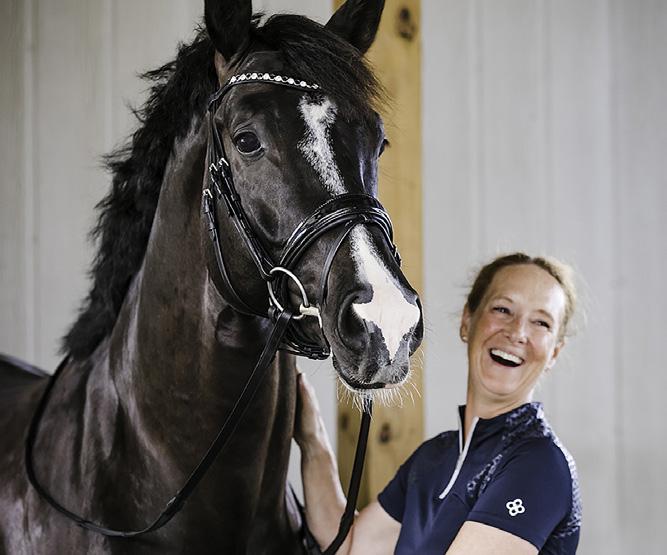
In many ways, this whole process starts at the USDF convention, during which all USDF members can learn about, and comment on, current RCPs at the USEF rule-change open forum. That opportunity is one more compelling reason to join us this fall in Omaha!
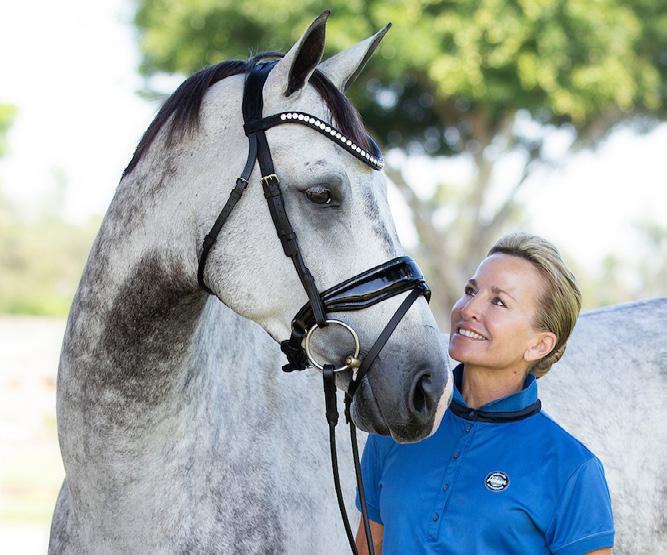
DRESSAGECOLLECTIONS.COM ~Compose your anatomic Bridle2Fit~ For information please contact info@dressagecollections.com Only The BEST Brands! Bridle2Fit • KASK Helmets • Neue Schule Herm Sprenger • Cavallo • EA Mattes Free Remote Consultations 765-341-5578
BE A 2023 PAT RON
Support the US Dressage Finals by making a tax deductible gift. Patron gifts will be recognized in the event program*, the yearbook issue of USDF Connection, and receive a commemorative gift of appreciation.
*Gifts received by October 4, 2023 will be recognized in the event program
Questions? Please email us at donate@usdf.org or call 859-971-2277.
I want to be a US Dressage Finals Patron at the following level:
o Platinum: $2500+ o Gold: $1000 - $2499 o Silver: $500 - $999 o Bronze: $250 - $499 o Friend: $100 - $249
Gift Amount: $
Please list my recognition as:
o I do not wish to be recognized.
To make an online donation please visit USDF’s secure online giving site at www.usdressagefinals.com or to donate by mail, please submit the completed form and make checks payable to USDF.
United States Dressage Federation
Attn: Senior Administration Coordinator 4051 Iron Works Parkway Lexington, KY 40511
Name USDF # E-mail Address Address City/State/Zip Daytime Phone Evening Phone

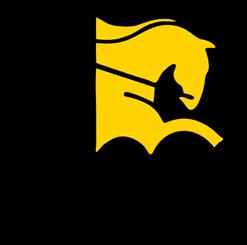







THANK YOU FOR SUPPORTING USDF Official Equine Insurance Provider of USDF Title Sponsor Great American Insurance Group/USDF Regional Dressage Championships Supporting Sponsor US Dressage Finals 800-553-2400 www.platinumperformance.com 800-303-7849 www.dressageextensions.com 402-434-8585 www.dressagefoundation.org 800-611-6109 www.dressagearena.net 800-324-2142 www.bigdweb.com 502-585-3277 sterlingthompson.com Official Joint Therapy Sponsor of USDF Title Sponsor Adequan®/USDF FEI-Level Trainers Conference Annual Convention and Awards Presenting Sponsor US Dressage Finals 800-458-0163 www.adequan.com Official Supplement Feeding System of USDF Presenting Sponsor Great American Insurance Group/USDF Regional Dressage Championships Supporting Sponsor US Dressage Finals Official Supplier Great American Insurance Group/USDF Regional Dressage Championship Jackets 800-461-8898 www.smartpakequine.com USDF Breeders Championship Series THANK YOU TO OUR SPONSORS.
Collection
Bits and Pieces from USDF and the World of Dressage
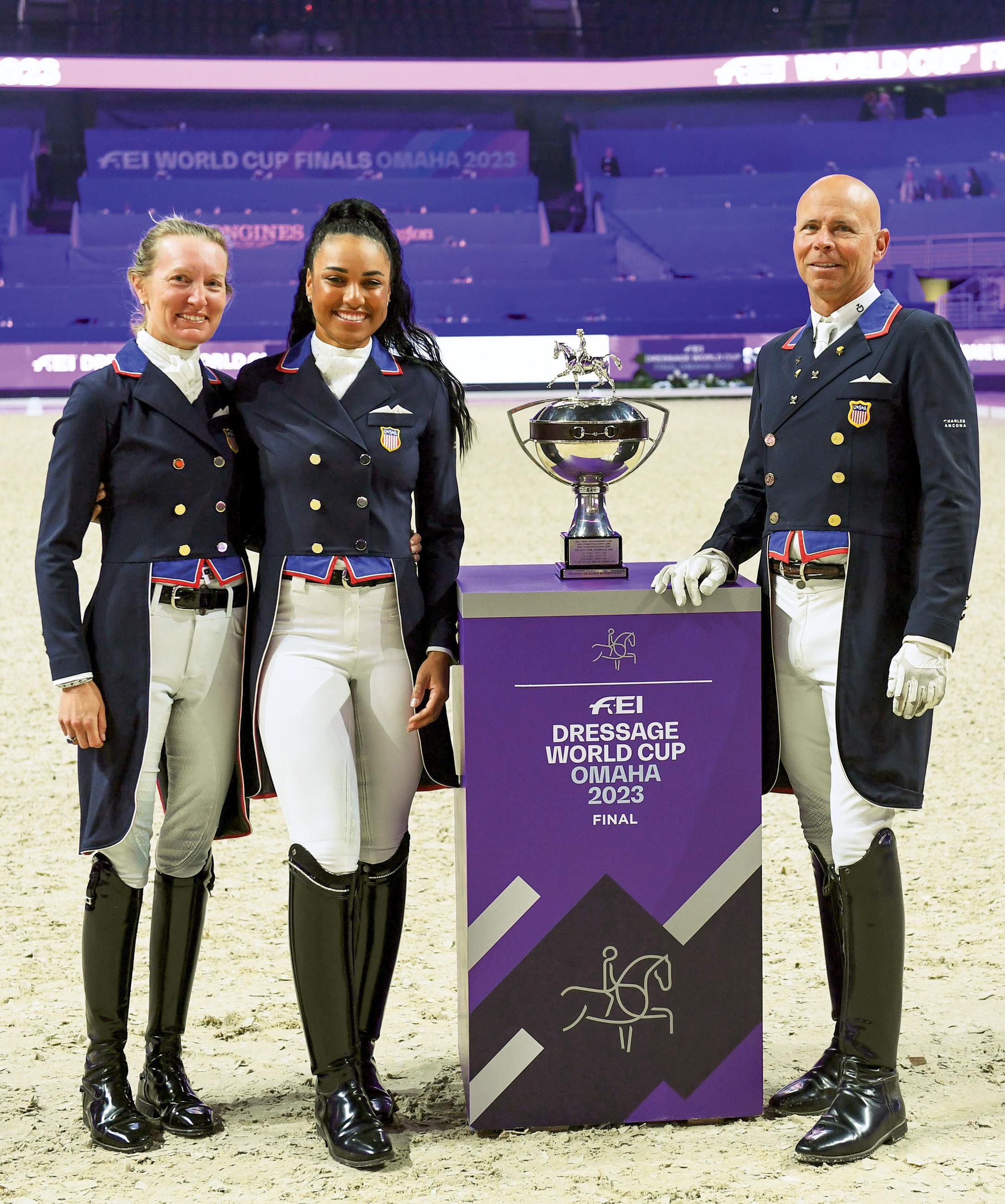
★ Remembering Carol Lavell, Dr. Margaret Mullin
★ Otterbein Dominates IDA Nationals ★
★ New Dressage Grants Salute the US Military ★
USDF CONNECTION | July/August 2023 11
ALLEN MACMILLAN/MACMILLAN PHOTOGRAPHY
IN THE FRAME
US competitors Alice Tarjan, Anna Buffini, and Steffen Peters pose with the FEI World Cup Dressage Final trophy before the Grand Prix Freestyle final in Omaha, Nebraska. Story, p. 56.
OBITUARY
Carol Lavell
Carol Lavell, of Fairview, North Carolina, and Loxahatchee, Florida, US dressage team bronze medalist at the 1992 Barcelona Olympics with the legendary Gifted, died March 27 of complications from Alzheimer’s disease. She was 79.
and 1992, and the American Horse Shows Association’s (now USEF) 1992 Equestrian of the Year. Gifted won USDF Dressage Horse of the Year titles at every level from First through Grand Prix, and he was inducted into the Roemer Foundation/USDF Hall of Fame in 1997. A later mount, Much Ado, achieved an identical run of USDF Horse of the Year titles and won team gold at the 2003 Pan American Games in Santo Domingo.
Current USDF Region 9 director Bess Bruton took her Thoroughbred, Sunnybrook, to Vermont to work with Lavell.
“Carol ran a tight ship,” Bruton recalled. “She was dedicated and disciplined, and she loved her work. She gave 300 percent of herself in her teaching and training.”
OBITUARY
Margaret Mullin, VMD
Margaret “Meg” Mullin, VMD, team veterinarian for the US para-dressage team and other disciplines, died March 9 in Florida as a result of injuries sustained in a riding accident. She was 62.

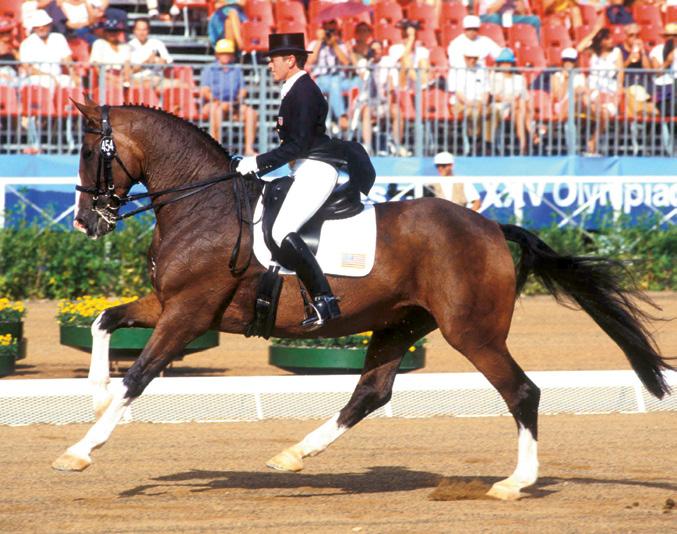
Tributes to the groundbreaking rider and noted dressage philanthropist poured in from riders, trainers, and beneficiaries across the country. Some remembered the fearless native New Englander who—under the guidance of her career-long mentor, Roemer Foundation/USDF Hall of Fame member Michael Poulin—trained the 17.3-hand Gifted from a fiery, gawky four-year-old to a celebrated performance in Barcelona. That 1992 bronze medal broke a 16-year US Olympic dressage medal drought and was a “glass ceiling” moment after which US dressage began to be respected internationally and rewarded with regular podium finishes. Others remembered Lavell as the sympathetic fellow rider and competitor who endowed or contributed to several funds at The Dressage Foundation that award grants to up-and-coming high-performance pairs and deserving adult amateurs, among others.
Lavell was the US Equestrian Team’s 1992 Whitney Stone Cup recipient, the US Olympic Committee’s Female Athlete of the Year in 1990
“I never realized at the time that I was in the midst of greatness,” Burton said, “or that I was learning from a master who gave her all. She was one of those rare individuals who made others feel worthy.”
Interviewed in 2019 for a Chronicle of the Horse tribute to Lavell, Michael Poulin—who knew at the time that Lavell’s memory was fading—spoke with a touch of anticipatory grief about his most famous student.
“She’s a ‘10’ for a person,” Poulin said. “She won’t lie to you; she won’t cheat you; she won’t take advantage. In the dressage world, there’s a tremendous amount of fakes. This is one woman who would expose the fakes if she found them.”
“What are we going to do when we lose her?” Poulin asked. “Where are the other people who have committed themselves to this discipline in a way that they haven’t sacrificed their morals or their principles? She never did. I envy her in the sense that she had a father and a husband who supported her, but I respect her for all she is and all she’s ever done. She has left a void in time that can’t be replaced.”
—Jennifer Bryant
Dr. Mullin, of Clinton, New Jersey, was a 1996 graduate of the University of Pennsylvania School of Veterinary Medicine. She spent her entire career with the practice B.W. Furlong & Associates, Oldwick, New Jersey. She was the US para-dressage team veterinarian at the 2020 Tokyo Paralympics and the Orifarm FEI World Para-Dressage Championships Herning 2022. She also served as an FEI veterinary delegate at US dressage Olympic selection trials, the Rolex Central Park Horse Show in New York, and others.
Friends and colleagues knew Dr. Mullin as a passionate polo player and jumper rider. She was riding a polo pony at a walk when it collapsed and died, leaving her in a coma with a traumatic brain injury from which she never recovered.
Both the Winter Equestrian Festival and the Adequan® Global Dressage Festival in Florida paid tribute to Dr. Mullin during competitions. The US Para-Equestrian Association (USPEA) has established the Meg Mullin Memorial Grant, funds from which will be used to help offset the costs of para-dressage athletes’ initial CPEDI competition. Learn more at uspea.org.
12 July/August 2023 | USDF CONNECTION BOB LANGRISH; COURTESY OF TINA WENTZ/USPEA Collection
FULL THROTTLE: Carol Lavell and Gifted led Team USA to dressage bronze at the 1992 Barcelona Olympic Games
TEAM PRIDE: Dr. Meg Mullin (left) with US paradressage athletes and officials at the 2022 World Championships in Herning, Denmark
Ottterbein University Wins Third Consecutive IDA Championships Title
The Otterbein University (Westerville, Ohio) team of Valerie Golden, Jenna McPeek, Emma Young, and Aubrey Dickens, coached by Jenn Roth, defended its title for a third year at the 2023 Diller Equine Intercollegiate Dressage Association (IDA) National Championships, held April 21-23 at the Virginia Horse Center, Lexington, Virginia. Twenty-six schools took part in team or individual competition.
The reserve-champion team

of Averett University was the Upper Training Level Quiz Challenge champion. Miley Holtzman of Virginia Tech won at Lower Training Level, and Lilah Ashtyahi of Rutgers University won at Intro Level.
Otterbein’s Riley Leibeck won at Upper Training Level. Shira Hadar of Florida State University was the Lower Training Level DSE champion, and Wake Forest’s Sydney Glickson won Intro Level DSE.
was Mount Holyoke College, South Hadley, Massachusetts. Emory & Henry College, Emory, Virginia, placed third.
In the USDF/IDA Quiz Challenge, Sami Scigouski of Miami University won at First Level. Breanna Gemmell

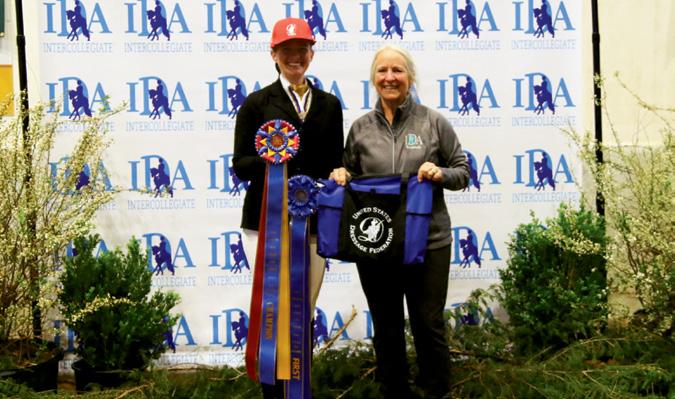
EQUINE WELFARE
In individual competition, the First Level championship went to Valerie Golden of Otterbein University. The Upper Training Level champion was Meghan Verill of Delaware Valley University. Winning at Lower Training Level was Emily Seaver of Emory & Henry College, and the Intro Level individual champion was Skylar Shaw of Emory & Henry.
The First Level Dressage Seat Equitation (DSE) champion was Molly Dwyer of Wake Forest University.
The Nationals competition is the annual championship show of the IDA, a national organization with collegiate member teams throughout the US and in Canada, whose mission is to introduce students to dressage and to offer educational opportunities and student competitions. The USDF/IDA Quiz Challenge tests students’ knowledge of dressage theory and rules. Learn more at TeamDressage.com.
“24 Behaviors” Field Guide Available as Free Download
As a follow-up to the groundbreaking research presented in the documentary film The 24 Behaviors of the Ridden Horse in Pain (“Collection,” January/February), the nonprofit organization Train with Trust Project has released The Field Guide to the 24 Behaviors, a free, mobilefriendly pictorial reference. Posters are also available for purchase.

The film and field guide are the culmination of three years of study headed by the renowned UK-based equine-orthopedics researcher Dr. Sue Dyson. Dyson and her colleagues identified 24 signs
exhibited by horses experiencing pain while under saddle. Many times, Dyson found, signs appear before a horse becomes obviously unsound.
“Providing this information as an accessible, shareable tool empowers amateurs and professionals alike to benefit the horses in their care,” said Train with Trust Project cofounder Jody Ambrose, a former Grand Prix-level dressage competitor.
Learn more and download the field guide at TrainwithTrustProject. org or 24HorseBehaviors.org.
USDF CONNECTION | July/August 2023 13 YOUTH
HIGH TIME PHOTOGRAPHY; TRAIN WITH TRUST PROJECT/ILLUSTRATION BY
MELISSA CHO
TOP TEAM: 2023 Diller Equine IDA Nationals team champions Otterbein University
QUIZ CHALLENGE GRAND CHAMPION: Breanna Gemmell of Averett University
UPPER TRAINING LEVEL INDIVIDUAL CHAMPION: Meghan Verill of Delaware Valley University
WARNING SIGN: Page from the field guide shows one of the 24 behaviors signifying pain in the ridden horse
USDF BULLETINS
All-Breeds Declaration Deadline
The deadline to declare a horse for the 2023 Adequan®/USDF All-Breeds Awards Program is August 1 Submit your horse’s breed-registry papers and a completed All-Breeds Awards declaration form to the USDF office before this date.
USDF Benefit Classes
USDF benefit classes support dressage education in the US though USDF educational programs. Winners receive special USDF awards! Ask competition management to host a USDF benefit class.
Scores Do Not Expire for USDF Horse Performance Certificates
Even if your horse earned the scores last year, you could apply for a USDF Horse Performance Certificate. Find the easy online application on the USDF website under the Awards tab. See the USDF Member Guide for complete award requirements.
USDF Awards and Resources for Breeders
Search horses by breeder on USDFScores.com.
The following resources are available on the USDF website (usdf.org):
Under the Members/Horses menu: Breeder Horse Portfolios and Dam/Sire Reports
Under the Awards menu: USDF Historical Awards Reports for breeders, USDF Breeder of Distinction awards, and Adequan®/USDF Dressage Breeder of the Year and Dressage Sport Horse Breeding Breeder of the Year year-end awards. For award requirements, see the USDF Member Guide
New Awards Resource Guide Available
The new USDF Awards Resource Guide includes information on all of the recognition opportunities available to USDF members in an easy-to-navigate format. Check it out under the Awards menu on the USDF website.
Check Your Scores
Check your scores on USDFScores.com. If you spot an error, e-mail scorecorrections@usdf.org or call (859) 971-2277. Score corrections must be reported by October 15 at 5:00 p.m. ET.
Are You Qualified for
Regionals?
Check the Regional Championship Competitors page on the USDF website to verify that you’ve qualified for the 2023 Great American Insurance Group/USDF Regional Championships.
Qualify for the Regional Adult Amateur Equitation Program
To qualify for a USDF Adult Amateur Equitation Regional Final class presented by Big Dee’s Tack and Vet Supply, a competitor must either 1) earn a score of 70% or above in an applicable dressage-seat equitation class, or 2) qualify at any level (excluding freestyles) for the Great American/USDF Regional Championships.
A USDF Adult Amateur Equitation Regional Final class will be held in conjunction with each of the nine Great American/USDF Regional Championship competitions.
Planning to Compete at the US Dressage Finals?
Visit USDressageFinals.com as you begin your preparations to compete in the 2023 US Dressage Finals presented by Adequan®. The prize list is now available online, and declarations are open. Horse/rider combinations must declare their intention to participate by completing the Declaration of Intent form by midnight on the day prior to the first day of their Regional Championship competition (including any open class day before the start of championship classes). There is no fee to declare, but horse/rider combinations must declare at the level(s) and eligible division(s) in which they intend to compete.
PHILANTHROPY
Freestyles for a Cause
After three successful years hosting its Divertimentos & Dressage fund-raising event in the Carolinas, Brooke USA brought its evening of dressage freestyles set to a live orchestra to Florida in March.

Brooke USA ambassadors the FEI-level dressage competitor JJ Tate and the World Championships para-dressage medalist Rebecca Hart, plus 2010 US World Equestrian Games dressage competitor Todd Flettrich, Israeli athlete Sahar Daniel Hirosh, and US FEI-level competitors Jim Koford and Allison Kavey, rode their freestyles accompanied by the Palm Beach Symphony.
Vinceremos Therapeutic Horsemanship Center, Loxahatchee, Florida, hosted the event, which was part of Brooke USA’s “Paint Wellington Orange” campaign. The nonprofit organization works with individuals, groups, and organizations to help ensure that working horses, donkeys, and mules in developing communities worldwide receive adequate care and humane living and working conditions. Learn more at BrookeUSA.org.
14 July/August 2023 | USDF CONNECTION JOANNA JODKO/COURTESY OF BROOKE USA Collection
SUNSET SYMPHONY: Brooke USA ambassador JJ Tate performs at the Florida Divertimentos & Dressage event, presented by Lugano Diamonds
GOVERNANCE
Griffin, Roberts Promoted to Key USEF Positions
Longtime US Equestrian (USEF) dressage managing director Hallye Griffin has been named USEF director of FEI sport, USEF, Lexington, Kentucky, announced in March. Promoted into Griffin’s former position is Laura Roberts, who had been USEF’s director of dressage performance and event support.
Griffin assumes the role previously held by Graeme Thom, whose title was USEF director of FEI/ high-performance sport. Thom’s tenure was shortlived: Hired by USEF last October to replace USEF director of sport Will Connell, who stepped down in November, the former Canadian eventer resigned in March, citing “evolving personal obligations.”
FINANCIAL AID
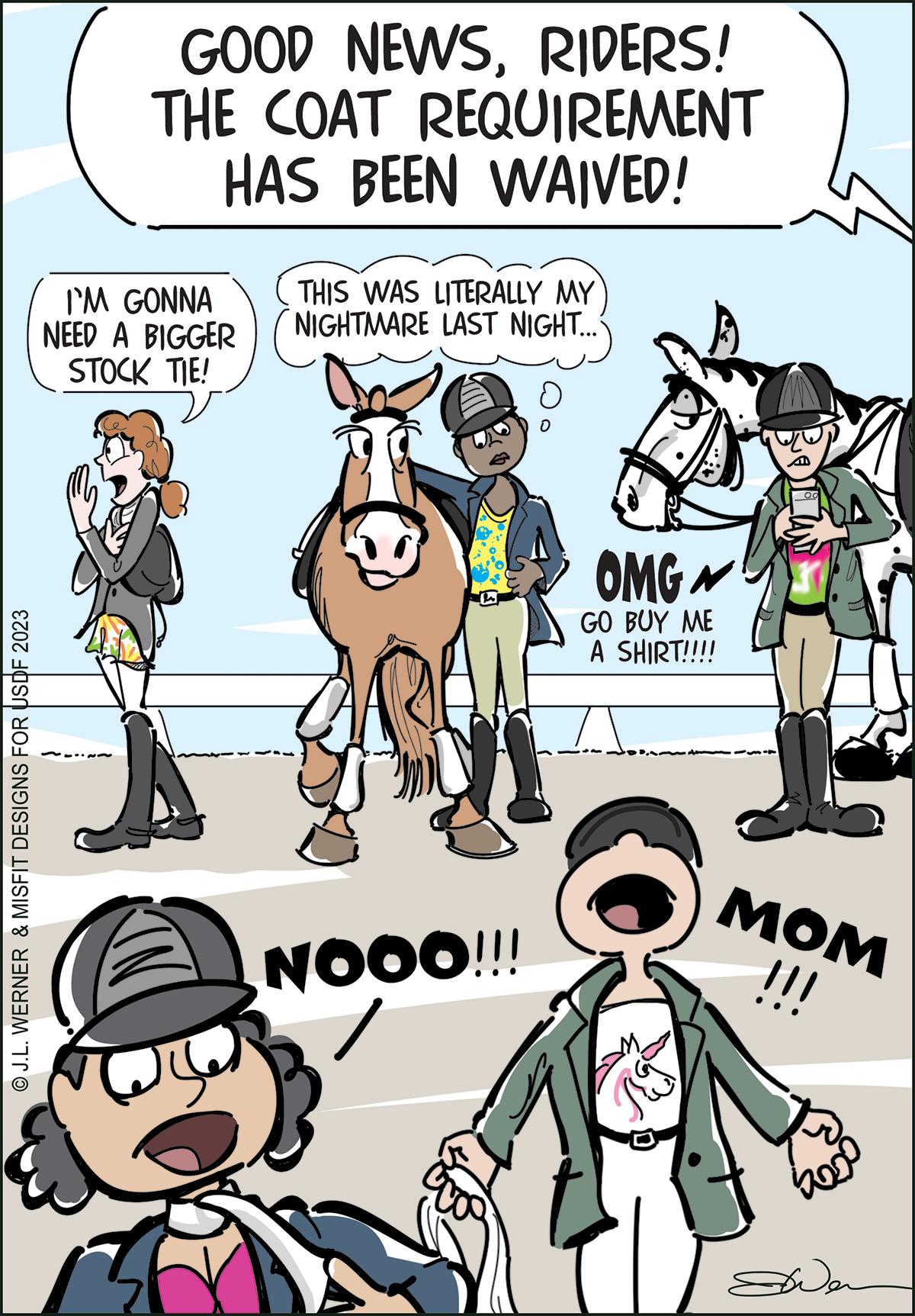
New TDF Grants Salute the US Military
Colonel David and Sue Bender, of Beech Island, South Carolina, have established a Military Grant Fund at The Dressage Foundation (TDF) to aid US military members and their dependents in their dressage training.
During Col. Bender’s 28-year Army career, he and his family were posted to bases worldwide, including Germany, where his wife, a longtime amateur dressage rider, wrote about her equestrian experiences for USDF Connection. Sue Bender is a former USDF Region 3 director and a longtime Region 3 FEI North American Youth Championships chef d’équipe who in 2017 was honored with the Albers Award for her contributions as chef.
The Military Grant Fund is open to all branches of the military to include active duty, reserves, and veterans. Amateur and youth riders, including para-dressage riders, are welcome to apply. Learn more at DressageFoundation.org.
A Kentucky native, Griffin joined USEF as director of national dressage programs in 2011 and had been its dressage managing director since 2015. She served as team leader for US dressage, vaulting, and para-dressage teams at two Olympic Games, two World Championships, and several Nations Cup events and national championships, among others. In her new job, Griffin will work closely with David O’Connor, the US Olympic eventing gold medalist and former USEF president who last fall was named USEF chief of sport.
Laura Roberts has a wide range of experience in sport organizations, having worked for US Figure Skating and USA Karate, including at the 2018 winter Olympics. During her five years with USEF, she has served as team leader for the US dressage squad at the 2019 Pan American Games and for several dressage Nations Cup teams at the youth and senior levels.

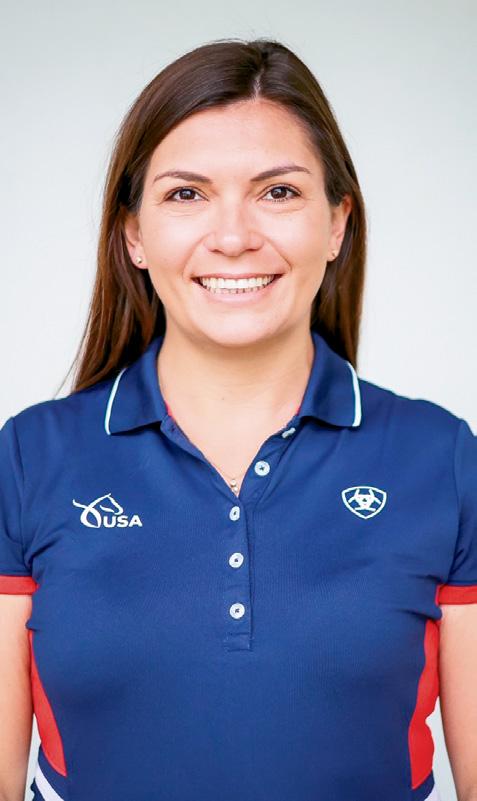
USDF CONNECTION | July/August 2023 15
THE NEAR SIDE
PROMOTED: Newly appointed USEF director of FEI sport Hallye Griffin (left) and dressage managing director Laura Roberts
Muscle function is key to top performance
Rhythm, relaxation, connection and impulsion are the goals of every dressage rider. It takes adequate fitness, careful training and a healthy muscle function to achieve these goals. Poor muscle development, lactic acid build-up and a lack of antioxidant reserves can leave a horse unwilling to go forward and lacking in stamina during training, followed by stiffness and soreness after work.
As horses are asked to work harder, antioxidant requirements and lactic acid levels increase in muscle cells. Short-term deficits in antioxidants such as vitamin E and selenium can result in training difficulties, and long-term deficiencies can lead to poor muscle development and even neurological deficits.
Supplying the nutrients needed to support healthy muscle function is the key to successful development of a dressage horse. Essential nutrients such as natural vitamin E, selenium, chromium and B complex vitamins support muscle development and functionality.
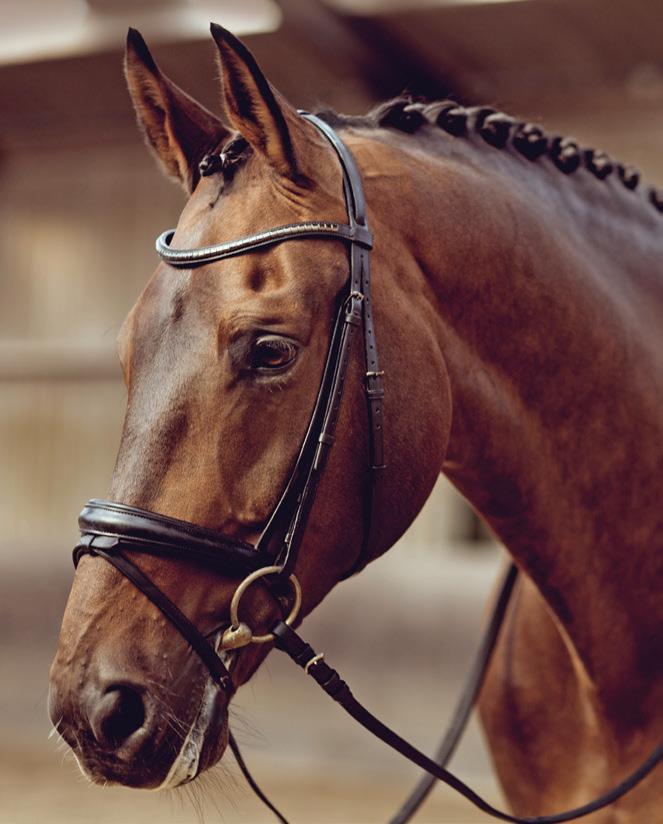
Natural vitamin E and selenium are the most powerful antioxidants utilized by the equine muscle. They work together to reduce oxidative stress that impairs cellular function. This reduces the incidence of stiffness and soreness. Horses with adequate antioxidant reserves develop faster, have more stamina and fewer muscle disorders, and can also have less mental anxiety caused by fatigue and sore muscles. Horses are happier and more willing to work.
Chromium has been shown in studies to help exercising horses clear glucose faster, and it supports lower levels of lactic acid in muscle. Lactic acid hastens fatigue. Lower lactic acid levels improve stamina. Exercise increases a horse’s chromium requirements. In particular, horses with a history of RER (tying up) can benefit from supplemental chromium.
Horses in training can also benefit from additional B complex vitamins. Horses in light work and at rest synthesize enough B vitamins in their guts to meet their requirements. Hard-working horses that are under the stress of training and competing may not be able to meet their requirements on their own. Additional supplementation ensures increased needs are met.
Supporting heathy muscles in the dressage horse is one of the main keys to success when developing a top performer.
levels
vitamin E as d-alpha-tocopherol 2000 IU to 5000 IU per day
selenium 1 mg to 3 mg per day in total diet
chromium 5 mg per day Simple Solutions, Scientifically Proven ® Paid Advertisement
Nutrient Suggested
for horses in training Natural
Organic
Organic
Your Goal: Support optimal muscle function
Your Program:
• Achieve rhythm, relaxation, connection and impulsion

• Develop appropriate level of fitness
• Maintain physical and mental health
Your Supplements:
Elevate® natural vitamin E


• An essential antioxidant that supports healthy muscle, nerve and immune function.
Elevate® Se
• A combination of natural vitamin E and organic selenium that supports healthy muscle function at times when both vitamin E and selenium are required.
Metaboleeze TM

• Maintains hard-working muscles by supporting optimal muscle metabolism and lower levels of lactic acid.
• Supplies B complex vitamins, trace minerals and organic chromium.
Simple Solutions, Scientifically Proven®
Got questions? Contact us: KPPusa.com, 859-873-2974
USDF Connection Satisfaction Guaranteed.
Clinic CONVERSATIONS ON TRAINING Immersed in Horses
A lifetime pursuit of the basics brought Sweden’s Tinne Vilhelmsen Silfvén to seven Olympic Games
By Beth Baumert
Seven-time Swedish Olympian Tinne Vilhelmsen Silfvén is always a serious competitor at the Adequan® Global Dressage Festival. The Stockholm native, 56, has also competed at six FEI World Equestrian Games, seven FEI World Cup Dressage Finals, and eleven European Dressage Championships with such well-known mounts as Don Auriello and Benetton Dream. Silfvén was among the “early adopters” from Europe to travel to
her longtime trainer, four-time Swedish Olympian Louise Nathhorst, for a wide-ranging conversation on becoming a dressage professional, how she brings horses up the levels, and why every serious student of dressage should spend time being a railbird.
Beth Baumert: How is the Florida dressage scene different from Europe?
Tinne Vilhelmsen Silfvén: You don’t spend your time here in the
days to even get to most shows. It’s nice to be here and not have to travel at all. Especially for young horses, it’s wonderful that they’re not tired when they arrive at the show.
On the other hand, many things are the same. There are almost the same very good judges here and in Europe. And this arena [at the Global Dressage Festival] has an international touch. It’s not an easy arena to ride in, but it’s good training for young horses.
On the national side, it’s quite different. In Europe, a national show is quite a big deal, with sponsors and prize-givings, whereas here there might be only one judge, even for the Grand Prix, and there are no prize-givings. There’s less status to winning here in Florida, and you can ride Grand Prix every day if you want to, so that’s good. In Europe, it is quite a statement to win a national Grand Prix.
Here in Florida, we see a lot of young people who are starting their careers as dressage trainers. What advice do you have for them?
Florida for the winter circuit, and since 2011 she has been a familiar face in “Welly World,” when she’s not at home working as the head trainer of the Swedish sport-horse stud farm Lövsta Stuteri.
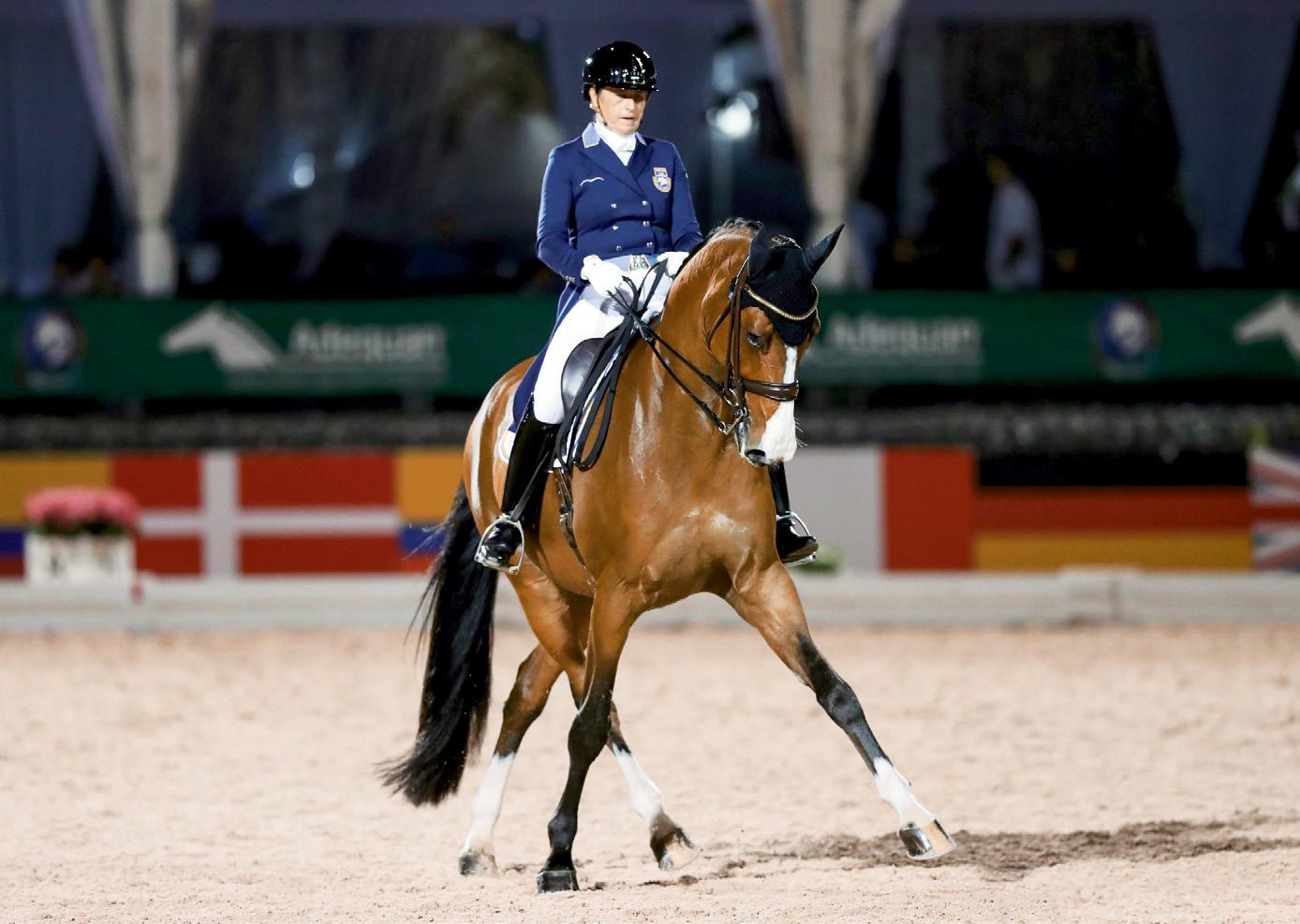
I met up with her in Florida during the 2023 winter season along with
same way as you do in Europe. Here, everyone competes at the show and then goes home to ride or teach, and then they come back to the show. At a big show in Europe, riders hang around the show, and it’s more of a social event.
From Sweden, it takes us three
If young people want to be successful, they really need to see the whole picture—by living with horses, not just riding. They have to learn everything about the horse and about the world that he lives in. What does he eat, and how does that meet his nutritional needs? What does he need from the blacksmith, and how often does he need it? There are countless aspects to his health and training. The feeding and the mucking out gives so much knowledge about the horses. The turnouts and the hand-
18 July/August 2023 | USDF CONNECTION SUSANJSTICKLE.COM
GLOBAL ACCOMPLISHMENTS: Swedish Olympian Tinne Vilhelmsen Silfvén rides the 2009 Grand Prix Holsteiner gelding Devanto (De Chirico x Lorentin) in Florida in 2023
walking, getting them out of the stable enough times each day. You have to know the whole history of your horse. Some people don’t have the time to live horses fully, but they somehow still have to learn that part to become a good rider.

Why is that so important?
It helps you understand the horses’ needs, and helps you understand the reasons why things happen. When you really know your horse, you can make him happy. You know how much you can ask without asking too much. At the same time, you have to ask for something—otherwise you don’t get anywhere!
How do young professionals start in Sweden?
In Sweden it’s a bit different because the kids go to riding schools, and they live at the school. They live at the stable, taking care of the horses, grooming them, feeding them, and caring for their veterinary needs. Then when they get their own horses, they understand the whole picture. Being with the horse is just as important as riding him. We live for our horses, and it’s a privilege to be able to be with them.
How did you achieve your early training?
I lived that life for four and a half years with Walter Christensen in Germany, where I was surrounded by other riders, seeing the whole picture of how horses live and train. After those years, I trained with Louise [Nathhorst], who was also Christensen’s student. Many riders don’t have a clue about those things that I learned from Christensen.
You can only get that by being in the culture of a quality professional stable.
Exactly. Maybe not everyone can do what I did, but they still need to gain that knowledge about how horses work—every aspect of every age. For example, in the training, even
USDF CONNECTION | July/August 2023 19
if you’re riding a Grand Prix horse, it’s important that you know how to ride a young horse. You’ll ride your Grand Prix horse better. We have students who are riding a schoolmaster at Prix St. Georges or U25, and they have no idea how to ride a young horse.

I’m fortunate that Walter Christensen was my first real dressage trainer, because he came to New England regularly in the early days of dressage in the US. And Louise came too. When you think back to your days with Walter, what stands out?
The respect for the horse, and he was into every detail. If there was a problem, it was always the rider, never the horse. He was an extremely good educator of riders in understanding the basics. With him, you understood that you must have this in the beginning in order to do that in the end.
I remember Christensen would always say, “Ruhe, ruhe—Quiet, quiet,” and that set the atmosphere for the ride. Yes, he had huge respect for the horse all the time, and he really understood the steps from the start to the end. He was better at teaching the basics than teaching how to compete a horse.
Who taught you about competing? Louise and I went to [the late German dressage master] Herbert Rehbein after Christensen, and he was very different. He could get any horse to do everything, and he was the master of showing and competing. Rehbein was good at hiding the faults, while Walter taught us to retain the basics from young horse to Grand Prix.
How would you describe those basics?
You don’t cut any corners. You do everything exactly as you should, and give each horse the time he needs to learn what he needs to learn. We learned to work on the basics every day. That simply means that if something goes wrong, you go back to a more basic concept and regain the relaxation and throughness before you go on again.
That always involves transitions and soft riding until the horse is between your aids and you can ride him straight forward.
Please tell me more about riding transitions.
Transitions are within the gaits and between the gaits, and you do them all the time and forever—up and down— until you can think them and the horse understands and reacts exactly the way you want. The horse almost thinks it before you, but he doesn’t do it before you! It’s about training the routine until your horse can “hear your mind” when you think it.
Transitions within the canter can greatly improve the quality. If you play with the size of the steps—
make them bigger, smaller, flatter, higher—you will find the rhythm and speed [tempo] that is the best for your horse. It is common to focus only on collecting, which usually results in smaller steps with insufficient energy.
The story of the value of transitions stays the same throughout the whole journey from a young horse to Grand Prix.
Can you talk more about how that evolution happens?
You start with very few signals with the young horse so they understand. If you give them too many at the same time, they mentally go away from you and don’t listen any more. When that happens, less-experienced riders start to do more and more, and then the horse has no idea what you’re saying. You have to keep it simple, and you shouldn’t need strength.
The more educated the horse gets, the more you can start to combine your signals, and the horse understands. Later, you can add power because they read you easily. If things get complicated, you go back to easy work. Then, when the horse understands again, you can combine signals again.
That’s actually the answer to a question I was going to ask. You’re very good at adding power without getting tension. How do you accomplish that?
Tension will always creep in, sometimes because of a distraction from the outside, and sometimes from inside—the horse’s temperament.
What do you do when the tension comes in?
You go right back to transitions with simple signals until your horse listens to you again. You, the rider, must be more interesting than whatever is distracting the horse.
How do you make yourself interesting to the horse?
The transitions are interesting—play-
20 July/August 2023 | USDF CONNECTION JENNIFER BRYANT
Clinic
LONGTIME PARTNERSHIP: The Hanoverian gelding Don Auriello (Don Davidoff x White Star), shown at the 2018 FEI World Equestrian Games in North Carolina, was also Silfvén’s mount for the 2012 and 2016 Olympic Games
ing with the speed or with the size of the stride until the horse focuses on you again. You can’t scare a horse into listening to you. Change small things all the time, even when you ride around the arena before entering at a show. Remind your horse to stay with you by changing little things. We could go into technical details, but the basic story is very simple.
Do you have a short- and longterm plan for each horse? Having been to seven Olympic Games, I’d say you’re probably very wellversed at the long-term schedule! Yes. I have a weekly, monthly, and yearly education schedule for each horse, but it’s easy to get caught up in the everyday. Every horse is a new adventure, and you start each from a humble beginning until you understand how they work and how you will collaborate with them. The bigger your toolbox, the easier it is to find your way.
Can you say a bit about warmup?

During the warmup, you try to get the best communication possible. Then when your horse is on the aids, you can do the difficult things for sure. The horse I’m riding now has a tendency to get worked up, so I do a lot of walk transitions. If I were to work him in trot and canter, he’d stay tense and also get tired. I walk a bit and jog a bit to get the level of tension that I want him to have.
Please talk about the concept of positive tension.
Positive tension is what you want. It’s what makes your horse ridable, and the most difficult thing in competition is to get the right amount of positive tension, so you have expression as well as ridability.
Do you have any advice for the riders at home who are working to improve?
I think using video helps. When Louise is training me, I understand
exactly what she is saying; but then when I see the video, I understand on a different level. It helps to use all these tools to help us improve. I watch [British Olympian] Carl Hester’s commentary on ClipMyHorse. tv. It’s very educational, and Carl is another who is into the details.
Also, try to keep your horse at a place where there are other good riders to watch, have fun with, and discuss things with. You can learn so much from watching others and getting good help. And whatever level you are working on, you always want someone around you who is better than you. Ask questions and take help from a good rider. Talk about riding techniques, and have an open mind. Louise and I are always talking about how this or that rider is solving a problem. We watch and say, “Maybe we could try that!” or “I would not do that.” There’s good and bad, but we have the discussion.
In general, people who want to learn don’t spend enough time
Meet the Expert
Beth
Bau-
mert
is a USDFcertified instructor/ trainer through Fourth Level, a USDF L program graduate with distinction, and the author of When Two Spines Align: Dressage Dynamics and How Two Minds Meet: The Mental Dynamics of Dressage. She is the current president of The Dressage Foundation. For many years she owned and operated Cloverlea Dressage in Columbia, Connecticut, and served as the technical editor of Dressage Today magazine. She divides her time between Connecticut and Florida.

watching the warmup at shows. It’s free. It’s very educational.
However, while I say to watch others, you have to learn one system first.
Yes! Watching others is valuable to you because you have such a strong foundation in what has become your own system. Yes. We take input from others, but we follow our own line of thinking. I’ve developed a system, and I could never now start a new system. If you ride with ten different trainers, you never get your own system. You have to decide what trainer you want to learn from and develop a solid foundation with that trainer.
Finally, riders have to accept the fact that training comes with ups and downs. That’s how it goes. It’s like life.
USDF CONNECTION | July/August 2023 21
Merry Christmas!
Have you ever gotten an overly generous score from a “Santa Claus” judge? It feels great at the time, but here’s why inflated marks are actually a detriment to the sport of dressage
 By Marilyn Heath
By Marilyn Heath
Adressage competitor recently complained to me that there must be something wrong with the judging at certain shows. As compared to her previous competition experiences, she thought that the judging at Great American/USDF Regional Championships and the US Dressage Finals was way too tough.
strive to maintain the highest standards of the sport. Judges play a critical role in this process. Being a dressage judge is a huge responsibility. Judges are called upon to judge fairly and consistently throughout the class, throughout the show, and from show to show. Judges must not change their standards from show to show, whether it’s from schooling
their own. Judges want to be hired— and rehired. So in order to become “popular,” a judge may develop a more generous scoring range, rewarding poor training or riding with higher-than-expected scores.
Giving out high scores makes a judge popular with riders, and judges who are popular with riders become popular with show management. Show managers strive to keep competitors happy so that they will attend their shows and perhaps bring their students with them, so generous-scoring judges are often hired. I have even heard of trainers’ telling show management that they will not bring their students unless a certain high-scoring judge is hired, or that they will not attend with their students if So-and-So is the judge. In addition, riders seeking high scores may avoid “unfriendly” judges and may influence management to hire so-called “Santa Claus judges.” All of this is not always in the best interest of the sport or the horse.
I gave that idea a lot of thought and came up with some ideas that I would like to share.
There should be only one judging standard. Judges encourage all competitors and trainers to regard every dressage test as an evaluation of how well they currently are satisfying the purpose of the level being shown. We hope that you will regard showing as part of your dressage training, not simply as a means of qualifying for Regionals or Finals or of earning awards.
All dressage enthusiasts should
show to recognized show, from local recognized show to Regional Championships, or from Regional Championships to the US Dressage Finals or the US Dressage Festival of Champions. They also must not adjust their scale when judging separately or on a panel.
So where does the “Santa Claus” phenomenon come from? Becoming a licensed dressage judge is a lengthy and expensive process. Graduates of a training program, be it the USDF L program or the USEF/ USDF “r,” “R,” or “S” programs, are on
A rude awakening? It has become fairly easy to qualify for Regional Championships, especially if a rider cherry-picks shows with high-scoring judges. But then, at Regionals, riders have to show in front of a panel of judges, and the scoring may seem more conservative by comparison. The result is that riders may be discouraged by their scores at Regionals, or they may make it to the US Dressage Finals only to be disappointed there. It is no wonder that some riders get confused and frustrated, and assume that there is something wrong with the judging.
A singular standard is fairest to all. For the good of our sport and our horses, judges need to adhere to the
22 July/August 2023 | USDF CONNECTION ILLUSTRATION
FOR
CONNECTION
BY JODY WERNER
USDF
The Judge’s Box
GIFT SCORE? Overly generous judging may be doing dressage a disservice
standard that they have been taught in judge-education programs. Show management should hire judges who are fair, consistent, and realistic. And competitors should patronize shows that hire judges who give an accurate, honest, fair evaluation of their rides while offering constructive and helpful comments.
When a rider thanks a judge for a good score, the response should be, “You earned it!” It is essential for judges to judge to a standard while providing helpful comments that analyze how well the ride fulfilled the purpose of the level as stated at the top of each test sheet, and scores that reflect the correctness of the training.
What’s the solution? Where are we going with our sport of dressage? What is the best way to address discrepancies in judging standards?
Some in the sport believe that all dressage tests should be judged by a panel. To do so would require more judges and more scorers. Those additions would result in increased costs, which would be passed along to competitors in the form of higher entry fees, resulting in unhappy competitors. But somehow panel judging is the norm at European dressage shows, at least above Second Level. How do they afford that? I am told that judges at European dressage shows are paid very little. Surely that would make panel judging more affordable in this country.
Is that the issue, or is it that riders feel that judging is more severe when there is a judge on the side? If the latter is the case, would it not be a good idea to more often have a judge on the side to prepare riders better for such competitions as Regionals and Finals? As judges and experienced competitors know, the view from the side is very different than the view from C, with side judges able to discern aspects of the test that are less apparent from C. It would be good preparation for riders if panel judging became the custom in the US as it is in Europe.
Toward a higher standard. Whatever your role in the sport of
dressage—competitor, instructor/ trainer, judge, show manager—we are all in this together, and we share a common goal: to train our horses to be the best they can be. A dressage enthusiast is always working to maintain the highest standards of the sport!
USEF “S” judge Marilyn Heath, of Venice, Florida, is a longtime USDF L Education Program faculty member and a member of the USDF Judges and L Program Committees. She received the USDF Lifetime Achievement Award in 2013 in recognition of her contributions to the development of the L program and to promoting excellence in dressage judging in the US.
offers a resource library, online courses, recognition for USDF members who strive to continue their education, and accreditation for educational events.
•Search the education library
•Take online courses
•Earn credits and recognition
USDF CONNECTION | July/August 2023 23
UNIVERSITY
USDF UNIVERSITY
www.usdf.org/education/university
Sport Horse
Online Shopping
How to evaluate sale-horse videos—plus what to look for if you decide on an in-person visit
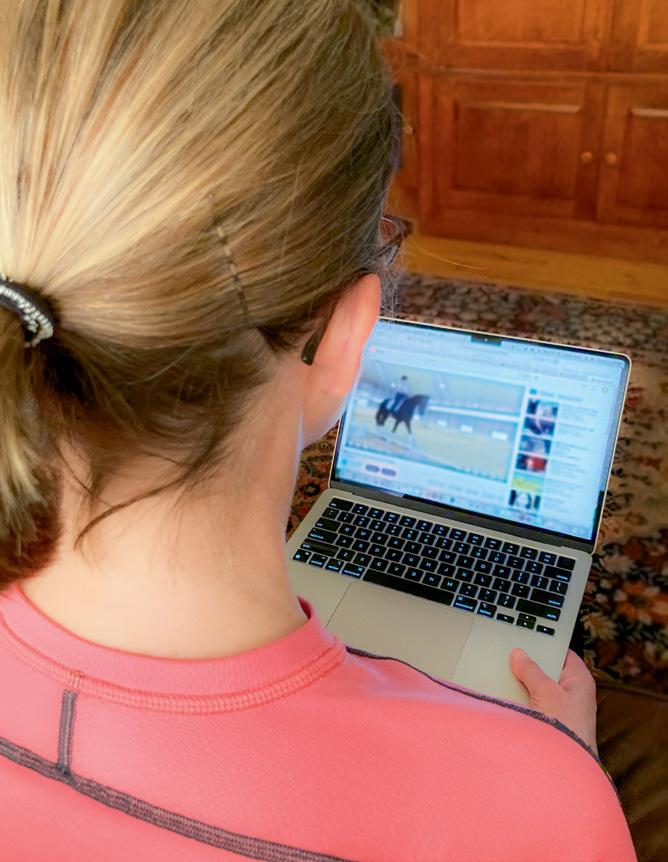 By Patti Schofler
By Patti Schofler
The video of a sale horse is akin to the opening chapter of a book. Both can provide enough information about the main character for you to evaluate whether continuing on is worth your while. To the savvy shopper or reader, these introductory pieces also offer a glimpse of what the future may hold.
want to view video before they spend the time and money to travel to see a horse. With video serving as the deciding factor in such important decisions, buyers want to learn to evaluate videos as thoroughly and accurately as possible. We asked three experienced dressage professionals to share their insights.
First Impressions
When you watch a sales video, start not with the horse but with the rider, says Meaghan Byrne, of Browns Summit, North Carolina, a USDFcertified instructor/trainer through Second Level and an assistant professor of business administration at Averett University.
“Is the rider a six-feet-five male and a beautiful rider, and I’m shopping for a five-feet-two, frail woman who’s new to dressage?” says Byrne. “Since many of us represent an amateur or junior, some of the best sellers show a video with a nonprofessional on the horse.”
work for the level and age advertised.
“If the boxes check off with the first video, I’ll reach out for more information—maybe for a video of the horse at a show, getting groomed, being tacked up, the rider mounting the horse,” says Newcomb, of Camarillo, California, a current member of the Kundrun USEF Dressage Development Program and a 2021 recipient of The Dressage Foundation’s $25,000 Carol Lavell Advanced Dressage Prize. “The more information you can get to see the whole picture as opposed to little snapshots that highlight the best qualities of the horse, the more of an educated picture you have.”
A Deeper Dive
Every buyer wants to know about the horse’s temperament. Assessing temperament from a video is possible, says Newcomb, but it takes some study.
A sales video offers the viewer a first impression of the horse and a chance to evaluate its conformation, soundness, training, and confidence level. It also helps the shopper to assess the quality, purity, and freedom of each gait, of course, although video footage may not reveal the horse’s true energy and power. At best, video can show the horse’s potential and provide enough information for the prospective buyer to decide whether to take the next step.
Nearly all horse-shoppers today
When she’s looking for a lowerlevel dressage horse, Lisa Weis just wants to see trot and canter in both directions and the free walk. Movements at this level are not significant, says Weis, a USDF-certified instructor/trainer through Second Level and an L graduate with distinction from Arlington, Washington. An upper-level horse is a different story, however, and any video advertising an FEI-level horse for sale should show all the movements of that level, she says.
When Amelia Newcomb watches a sale video for the first time, she’s looking “to assess the quality of the gaits, the horse’s conformation, the outline of the horse, if it looks sound, and if it’s doing appropriate
“A good temperament is the number-one thing I look for when purchasing a horse. While it’s hard to assess temperament from a video, there are things to look for,” she says. “Are the ears forward, or are they pinned back when the rider asks for something? Is the horse swishing the tail? Does the horse look supple, relaxed, and confident? If the horse is misbehaving or looks unhappy or tense or distracted, he’s probably not the horse for you. If he looks that way with his home rider on video, he will likely be worse when you get him home.”
As you watch the video, look to see if there’s any activity in the background, and if so, how the horse is reacting. “If the horse is doing a free walk, how quiet is he? If the horse is
24 July/August 2023 | USDF CONNECTION
MICHAEL BRYANT
VIRTUAL TRY-ON: Video of a sale horse can offer many clues as to whether it’d be worth your while to go see it in person
relaxed with things going on around him, that’s a positive sign,” says Weis.
Newcomb notes that “Horses with big, extravagant gaits are harder to ride and generally are hotter and spookier. While they might look impressive on the video, they’re much more difficult to ride. It’s important to find a horse that is suitable and you are confident with.”
What’s Shown—
and What’s Not Shown?
When you watch sales videos, be aware that the footage may have been edited to highlight the horse’s good qualities and downplay weaknesses or mistakes. For example, a video might only show the walk, trot, and canter down one long side and edit out the transitions.
However, even in such situations “I’ve rarely seen that the seller is being devious,” says Weis. “They might cut out footage of when the horse lost his balance in the corner or cross-cantered, or leave out the half-pass in the other direction.” If something is missing from the video that you want to see, she advises, “ask the seller to make a video of what was cut out.”
If the horse you’re evaluating is advertised as having a show record, ask to see uncut show video. Competition footage is great for showing the horse in an unfamiliar setting, performing at the level he’s advertised as competing at. You may get the opportunity to see how he reacts to outside stimuli, such as traffic going by, or to flapping banners or to puddles or sloppy footing.
Today’s sales videos may feature additional types of footage, as well, typically to bolster prospective buyers’ confidence in the horse’s temperament and ground manners. Some sellers routinely include footage of the horse being groomed, tacked up, led out of the barn, and mounted. Some videos even feature the horse walking over tarps or reacting calmly to flags or other “desensitizing” props. If you
BEHAVIOR TEST: Safety while mounting is paramount, and some sellers even include mounting footage in their sales videos to demonstrate horses’ ground manners

have particular concerns, such as whether the horse allows his feet to be handled or is OK with clippers, ask the seller to shoot a quick smartphone video of that activity. Most sellers are happy to oblige for a serious buyer, especially if the purchaser may be making the decision to buy without traveling to see the horse.
Which brings us to the next big question:
Should You Buy
Based on Video Alone?
Byrne has purchased unstarted youngsters straight from videos. Her rationale:
“With a very young horse, there isn’t much you can do other than meet the horse and see if there is an emotional connection. With a vetting that you trust and have sent to your vet, I think it’s OK and responsible.”
There’s a big but to that statement, however.
“If the buyer is an adult amateur or junior and this will be her only horse,” Byrne adds, “I always encourage one or two rides before making a decision. It is too much of a risk.”
Although some of Newcomb’s clients have bought horses sight unseen and were happy with the
results, she herself doesn’t do it, saying, “I always like to ride the horse in person because the seller can definitely hide things on the video.”
Our experts agree that the feel of a horse doesn’t necessarily come across on video, and that an important element of matching horse to rider—the chemistry between the two—can only be determined in person. They also point out that a horse can be presented so well in the video that the in-person test ride doesn’t feel as if it could be the same animal.
“A pretty good rider has the horse well presented, and then it’s not the same when you sit on it,” says Weis. “That’s why it’s important for the rider to try it. It’s not that the rider has masked a situation, but that the ride is about feel and matching the rider to that horse.”
If You Decide to Go See the Horse
By evaluating video, photos, and possibly radiographs—and, of course, having a detailed chat with the seller—you can do a fair job of
Along with detailed video footage, it’s becoming more common today—especially with higher-priced horses—for sellers to have radiography done before putting a horse on the market. Recent x-rays of feet, joints, and even backs and necks may be made available to serious buyers, either as part of a sight-unseen purchase or prior to the buyer’s making travel arrangements to come try the horse.
Pro tip: Ask the seller to take clear conformation photos, including close-ups of the feet and legs, and show those to your instructor, veterinarian, and farrier before you get in the car or book airfare.
USDF CONNECTION | July/August 2023 25 AMY DRAGOO/AKDRAGOOPHOTO.COM
Getting a Jump on the Vetting
Sport Horse
in the paddock or stall, and to watch it being groomed and tacked up. Fidgeting in the cross-ties, a reluctance to pick up one or more feet, pinned ears or tail-swishing while being saddled and girthed up, or a reluctance to be bridled could be signs of nervousness or pain. Ask questions.
Byrne scrutinizes the horse’s feet and shoeing closely. Do the feet look to be in good condition, or are they cracking or crumbling? Is the horse shod with pads or other material that might indicate tenderness on lessthan-perfect footing? She also looks to see how well the saddle appears to fit, and what kind of bit the seller uses. (She walks away from a fouryear-old in a double bridle.)
determining whether anything about the horse is a deal-breaker. If it’s still on the list, then presumably it’s a prospect worth considering. Now you have to decide whether to spend the time and money to go see it. If you do, take our experts’ advice on what to look for during the test ride.
You don’t have to get on. Don’t swing a leg over an unfamiliar horse until someone rides him for you first.
A red flag for Byrne is the seller’s “saying something like, ‘I can meet you on Tuesday but my trainer can’t, and I can’t get on the horse before you.’ So unless it’s, like, a 25-year-old Quarter Horse, I won’t be hopping on,” she says.
“I’ve heard this quote: ‘Don’t buy your trainer a job,’” Newcomb says with a laugh. If the horse misbehaves, acts distracted or spooky, or otherwise doesn’t perform well under its regular rider, it will likely get worse when you get it home, she warns.
Trust your gut. If something about the horse makes you uneasy or uncomfortable, even if you can’t put your finger on it, you’re under no obligation to ride—or to give a reason for declining. Say, “Thank you for your time, but unfortunately I don’t think he’s the right horse for me.”
Most sellers appreciate not having their time wasted.
Another reason not to ride is unsoundness or a suspicious swelling, lump, or bump. (Reputable sellers will disclose blemishes, such as old, healed splints or odd scars, in advance.)
The same goes for discovering a previously undisclosed issue in the horse’s health history. “Let’s say I texted asking about medical history, and the person replied that everything is great,” Byrne says. “Then, when I get there and ask the same questions, the person [mentions for the first time that] the horse had colic surgery five years ago. Unfortunately, unless the price is incredibly flexible or exceptionally reasonable, that’s a deal-breaker.”
Byrne is wary of buying horses if she finds that they require specialized hoof care, such as “special shoeing. Glue-ons. The horse is only allowed to work in the covered arena, and only when it’s been just watered and dragged, and the world is perfect on a full moon,” she quips. “That may lead me to walk away.”
Savvy shoppers may arrive for the appointment a little early, to get a chance to see how the horse behaves
Assuming you haven’t uncovered any skeletons in the horse’s closet so far, the next step is to watch the seller ride. Look for signs that the horse is comfortable in the work: a closed mouth with foam and some movement of the jaw, a soft eye, and a relaxed and evenly swinging tail. Byrne likes to see the walk, trot, and canter executed “without drama.”
When Weis watches a seller ride, she may ask the rider to try an appropriate exercise for the horse’s level, to see whether the horse improves or struggles.

Byrne is mindful of clients’ schedules and plans for the horse when she shops. Will the buyer keep the horse in full training and take one lesson a week? Is the horse going to live at the buyer’s farm and ship in periodically for lessons? If she decides to ride the horse, she asks it some “questions” in an attempt to determine how suitable it is for the intended rider.
“I’m not trying to set the horse up for failure,” Byrne explains, “but when I ride, I can get a sense of the overall issue, like balance or suppleness. Then I’ll push a few buttons to see how the horse reacts.” She may purposely make some mistakes, such as tipping forward or bumping the horse with her leg, to see whether the horse is tolerant of a rider who isn’t
26 July/August 2023 | USDF CONNECTION PATTI SCHOFLER
TEST RIDE: Use our experts’ tips in helping to decide if a sale horse is the right match for you
in complete control of their balance and aids.
When Newcomb tries a horse, she starts by trying to ride in a similar manner to the seller, including asking for similar movements, in order to build trust and communication with the horse.
“You never want to try fancy movements when you don’t know the horse,” Newcomb says. “Start with the basics. If the horse is willing and you are communicating well, then, little by little, challenge the horse and ask questions.”
Ultimately, if the horse passes the “test ride” test, it’s best if the intended rider can get on, to get a feel for the horse and to find out whether horse and rider enjoy each other’s “way of going.”
“Sometimes I see a horse that looks really good,” Newcomb explains, “but when I get on him, he doesn’t click with me, or I don’t like how he feels and he’s not with me; he feels like he wants to go home.” That intangible quality can make the difference between a good match and an unhappy partnership.
Don’t hesitate to ask the seller for pointers as you ride.
“The current owner obviously knows the horse better than you do. Ask for help so you give the horse the right signals and you do the right thing,” says Newcomb.
Information and Expectations
There is no perfect horse. The objective of horse-shopping is to gather as much information about the horse as you can, to identify potential issues, and to decide whether you are prepared—in terms of riding skill, equine know-how, and access to necessary resources—to handle or deal with them. (For many buyers, the final step before writing a check is the prepurchase exam. We won’t get into PPE specifics here, but for a detailed guide, see “Buyer’s Guide to the Prepurchase Exam,” July/August 2021.)
Horse-shopping, and especially test-rides, can feel like speed-dating.
Buying a horse is a major decision and sometimes a major investment—and once you’ve bought the horse, it’s not always so easy to resell it if you decide you’ve made a mistake. That’s why our experts advise taking as much time as you can with the process. Weis encourages buyers to try the horse over several days and in a variety of situations, such as during feeding time or with and without other horses in the arena. Buying a horse is “not just the ride,” Weis says. “It’s the whole picture.”
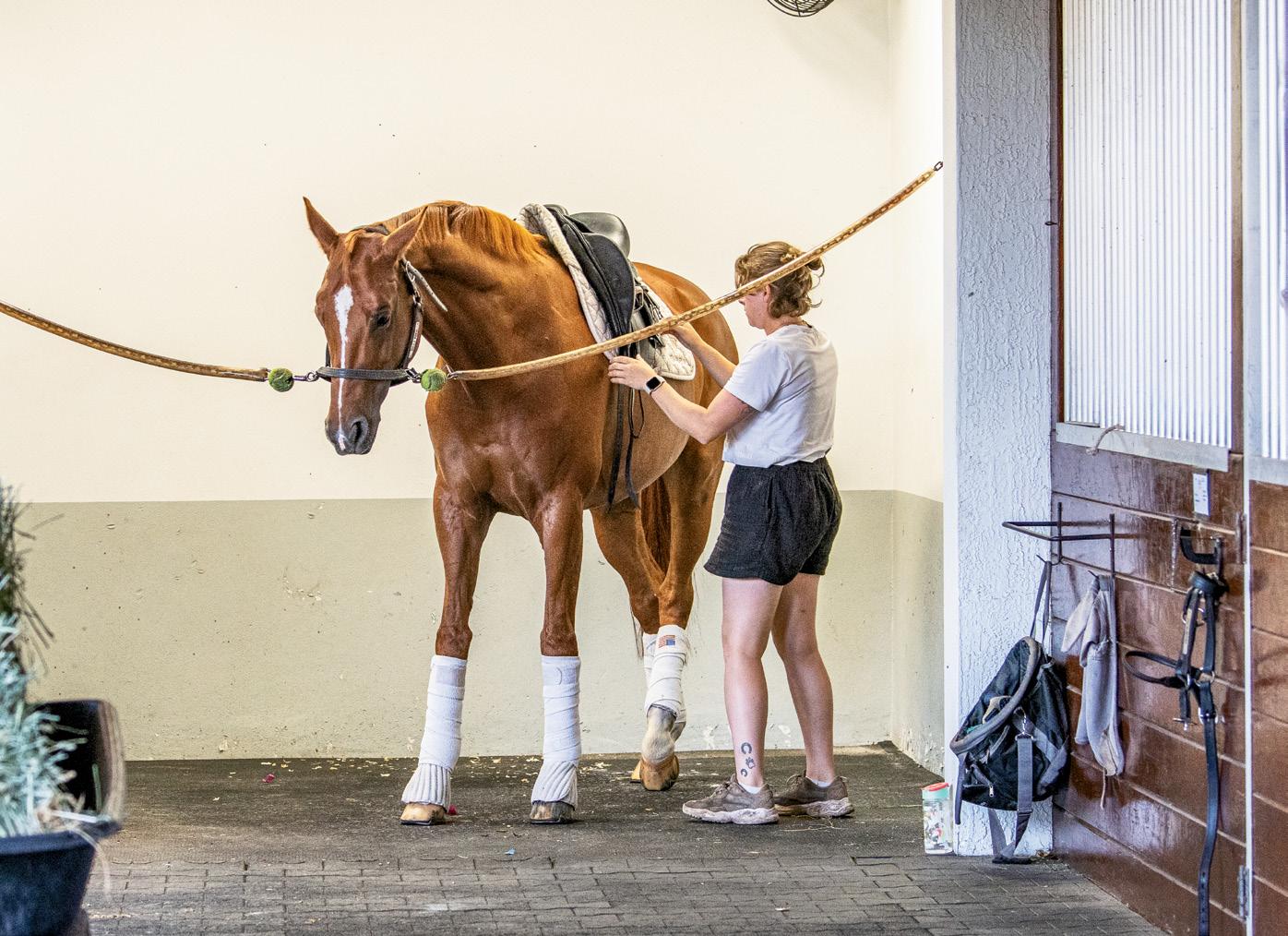
in Petaluma, California. A USDF L graduate with distinction, she is enjoying moving her PRE, Dano, through the levels.
Custom- Fit Boots
For over a century, the Dehner name has been proudly worn by young and old alike.

Thanks to Tina Hampton; Rui Sanders; rider Toora O’Mahony, trainer at Hawkwood Hill Farm in Petaluma, California; and Rocket, a Dutch Harness Horse (and real-life sale horse) owned by Ryan Phelan, for serving as the “test ride” photo models for this article.
Patti Schofler is an award-winning freelance writer and editor living
Feel for yourself the comfort and fit that have made us one of the most sought-after boots in the business!
Log-on today to view our full line of boots and shoes

USDF CONNECTION | July/August 2023 27 AMY DRAGOO/AKDRAGOOPHOTO.COM
UNMOUNTED EVALUATION: Watching the horse being groomed and tacked up, either on video or in person, can offer clues as to its comfort level and state of mind
Tel: (402) 342-7788 * Fax: (402) 342-5444 www.dehner.com Made in the U.S.A
Your GMO’s Best Marketing Tool
How to create a newsletter—for free or low cost— that members will love and that may encourage others to join
By Penny Hawes
For many USDF group-member organizations (GMOs), the club newsletter is a staple— the traditional means of sharing news, information, the events calendar, and classified ads. Today, of course, websites and social media enable news, photo, and video dissemination to be immediate.
Is there a place for a newsletter in the instant-gratification era? If so, what is the newsletter’s role, and is your GMO newsletter doing its job for you? We share advice from a marketing expert who’s a former GMO president.
Your Newsletter Is a Tool

Your GMO’s newsletter “should be a tool to help the GMO grow,” says marketing and advertising pro
Jean Rude, who during her tenure as president of the Eastern Iowa Dressage and Eventing Association (EIDEA) revitalized the GMO’s marketing and communications strategy, including a makeover of its newsletter (“Salute: The GMO Revitalizer,” May/June 2019). Now living in Florida, Rude is the founder and principal strategist of Fresh Ink Communications LLC in Santa Rosa Beach and the owner/ designer of Mind Body Dressage, a collection of graphic tees and other gifts. At the 2020 Adequan®/ USDF Virtual Convention, Rude gave a well-received Zoom presentation entitled “Eight Ways to Grow Your GMO.”
Done well, people who aren’t even members of your GMO (yet!) might want to read your club’s newsletter. During her time as EIDEA president, the GMO’s newsletter-subscriber list doubled, Rude says.
“A lot of GMOs might be thinking of [the newsletter] more like a membership perk,” Rude says. “So my big strategy and [the reason for]
the growth of ours was to make it a public document that anyone could subscribe to.” As a result, EIDEA’s newsletter became “a great marketing tool for converting prospects into members, because they’re reading what’s going on in their area. They’re seeing these people being lauded for their accomplishments, and they’re seeing pictures of events that look like fun, and camaraderie—and they think, ‘Hey, what’s going on here? Maybe I should be a part of this.’”
Growing Your Subscriber List
To receive your GMO’s e-mailed newsletter, people will opt in by sharing an e-mail address. Opting in is the gold standard because, when people sign up for your newsletter, they’re indicating that they’re interested in what you have to say. They’ve given you permission to land in their inbox. Being able to reach people via e-mail gives your message a much longer lifespan than the average social-media post, which can flash by within minutes and which may not even appear in your targeted audience’s feed. Plus, unlike social media with its constantly changing algorithms, your GMO owns its e-mail list.
Here are a few tips on adding names to your club’s list.
• Post a newsletter sign-up sheet at all GMO events. Collect names and e-mail addresses, provide a QR code so that people can sign up online, or both. The latter method saves having to transfer information from hard copy to digital and eliminates the problem of not being able to read someone’s handwriting.
• Pin a newsletter sign-up link on
28 July/August 2023 | USDF CONNECTION
SHUTTERSTOCK GMO
READ IT HERE: Engage current and prospective GMO members with a great newsletter
your GMO’s Facebook page.
• Put at least one link on every page of your club’s website. Place a simple sign-up form in the header and the footer.
• GMO officials: Add a line to your e-mail signature with a link to the signup page.
Anatomy of a Great GMO Newsletter
Your GMO’s e-mail list is growing, and you’re sending out newsletters, but are they getting read and doing their job? Here are five areas your newsletter should focus on, to help ensure it gets the results your club is looking for.
• Show the benefits of membership in your GMO
• Be instantly recognizable
• Be welcoming
• Be consistent
• Be a source of great content. Let’s take a look at what each of these points means.
Show the benefits of membership. If your GMO allows nonmembers to subscribe, as Rude suggests, you’ll want to give those people plenty of opportunities to become members. In every e-mail, a “Join Now” button that links to your membership application should be visible. Put the “Join Now” button on every page of a multi-page newsletter, and display it prominently along with any events calendar or notices of upcoming special programs, such as a symposium. If your GMO charges a higher fee for nonmembers to attend, that well-placed invitation to join could trigger the application process; after all, if the person is attending the event regardless, joining may make financial sense.
Explain the benefits of joining your GMO. Keep in mind that prospective members aren’t necessarily interested in all the features of your club; they want to know how membership can benefit them. As the old marketing adage goes: “People don’t want to buy a ¾" drill bit; they want to buy a ¾" hole.”
Use FOMO (fear of missing out) to your advantage. If nonmembers are seeing all the great things your club is doing, they’re more likely to want to be involved.
Be instantly recognizable. Make sure your newsletter is aligned with your GMO as a brand. Use the same colors, logos, fonts, and other design elements that appear on your GMO’s website and any of its printed material. You’re looking to create a cohesive brand that people will recognize immediately.
Be welcoming. A newsletter, says Rude, shouldn’t read like a rule book. Think inclusion, not directives. Write in a welcoming tone that places the emphasis on your readers. Look over recent newsletters; does the word you appear more often than the word we? It should! Your newsletter is a subscriber-centric document. By addressing the reader directly, you’ll give each person a greater sense of ownership and value.
Name names. Build goodwill by welcoming new members by name. Include a “congratulations” or “kudos” section to give existing members a shout-out for that new horse, first competition, or success in qualifying for a championship. Bonus points for including their horses’ names, too.
As Rude puts it, “Report at the local level.” And “link to every business, organization, or barn you mention.”
Be consistent. Consistency isn’t only how your newsletters look; it also applies to the publishing schedule, to the format, and to recurring columns.
Having a consistent schedule is critical. If your newsletter editor can produce a newsletter only every other month, better to use that schedule than to promise a monthly edition only to have it arrive in your subscribers’ inboxes randomly.
The North Carolina Dressage and Combined Training Association (NCDCTA), for one, switched from a monthly to a quarterly publishing
schedule last year. This has the benefit of allowing each issue to include more content. Quick “update” emails can be sent out between issues when necessary.
Including regular items—a president’s letter, member spotlight, calendar of events, and so on—will give each issue a more consistent feel and will also make the editor’s job easier, as each issue can largely be crafted using an existing template (more on templates in a minute).
Be a source of great content. No matter how attractive, welcoming, and consistent your newsletter is, without great articles and information that will engage readers and hold their attention, people are unlikely to spend time reading it.
“Design is nice, but good content is far more important,” says Rude.
Just Getting Started?
Courtesy of Rude, here’s a road map for for getting a new GMO newsletter up and running.
“If you’re starting from scratch,” she says, “first choose a name. You’re not ‘the April newsletter’; you’re On the Bit or Cadence.” The newsletter title “will help bring your GMO’s brand mission into focus.”
Next, “decide on a frequency, and commit to a schedule of publication. That sounds over the top for a volunteer gig, but it’s critical for building readership and buzz. If you publish sporadically or so infrequently that the content is no longer news, it’s a challenge to grow loyal readers.
“Now you’re ready to decide what elements should be included,” Rude continues. “Give each of these a name and an order of flow on your newsletter. For instance, you can start with the president’s letter, a quote of the month, then the news roundup and upcoming events. These will appear in every edition. Now add longer feature articles, such as a clinic review. End it with a few more elements that recur each edition, such as member spotlight, links, and contact info. Create that
USDF CONNECTION | July/August 2023 29
GMO
content mix that touches each of your types of members.”
Sometimes a GMO is looking to reinvent a tired newsletter format. Rude’s tip: “If you’re revamping a newsletter, ask for input from members who represent your constituencies (pros, juniors, eventers, Western riders, breeders, amateurs, et cetera). Ask them what they’d like to see in a reimagined newsletter and what they didn’t like about the prior one.”
Tools and Tech
You know what you want to include in your GMO’s newsletter. Now let’s talk about how to go about producing it.
First, don’t overcomplicate it. It’s easy to get overwhelmed with the concept of designing a newsletter, especially if you’re a non-designer, non-techy, time-strapped volunteer. Rude suggests starting with a simple online solution such as MailChimp (mailchimp.com), an online platform whose features include templates for creating customized e-mail messages and newsletters.
MailChimp, says Rude, “offers an amazing level of value at the free level, is easy to learn, and offers templates you can customize with your logo and brand elements.” You can add those essential “sign up to receive our newsletter” buttons, too, and MailChimp enables users to create customized mailing lists—handy if your GMO does both dressage and eventing, for instance, or has youth programs.
When it’s time to create your newsletter, you can start with one of MailChimp’s included e-mail templates, customize it with your own branding, add your content, and send it out into the world. All of this happens with a very simple “drag and drop” process. Once you settle on a format you like, consistency is easy: Your branded template is set, and you don’t have to reinvent the wheel for each issue.
MailChimp also offers simple
analytics: how many people opened your e-mail message, who they are, and which links were clicked most frequently. Over time, you’ll be able to get a good grasp as to what types of content your readers find most engaging.
Your GMO’s Best (and Sometimes Free!) Marketing Tool
GMOs, particularly those that are cash-strapped, are likely to welcome the fact that producing a newsletter may no longer require paying to produce and mail hard copies. Print isn’t entirely dead, however, and so there may still be some associated costs—which GMOs handle in different ways.
The New England Dressage Association (NEDA), for one, produces both print and digital versions of its award-winning newsletter, A Tip of the Hat. The digital version is in the form of a PDF uploaded to Yumpu, which provides a magazine-style format. NEDA membership dues include both versions.
The Eastern States Dressage and Combined Training Association (ESDCTA) has transitioned strictly to digital, according to Meredith Rogers, editor of the GMO’s newsletter, Collective Remarks
“We used to send a print version that was included in the price of membership,” says Rogers, “but we do not any more; it saved us a ton of money and time. We send out a link when it’s ready, and it is also archived on the website.” ESDCTA uses the digital-magazine platform Issuu.
Some GMOs charge a fee for hard-copy newsletters. In the case of the Wisconsin Dressage and Combined Training Association (WDCTA), the upcharge wound up cementing the move to digital.
When WDCTA made its eQuester newsletter available online more than five years ago, it tried charging those members who wanted hard copies an extra $10 a year to cover
the costs of printing and mailing, which the fee “didn’t do completely,” says newsletter editor Caryn Vesperman. “There were maybe thirteen people who subscribed; then it got down to a couple, and [the GMO] finally cut it off. No complaints.”
In the end, your GMO’s newsletter has to work for your members, in terms of both deliverability and affordability. Online newsletters have increasingly become the norm as more people have embraced all things digital, and their production and distribution are cost-efficient.
“You don’t need to pay for printing or postage, or even the platform software,” says Rude. “Let your newsletter be one giant ad for how fun it is to be in your GMO, and your ROI will be in the form of dues.”
Penny Hawes is a writer, rider, and coach from Virginia. When she’s not working, you can find her hiking with her daughter, scouting around for antiques with her husband, or hanging out with her assortment of horses, cats, and dogs.
IN THE NEXT ISSUE
• Youth issue
• Katie Duerrhammer: From NAYC gold to Team USA
• What we wish we’d known about dressage: Experts look back
• Training insights from Scott Hassler
30 July/August 2023 | USDF CONNECTION

Rider Does Size Really Matter?
A discussion on how a rider’s weight and physique are perceived in the sport of dressage
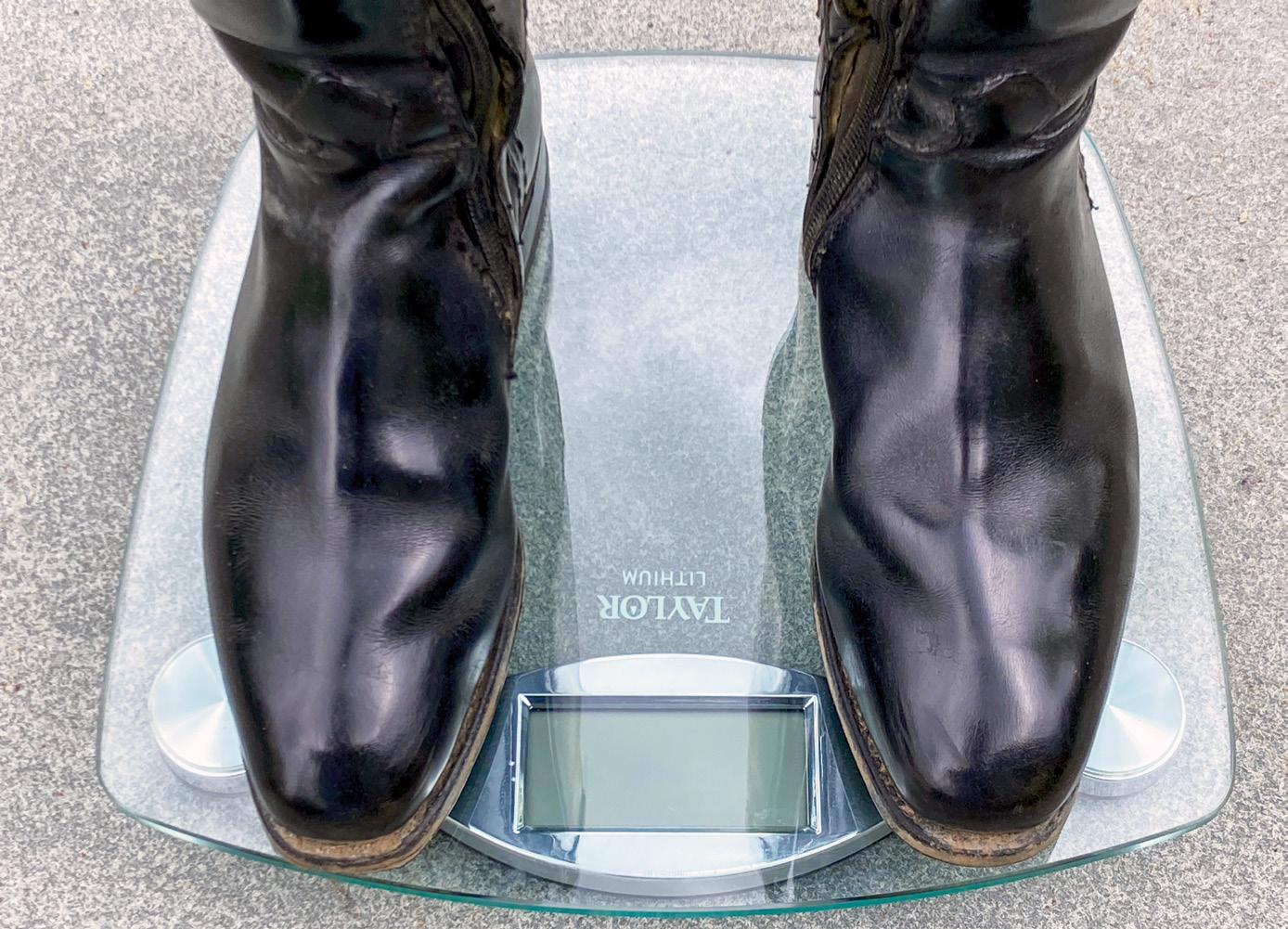 By Jennifer Mellace
By Jennifer Mellace
“Pizza Thighs.” That was the nickname a riding instructor gave me when I was a 10-year-old working student. It hurt, but I looked up to this woman, and I wanted to be just like her and the other instructors and riders at this hunter/jumper barn. So I kept my mouth shut, worked my tail off, and became a good, effective rider. But the nickname, which stuck, never let me forget the fact that I was always just a bit overweight, as
And yet I still look in the mirror every day and criticize those pizza thighs and broodmare hips.
Fat-shaming and body criticism aren’t limited to equestrians, of course; they happen to people in almost all sports, not to mention celebrities and others in the public eye. But we wondered how important it is to dressage riders, instructors, and even judges that a rider appear slim. We also wanted to know: Can a rider’s weight ever affect their ability to be ef-
bian Sport Horse circuit at Fourth Level and Prix St. Georges and have placed third nationally in the competitive Musical Freestyle division at the Sport Horse Nationals Arabian and Half-Arabians Championship Horse Show.
Rogan describes herself as having a larger, athletic body. In 2020, she challenged herself to gain more muscle, which she accomplished.
“ Throughout my years in the equestrian world, there have always been stereotypes or stigmas [surrounding weight], and I always like to try and break those,” Rogan says. “There is not one type of person who can enjoy this passion and hobby, and I’m tired of seeing bullying and/ or harassment of those who look like me in this sport.”
While Rogan hasn’t experienced in-person criticism, she says she has been the target of online bullying.
“I like to post content of me and my horse doing a variety of activities, such as dressage-test practice, funny TikToks, and product reviews,” she says. “With my riding videos, internet trolls will post extremely hateful and rude comments, almost chastising me for trying to be in the sport when I do not look like their ideal equestrian.”
did such comments as, “You’d make a great broodmare with those hips.”
Today, I’m 51 years old, and while I haven’t ridden in a couple of years, I am a trail runner who runs four times a week and has completed multiple half-marathons and 25K distances over some pretty tough terrain. The scale isn’t the lowest it’s been in recent years, but I’m certainly fit and healthy.
fective in the saddle, or have any sort of detrimental effect on the horse?
The Positive and Negative Dialogue
Sylvia Rogan, 29, of Omaha, Nebraska, began riding at the age of five and started competing in dressage in 2013. Today she and her Arabian/ Oldenburg cross compete on the Ara-
That said, at shows, Rogan has found most coaches and officials to be “very positive and encouraging,” she says, adding that helping to counterbalance the social-media trolls have been the “wonderful” and “nothing but encouraging” people she’s met through her Instagram account, @PracticeMakesPiaffe.
“I have multiple videos with 30,000-plus views where I speak out against body-shaming in our sport,” says Rogan, “and they have been shared more than 200 times and the
32 July/August 2023 | USDF CONNECTION JENNIFER BRYANT
WEIGHTY ISSUE: The topic of rider size and weight is a touchy one, and some USDF members say they’ve been fat-shamed
comment section is overwhelmingly positive.”
Wisconsin-based Nicole “Nic” Fink, 31, who is currently schooling her eight-year-old Arabian/Friesian mare at Second Level, says she’s seen many friends ridiculed for their weight on their social-media platforms.
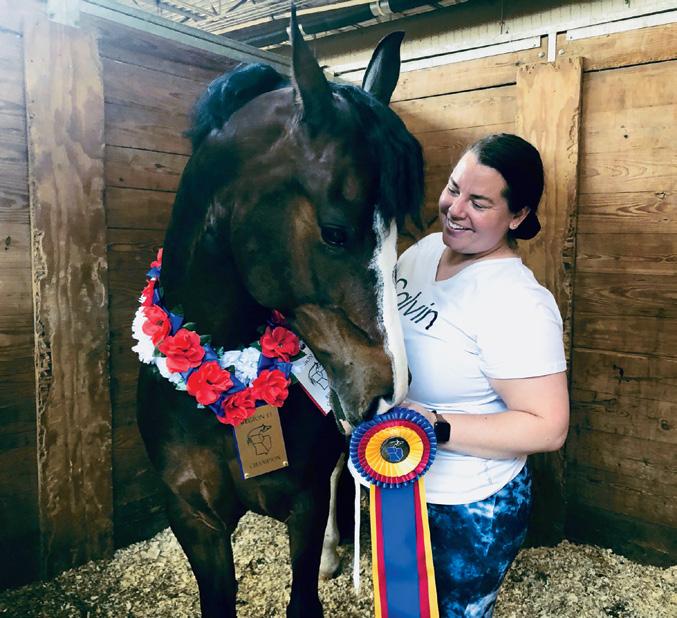
“There is such a negative image about [riders’ weight] on social media,” says Fink. “Everyone can see it. I have seen many of my friends get slammed for their weight on TikTok, Instagram, and Facebook, myself included. Personally, I try to keep the faith and not let it bother me; however, I do not appreciate it when it’s done to my friends. This sport is already incredibly tough mentally and physically as it is, and we as riders need to support and lift each other up.”
Fink, who describes herself as a “very busty girl,” says that “it has been a challenge at times to find nice-fitting attire for the show ring. I’m also tall, and the combination of the two has been difficult. I consider myself to be strong, but I do carry extra weight in my hips.”
At dressage shows, Fink says, she has received “discouraging” comments from judges regarding her appearance but also has had wonderfully positive interactions with fellow competitors.
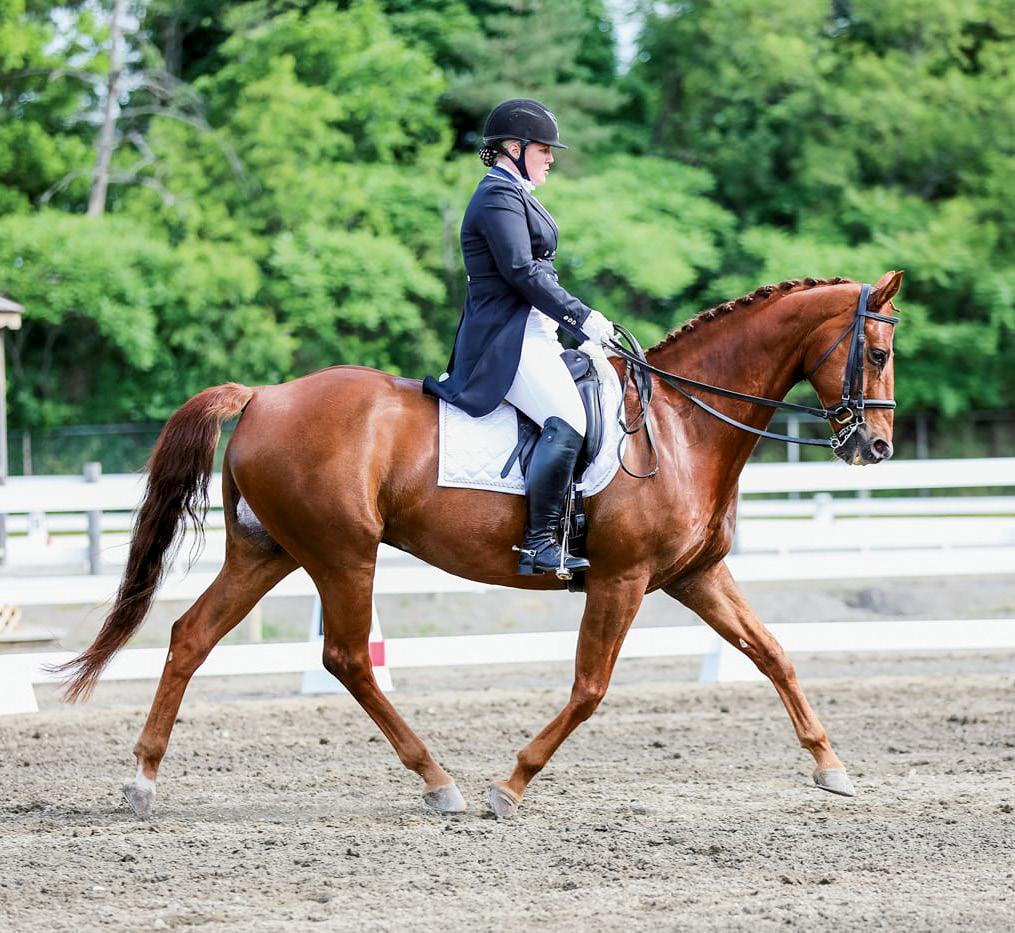
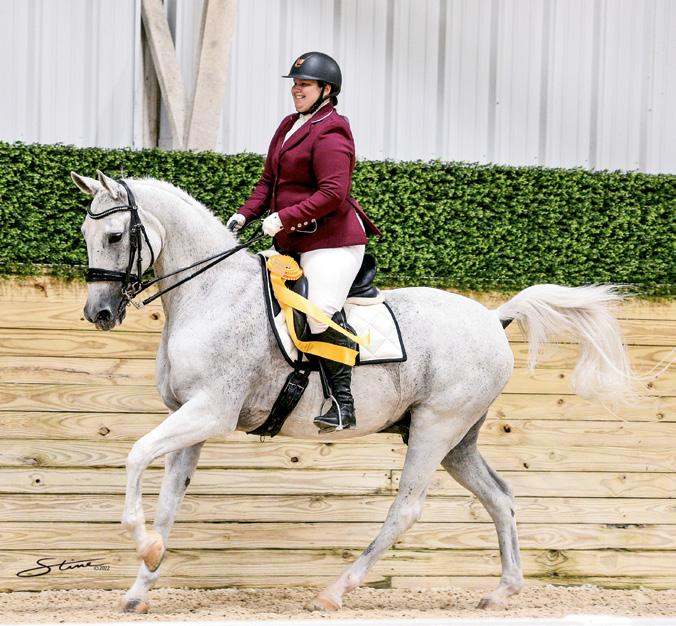
“There are a few bad apples, but most are happy to share the same
arena with me,” she says, “and that makes me feel good to be there. It gives me a confidence in my rides.”
Harmony Comes in All Sizes
At five feet 11 inches, professional dressage instructor/trainer and USDF silver medalist Patricia “Trish” Hutchinson has never been a small person.
“I was 230 [pounds] at my heaviest; I’m now 188,” says Hutchinson, 45, a native of western New York state who now lives in Easton, Maryland. “My father’s nickname for me was Moose, and I always joked that I was built like a brick wall. But even at my heaviest, I was still a balanced and sensitive rider, and could produce more from a horse than riders who were half my size.”
At her largest, Hutchinson says, she was still an effective rider, but she experienced some loss of athleticism and flexibility, both of which improved when she lost some weight. The worst part of being heavier, she says, wasn’t the riding; it was the negative comments.
“It was very hurtful to have people talk about me behind my back,” she says. “I’d hear people say, ‘She could be so much better....’ It hurt to have people tell me I was fat and overweight. It made me question myself. Even after the weight loss, I had a coach say, ‘Stick your beer gut out and put it to use,’ just as I was getting ready to enter the show ring.”
The cruel comments, Hutchinson says, served as fuel to make herself tougher mentally. Today, she uses her experience to help riders with confidence issues (typically older female adult amateurs) to become strong, self-assured equestrians.
Hutchinson believes that judges, trainers, and others in the dressage industry need to learn to look past the aesthetics of rider weight and instead to assess the rider’s effectiveness and the horse’s way of going as the true tests of the dressage performance: Is the rider balanced and moving with the horse? Does the horse appear happy? Is the horse moving freely and coming up over his back?
“You can tell if a horse is unhappy or uncomfortable,” Hutchinson says. “I also believe that most riders who feel they are too heavy aren’t going to sit on a horse who can’t carry them. The industry needs to see what [quality of performance] is being produced versus just getting stuck on what the rider looks like.”
Fink agrees: “I don’t see where [others] have any right to comment on someone’s weight. If it’s completely detrimental to the rider or the horse’s health, that’s a different situation. But there are many riders—good riders—who carry a little extra. You don’t need to be 120 pounds and five feet nine inches to be a good rider. This standard in our industry needs to stop.” [
USDF CONNECTION | July/August 2023 33 DONSTINE.COM; COURTESY OF NIC FINK; COURTESY OF TRISH HUTCHINSON
POSITIVE INFLUENCER: Through her socialmedia accounts, Sylvia Rogan aims to change attitudes regarding rider size
KEEPING THE FAITH: Nic Fink tries to support other riders and feels empowered when they do the same
TALL IN THE SADDLE: At 5’11”, dressage pro Trish Hutchinson finds that a rider’s skill and balance are more important than size
But Size Does Matter—Sort Of
The world of Western riding is filled with images of tall, solidly built men astride 15-hand stock horses and nobody bats an eye; but in dressage, there can be tsk-tsking when a larger or taller rider enters at A aboard a smallish mount.

Some of the objections are purely aesthetic: “As a larger person on not-large horses, I know I don’t look as good as all those tiny people on giants,” says USDF gold medalist Shareen Purcell, 59, of Hayward, California, whose current mounts are of modest height by dressage standards, at 15.3 and 16.1 hands.
“When I see myself in pictures, I look like the larger men riding, with very wide shoulders and very long legs,” Purcell says, adding that “I have always been what my grandmother called ‘substantial.’ Even rail-thin, I was 180 pounds and five feet nine inches. In my worst times, I have reached 208 pounds. I’m down to about 192 now, and I don’t think below 180 would be possible unless I did some extremely unhealthy things or I were really sick.”
Appearances aside, Purcell says she’s realized that, biomechanically, the way a person is built does affect the way they ride.
As a tall person on not-so-tall horses, “My legs hanging below my
horse’s belly make me have to ride in a different way,” she explains. Her muscular build also means that “I’m quite strong, which can be good around horses, but it can also lead to overriding. It’s way too easy for me to override. Sitting deep was causing both of my mares to feel like they have to scoot out from under me, so I had to change the way I do extensions and sit a lot lighter. Even doing pirouettes, I found myself sitting too deeply and causing changes behind, so I have to remind myself to sit forward. I have to be careful and work a lot more subtly than smaller riders because my size has a much bigger impact. So, in the end, I think it makes me a better rider.”
“A rider’s size—big, small, and every which way—affects how you ride, negatively and positively,” Purcell says. “In the end, there is nothing we can do about the overall ‘nice’ impression a smaller person makes on a larger horse.
“Dressage is supposed to be about training,” she concludes. “I don’t know what it’s like to have short legs and try to ride a horse, but I can do my best to assess and help [riders who are built this way]. I’m certainly not going to tell anyone they shouldn’t be riding because they have short legs, short or long arms, skinny or thick legs, an overly straight or an overly curved back, injuries, stiffness, or whatever.”
Yet an equestrian rule of thumb persists: A rider should not weigh 20% or more of the horse’s own body weight. Myth or truth?
Equine orthopedist Dr. Sue Dyson of the UK-based Animal Health Trust Centre for Equine Studies says that horses are, in fact, sensitive to rider weight and balance. At the 2021 American Association of Equine Practitioners Convention, Dyson presented the results of three studies.
In one study, conducted by Dyson’s group and using her own Ridden Horse Pain Ethogram, which assesses signs of discomfort exhibited by horses under saddle (see “Collection: ‘24 Behaviors’ Field Guide Available
as Free Download,” p. 13), experienced riders of varying weights rode a group of non-lame horses. The horses ridden by the heavier riders showed adverse effects to their gaits and behavior.
In another study, in Denmark, the same rider rode a group of 20 horses, with the horses “handicapped” with increasing amounts of dead weight. Although the added weight didn’t appear to exacerbate pain signs, many of the horses exhibited pain-associated behaviors from the beginning, indicating possible preexisting discomfort.
A third study Dyson described examined the effects of adding large amounts of dead weight to a group of Icelandic horses—up to 35% of a horse’s body weight—all ridden by a single rider. Although the horses’ gaits remained symmetrical, greater weight produced a decrease in stride length and an increase in the time the horse spent in stance phase (with one or more limbs grounded). Dyson noted that she has observed similar gait changes in sport-horse breeds in trot and canter when ridden by larger riders.
That said, rider weight is only one aspect of the issue, Dyson said: Research shows that the suitability of a rider for a particular horse depends not only on weight, but also on the person’s height and body structure, she explained. Excessive rider size (in any form or combination thereof) has welfare implications for horses, but this is just one factor in a list that includes the horse’s age; its fitness and muscle development; the length of its thoracolumbar region; known unsoundnesses or other musculoskeletal problems; the type, speed, and duration of work; the rider’s skill, fitness, balance, coordination, and ability to sit straight and in the middle of the saddle; saddle fit (for both horse and rider); and the terrain over which the horse is ridden.
“It is inappropriate to give a categorical rider/horse weight ratio,” Dyson concluded, “because there are too many variables.” She did, however, call it veterinarians’ “moral
34 July/August 2023 | USDF CONNECTION COURTESY OF SHAREEN PURCELL
Rider
STRONG AND SENSITIVE: USDF gold medalist Shareen Purcell’s strength can cause her to override. She’s learned she needs to lighten her seat at times.
responsibility to advise riders if they are too big for the horse. To fail to do so would jeopardize the horse’s short- and long-term welfare.”
An Ongoing Issue
What Dyson called on veterinarians to do is a tall order, and one that has the potential to upset or even lose clients. One equine veterinarian who’s a longtime amateur dressage rider declined even to be interviewed for this article, calling the topic of rider size too sensitive.

As we’ve discussed, the subject of rider size encompasses an equinewelfare aspect and an aesthetic aspect. Veterinary research indicates that there can be such a thing as a rider who, given a particular set of circumstances, is physically not well suited to a particular horse. But considering our culture’s preoccupation with thinness, it hardly seems surprising that thinner riders may be perceived as fitter and more attractive, and possibly even more skilled, in the saddle than larger riders.
The fact remains that it’s a touchy subject. Two well-known FEI-level rider/trainers agreed to speak with USDF Connection for this article, then got cold feet. One remarked that, for larger dressage riders, “the sneers and bullying are out there, for sure.”
Those who agreed to go on the record for this article expressed the belief that it’s important to speak out on the subject of weight and body image.
“If you believe you can do it, you can,” says Hutchinson. “I will always be chasing my dreams. I want people to believe in themselves and know that they can do it. There is too much stigma about size and weight. It’s too hurtful to the kids growing up and coming up through these programs.”
“Other riders, including teenagers, continue to be bullied and harassed online by people because of their size,” says Rogan. “They are quite frightened even to post any riding videos in fear that they would
REGISTER YOUR HORSE WITH USDF!
have trolls comment. I feel as if the [US Equestrian action plan] for diversity, equity, and inclusion could do so much more for the protection of these young riders.”
“I know it’s hard to keep going, but please keep going!” Fink urges. “Don’t let others’ opinions of you keep you from your dreams. The folks that need to comment and say unkind things are only unhappy with themselves to pick on others.”
Rogan, for one, objects to the idea that larger people have no business riding horses.
“Every situation is different, and one blanket statement cannot rule our sport and passion,” she says. “I want to be part of a sport that is inclusive, fun, and supportive, not one that is exclusive, closed-minded, and mean. I heard a quote the other day that said, ‘No one who is more talented or better than you would ever tear you down,’ and that sits with me. I want every single person who has been bullied or harassed for their size to know that they are not alone, and that there are riders of every size at all levels of our sport.”
The $115 USDF Lifetime Horse Registration:
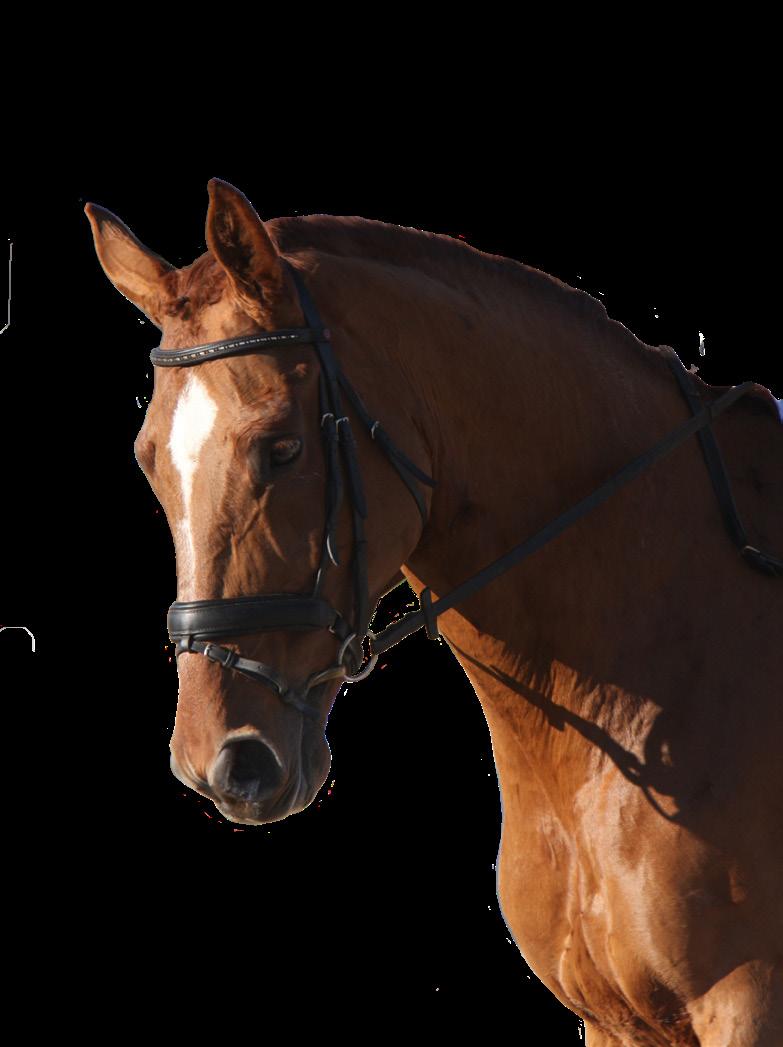
• Fulfills horse registration requirements for ALL USDF award and championship programs.*
• Never needs to be renewed.
Jennifer Mellace is a published author who writes about topics ranging from health and wellness to lifestyle and business. She lives in Frederick, Maryland, with her husband, two children, and three dogs. Visit her website at MellaceWrites.com.
USDF CONNECTION | July/August 2023 35 COURTESY OF SYLVIA ROGAN
BODY POSITIVE: Rogan displays her favorite slogan at a dressage show
NOVEMBER 9 –12, 2023 • KENTUCKY HORSE PARK featuring over $120,000 in prize money
US Dressage Finals Junior/Young Rider Classes at the national levels
$50,000 in US Dressage Finals Travel Grant Funds Available


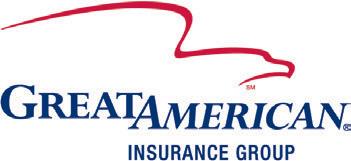

To help alleviate some of the financial burden for those traveling the greatest distances to the US Dressage Finals, USDF is making up to $50,000 in travel grant funds available to eligible competitors.

FOUR IMPORTANT STEPS AND DEADLINES
1. Declare – Complete a Declaration of Intent for each level and division for which the horse/rider combination may qualify.
2. Qualify at one of the Great American/USDF Regional Championships.
3. Nominate – Each US Dressage Finals horse/rider combination is required to complete the nomination (preliminary entry) process.
4. Enter - Can nominate and enter at the same time.
US Dressage Finals Deadlines
For additional qualifying, declaration, nomination, and entry information visit usdressagefinals.com
Regional Championship Declaration Nomination 1 Wednesday, October 4, 2023 Thursday, October 12, 2023 2 Wednesday, September 20, 2023 Thursday, September 28, 2023 3 Wednesday, October 4, 2023 Thursday, October 12, 2023 4 Wednesday, September 27, 2023 Thursday, October 5, 2023 5 Thursday, September 28, 2023 Thursday, October 5, 2023 6 Wednesday, October 4, 2023 Thursday, October 12, 2023 7 Wednesday, September 20, 2023 Thursday, September 28, 2023 8 Wednesday, September 20, 2023 Thursday, September 28, 2023 9 Wednesday, October 4, 2023 Thursday, October 12, 2023 Above deadlines are midnight in the time zone of the specific Regional Championship Entry Closing Date is October 16, 2023 midnight Eastern Time See Official Prize List for more information.
Nutrition for All Ages and Stages
Feeding advice for the dressage horse, from foals and breeding stock to Grand Prix
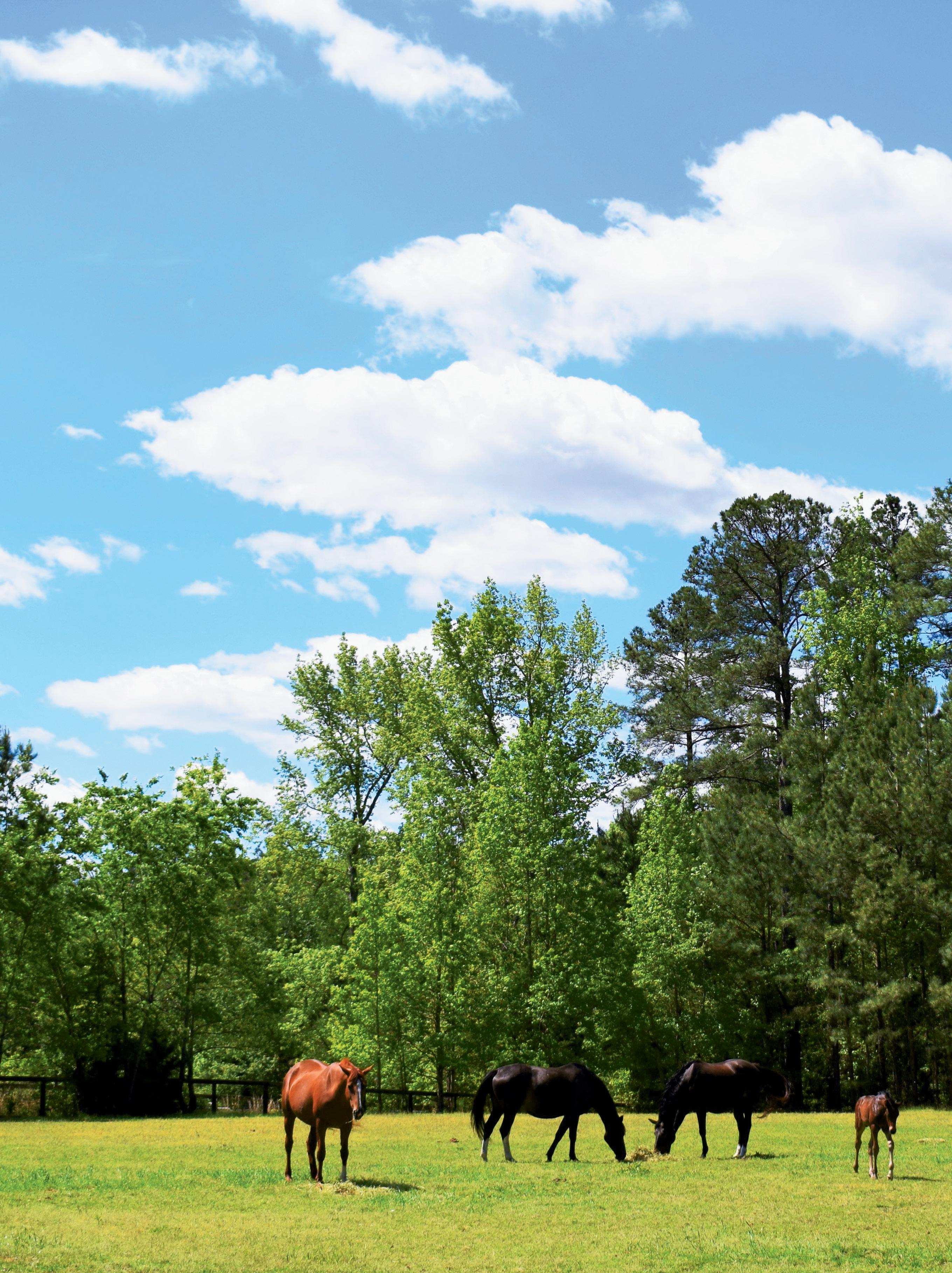 BY HEATHER SMITH THOMAS
BY HEATHER SMITH THOMAS
38 July/August 2023 | USDF CONNECTION
roper nutrition is important for all horses, and especially for sport horses. For this article, we asked five experts for their advice on feeding sport horses—including youngsters and breeding stock— at all stages in their athletic careers.
Forage Is the Foundation
Forage—hay and grass—is the basis of any equine diet, says Shannon Pratt Phillips, PhD, a sport-horse enthusiast and a professor of equine nutrition and physiology at North Carolina State University in Raleigh, North Carolina.
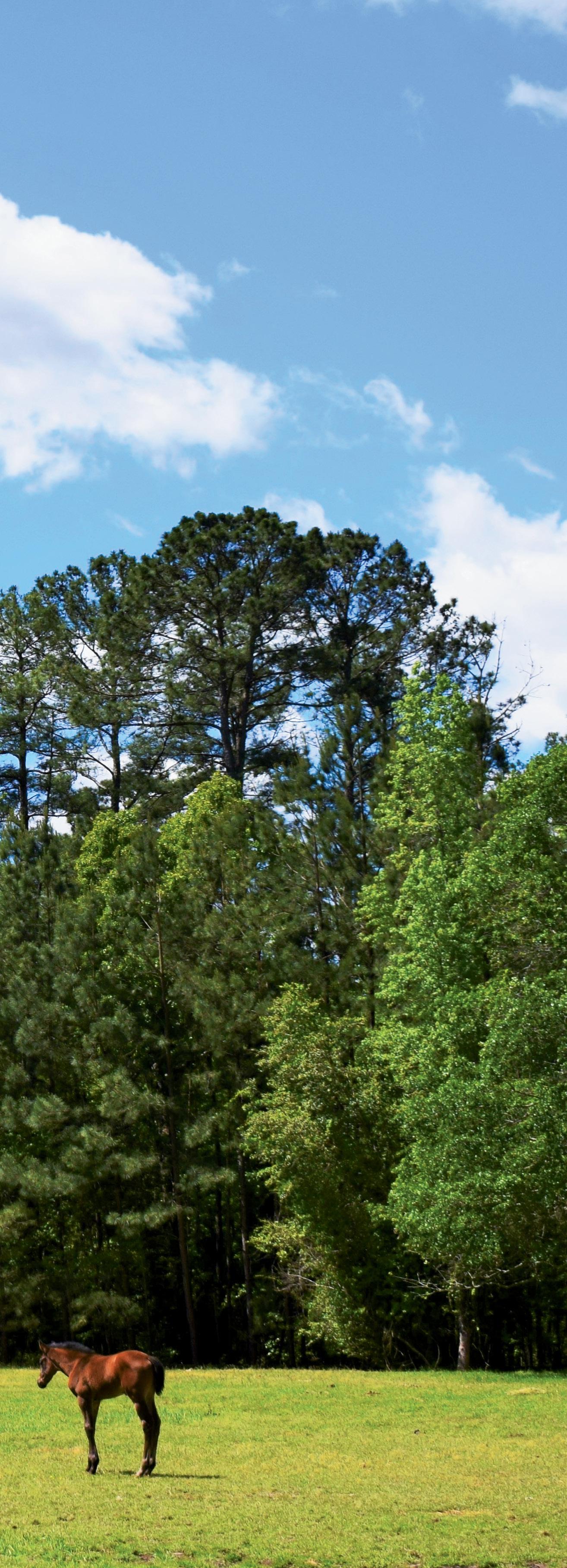
“Fundamental nutrition begins with good-quality forage because it provides calories—more than most people realize—along with adequate levels of protein,” says Phillips’ colleague Paul Siciliano, PhD, a professor of equine nutrition and management at NCSU. “If the gut is not continually full of fiber moving through, we see problems, especially in horses that depend on us to feed them, versus horses at pasture continually grazing.”
All those calories and nutrients mean that “some dressage horses do fine on good-quality hay” alone, says Phillips, possibly along with a ration balancer or vitamin-mineral mix “to meet any needs that might not be supplied by the hay.”
Nutrition for the Adult Performance Horse
To meet the demands of dressage, some horses need the additional calories and nutrition provided by concentrates, which usually means choosing among the many brands and formulations of commercial horse feeds.
Phillips’ advice: Choose grain mixes that are high in fat and fiber and low in starch. “Some horses are sensitive to sugar rushes and might have unwanted behavioral response with too much starch and sugar,” she explains, adding that excess starch and sugar may also lead to digestive problems.
It may be tempting to buy one feed for the entire barn, but it’s best to tailor the regimen to the needs of the individual horse. For example, Peggy Devens, the Dutch-born barn manager for Marcus Fyffe Dressage in Wellington, Florida, has found that the Iberian horses in her barn “require a different feeding program” than that of the warmbloods ridden and trained by the facility’s head trainers, international competitors David Marcus and Nicholas Fyffe. “We have to be a little more careful with them when feeding sugars and starch. They are more sensitive to feed and feed changes.” [
USDF CONNECTION | July/August 2023 39
P
COURTESY OF SAMANTHA KIDD/ARION SPORTHORSES
IDEAL START: These mares and foals at Arion Sporthorses in North Carolina thrive on a nutrition regimen including lush pasture and other quality forage
More Meals Are Better
“Spread out the grain meals. If you feed four meals a day instead of two, each meal will be smaller,” says equine-nutrition expert Shannon Pratt Phillips, PhD. This is a plus given the horse’s small stomach size; smaller meals are easier for the horse to digest properly.
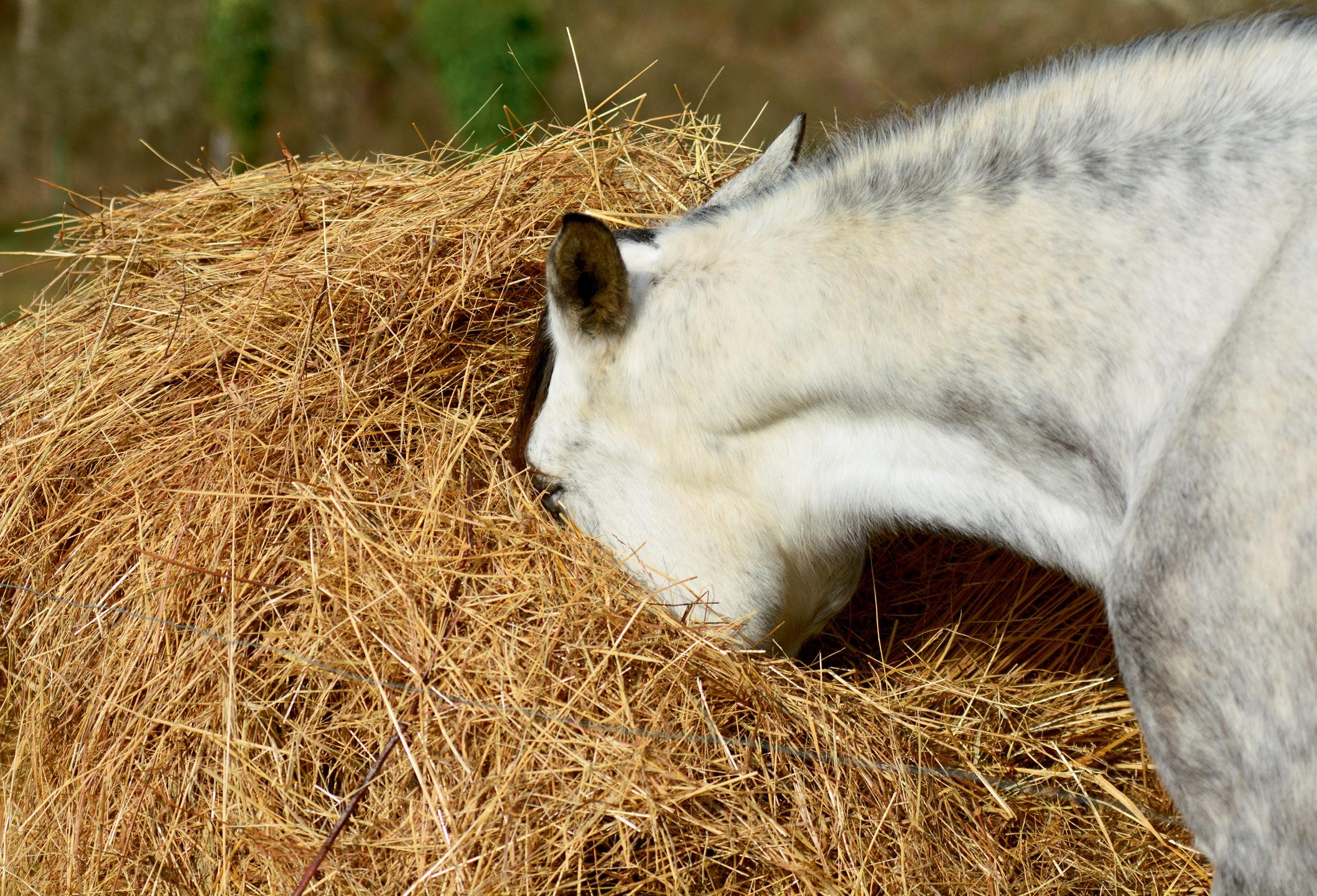
Marcus Fyffe Dressage barn manager Peggy Devens agrees.
“Coming from the jumper world,” Devens says, “I worked in places where they only feed grain twice a day. I think it’s good to make portions as small as possible and feed more often. I think this is a key to keeping horses happy and healthy: The digestive tract has time to process everything, rather than [the horse] having to work before it is digested in their system.”
Another consideration is the horse’s work level. At Marcus Fyffe Dressage, some of the horses “are on the highest Grand Prix level, some on a lower level, and some [are] older horses.”
Devens says she’s “learned which type of grain I need to feed to a horse with metabolic problems, and which grain and how much to feed a high-competition horse. I always look at the horse, and listen to my riders and trainers, to know if that horse needs more or less energy.”
Most dressage professionals have their preferred feed manufacturers, and a given facility will typically feed one or more formulas made by one company. Devens is partial to the offerings from the Australian manufacturer HyGain, saying, “They have a unique way to make their feed and micronize the grain to ‘predigest’ it. Research shows that when the starch is micronized, it can be up to 95% digested in the small intestine of the horse. By con-
trast, a whole grain, cracked grain, or steam-rolled grain is only 40% digested in the small intestine.”
The choices can be mind-boggling, so turn to your veterinarian, an equine nutritionist, or both for advice on designing a program and choosing feeds that are appropriate for the horses in your stable.
Nutrition for the Older Dressage Horse
As with humans, horses’ metabolism varies from individual to individual, and it can change as a horse ages, says Siciliano.
“Horses age at different rates; sometimes it’s genetic,” he says. “You have to deal with each horse as an individual to keep them in proper body condition. Some start losing muscle mass as they get older.”
If an older horse starts dropping weight and muscle, or if it begins to have trouble chewing as its teeth wear, adjust its diet (and address any dental issues) accordingly, Siciliano advises.
40 July/August 2023 | USDF CONNECTION
SHUTTERSTOCK
FORAGE FIRST: Quality hay and grass are nutrient-rich and form the basis of every good equine diet
“Today we have many options for senior feeds,” he says, “but often all we need to do is improve the quality of the forage, if the horse can chew it. Finer hay, without coarse stems, is easier to chew.”
Siciliano points to research findings by the now-retired Rutgers University (New Jersey) professor Sarah Ralston, VMD, PhD., Dipl. ACVN, whom he calls “a pioneer in nutrition research with geriatric horses.” Ralston “showed that in older horses fiber digestion was decreased; and protein requirements, and possibly phosphorus, might be slightly increased. Many of these horses can get the higher protein and nutrient levels in good-quality alfalfa hay. I’ve seen many older horses thrive on good alfalfa,” he says.
Rutgers exercise physiologists conducted research on older horses’ nutritional needs, comparing a group of horses in their teens with a group in their twenties. They found
that “For a given level of work, an older horse expends more energy and has to work a little harder than a younger horse, with more sweat loss,” according to Siciliano. This needs to be addressed in the older horse’s diet, he says, adding that “sometimes fat supplements are beneficial for horses that need more calories.”
Monitor your horse’s body condition throughout his life, Siciliano advises. Especially as he ages, don’t let him get either too fat or too thin. (To learn how, see “What’s Your Horse’s Body Condition?” at right.)
Nutrition for Breeding Stock and Foals
Proper nutrition is crucial for broodmares and stallions for optimum fertility and production, and for foals and young horses for optimum growth, future soundness, and athletic ability.
As always, start with forage. The 25 broodmares, the 15 to 20
What’s Your Horse’s Body Condition?
Your horse needs to consume enough calories and nutrients to have sufficient energy and muscle to meet the demands of dressage (or breeding and lactation, or growth). But don’t overdo it.
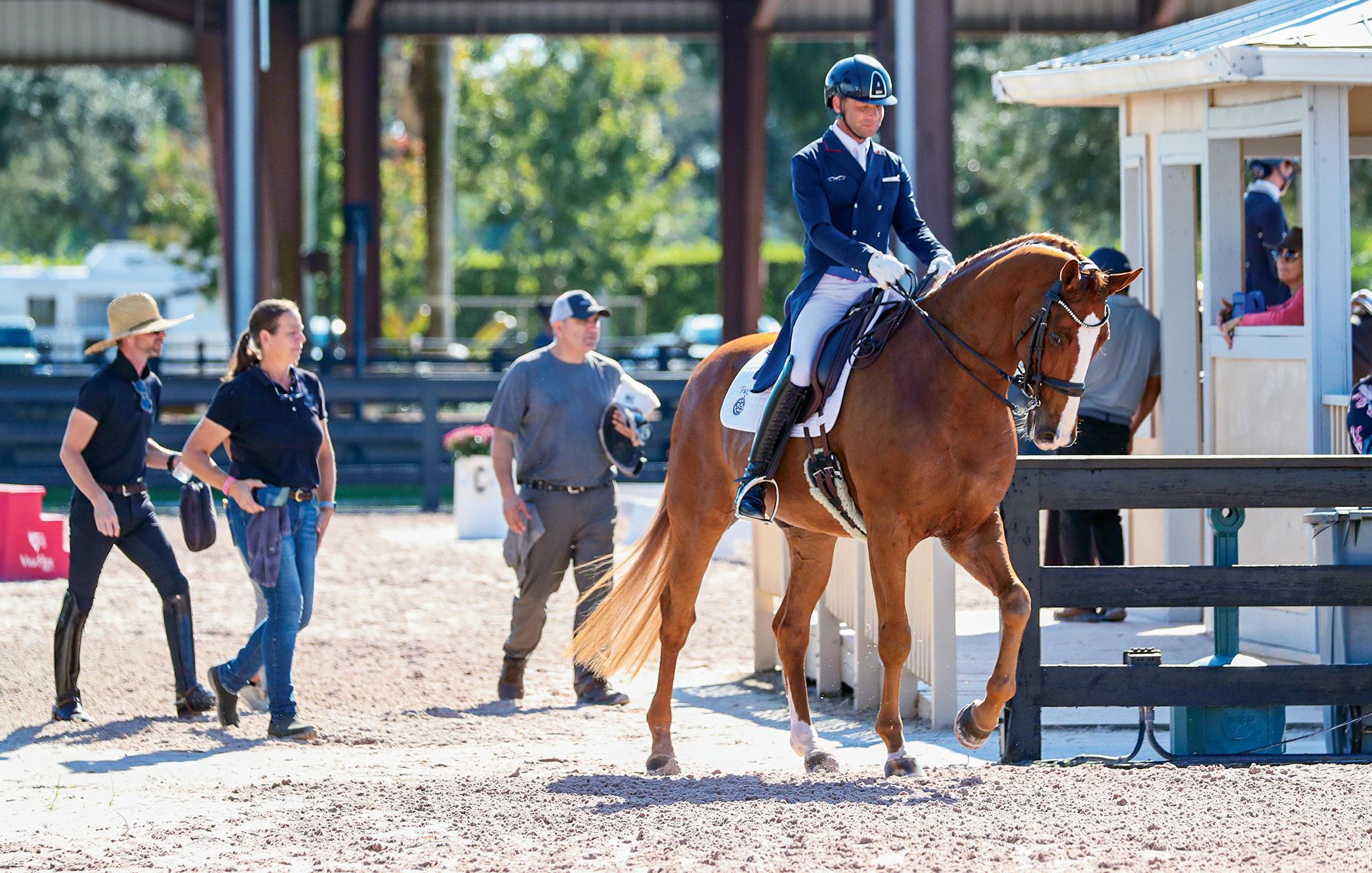
“An overweight horse with osteoarthritis has more stress on its joints,” says North Carolina State University professor of equine nutrition and management Paul Siciliano, PhD.
“Keep them between 5 and 6 bodycondition score,” says Siciliano’s NCSU colleague Shannon Pratt Phillips, PhD. “This is ideal for an athlete.”
Not sure where your horse’s weight puts him on the widely used US Body Condition Score Chart? Check his appearance against the descriptions and illustrations on this one from equinenutrition company Kentucky Equine Research: ker.com/wp-content/uploads/ body-condition-score-chart.pdf.
USDF CONNECTION | July/August 2023 41
SUSANJSTICKLE.COM
TEAM APPROACH: For peak performance, top barn managers monitor horses’ intake carefully and also consult with riders and trainers. Marcus Fyffe Dressage co-head trainer David Marcus heads for the arena on Qosmo (Quarterhall x Rascalino), a Hanoverian gelding owned by Martha Stover, accompanied by supporters including barn manager Peggy Devens (second from left).
foals they produce each year, plus assorted weanlings through threeyear-olds at Arion Sporthorses, Southern Pines, North Carolina, “are on good pasture, but we always use hay before we turn to grains or concentrates,” says owner Samantha Kidd, a multi-time Adequan®/ USDF Dressage Sport Horse Breeding Breeder of the Year. “Hay comes first; then we supplement it with concentrates.”
Feeding the broodmare. Broodmares’ nutritional needs vary depending on breed, age, size, amount of milk produced, and whether they are easy or hard keepers, says Stephen E. Duren, PhD, founder of Performance Horse Nutrition, an independent equine-nutrition consulting firm in Weiser, Idaho.
Duren points out that although “warmbloods are not the typical thousand-pound horse that most feeding instructions are geared toward,” many warmblood broodmares are relatively easy keepers and therefore “can get their calorie
requirements from high-quality forage and don’t need much grain.”
However, Duren cautions, even easy-keeper mares still need sufficient vitamins and minerals to support a pregnancy. “So, rather than using traditional concentrates designed for pregnant mares, big warmblood mares are often fed ration balancers designed for lower intake,” he says. These products supply “vitamins and minerals and perhaps protein, to supply the nutrient requirements of the developing fetus without getting the mare too fat.”
Here’s another reason to keep the grain ration in check: According to Duren, most mares become insulin-resistant during pregnancy—so you don’t want to aggravate that problem by feeding too much grain and energy.
“Mares that are overweight and already have insulin resistance or are borderline insulin-resistant often develop laminitis about the time they are ready to foal,” Duren
says. “This problem can usually be averted with good management and proper feeding.”
You don’t want your broodmare to become fat, but it’s important to realize that gestation and lactation require a great deal of fuel, says Kidd.
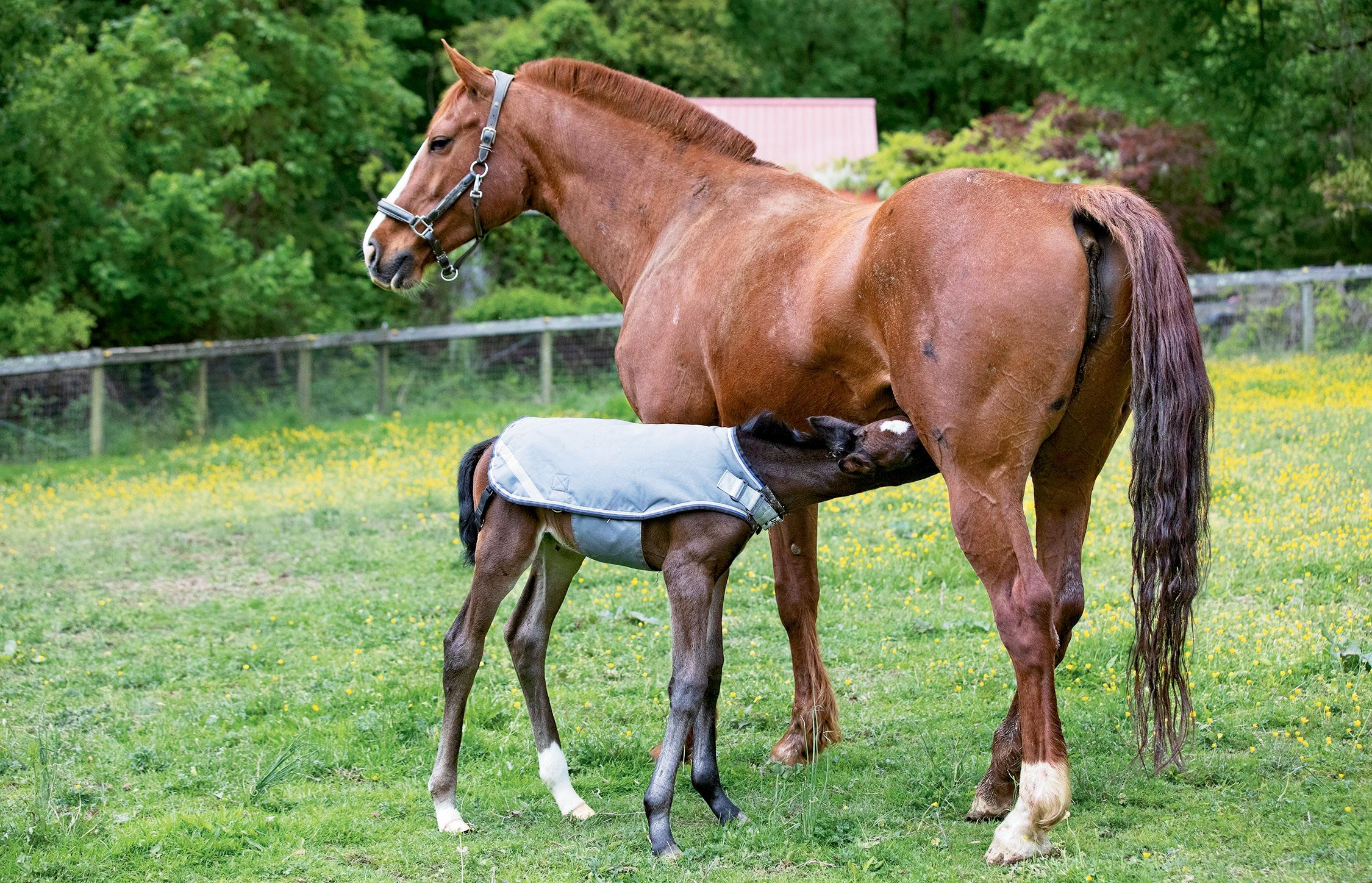
“We believe in keeping good weight on broodmares,” Kidd says. “Some of our clients think broodmares are fed differently than competition horses, but we often feed our mares the concentrates for horses in light to moderate work,” with some getting more than even performance horses in heavy work. Then “we use their off time through winter—when they don’t have foals at their side—to regain any weight lost during lactation as they head into the next foaling season.”
Kidd is a fan of alfalfa hay for her broodmares, saying, “When we switched to really good alfalfa for the mares, it made a big difference. We found our mares thrived better on the calorie and protein-dense alfalfa, and we’d rather provide the
42 July/August 2023 | USDF CONNECTION
STACYLYNNEPHOTO.COM
THE RIGHT START: Good broodmare nutrition enables mama to give her baby the nutrients it needs in its first weeks. The Dutch Warmblood mare Fotogenic (Contango x Rampal) nurses her 2023 Glamourdale filly, Tango Foxtrot.
calories with hay than with concentrates.”
The feeding strategy has an economic advantage, as well: “Some of our broodmares can eat 50 to 60 pounds of hay per day while nursing foals,” says Kidd. “This helps the mares and saves money in the long run because we can cut back on [the pricier] grain and concentrates.”
The broodmares at Runningwater Warmbloods in Frenchtown, New Jersey, enjoy free-choice hay, says owner Kendra Hansis, a gold, silver, and bronze USDF Breeder of Distinction. “We don’t let them get their gut empty, or they may develop ulcers. I feed my mares some alfalfa, especially when lactating. Usually I just feed grass hay free-choice and a little alfalfa throughout the day.”
The mares at Runningwater Warmbloods get ample fat in any grain ration because “a broodmare can catch you off guard in terms of calorie requirements while lactating, especially during the first two months,” Hansis says. She also ups
the grain by about a third in the final months of pregnancy, in the form of an extra meal; “this may need to be increased again when they start lactating.” (She notes that “sometimes you have a super-easykeeper that can milk on practically nothing. Mares are all different.”)
To ensure that her mares receive sufficient protein, Hansis chooses feeds that are 15% or 16% protein. And “if there’s any doubt about meeting their requirements, I feed a ration balancer.”
Feeding the breeding stallion. A stallion during breeding season should be fed like a performance horse doing light to moderate exercise, making sure all nutrient requirements are met, says Duren. A stallion’s specific nutritional needs will vary with his activity level as a performance horse and with how busy his breeding schedule is. “It may also make a difference if he is used for live cover and mares are coming to that farm, or if he is just being collected,” he adds, explaining
that live cover may be more energyexpensive than collection.
Some stallions juggle demanding performance and breeding schedules. Hansis points to her homebred Oldenburg Fortunato H2O (Floriscount – Raleska WF, Rascalino), who at only five years of age represented the US at the 2022 FEI World ParaDressage Championships in Herning, Denmark. “Tuna’s” owner, FEI-level rider/trainer Lehua Custer, “has to feed him a lot each day to meet his nutritional needs, but it’s not just a matter of volume,” says Hansis. “She is sponsored by HyGain, so she uses their feeds and fat supplement, ration balancer, and 15% protein feed. When he’s traveling, he also gets a high-fat oil with the proper omega-3 balance, and a thirst-quencher to make sure he’s drinking enough. Last year, we had to interrupt his collection schedule because he was competing so much. At age five he was collecting, competing, and also flew to Denmark for competition, and was collected for a few mares
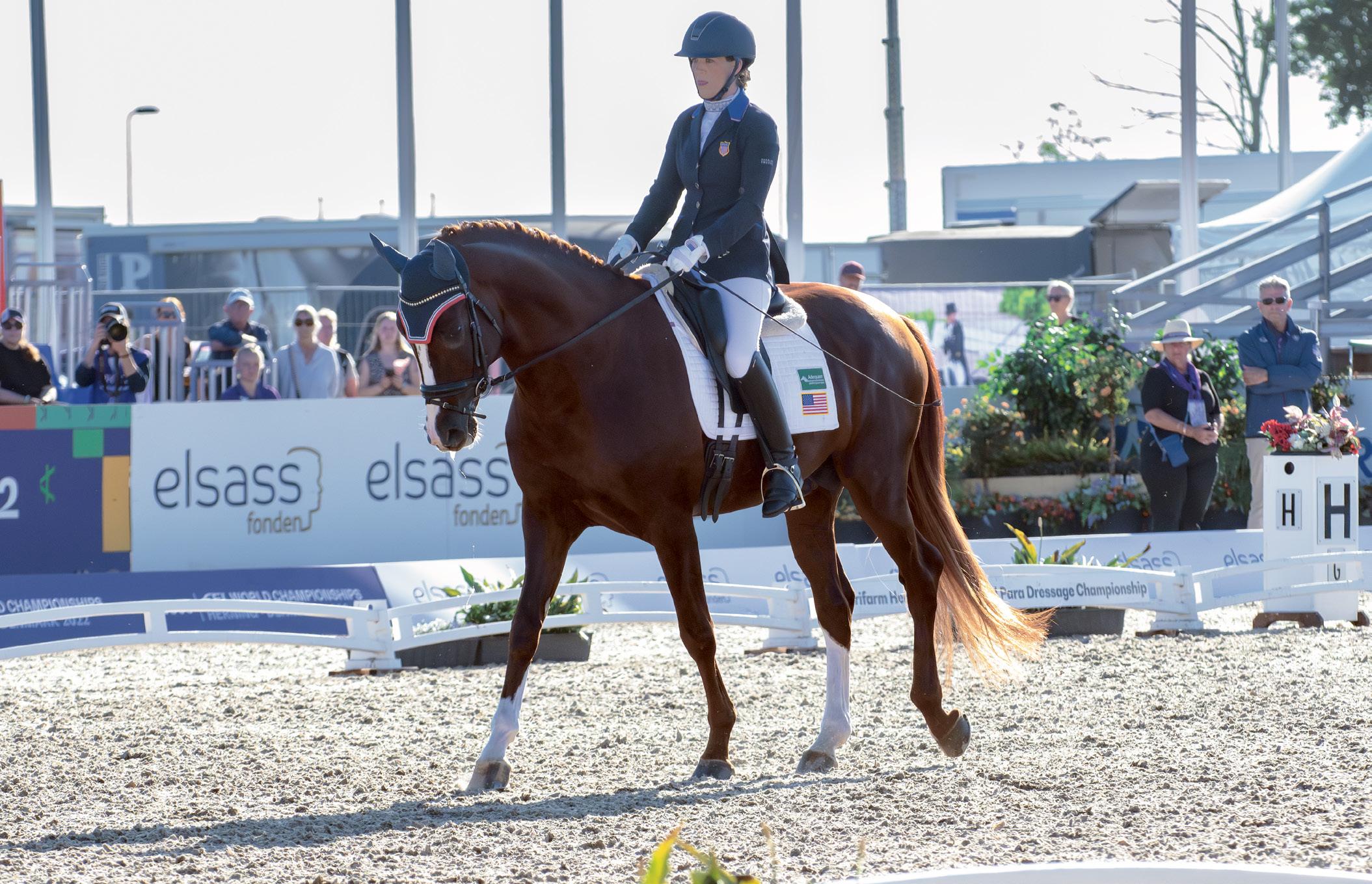
USDF CONNECTION | July/August 2023 43
JENNIFER BRYANT
DUAL-CAREER STALLION: The young Oldenburg Fortunato H2O has a busy breeding schedule when he’s not competing for Team USA. He’s shown with rider Roxanne Trunnell at the 2022 FEI World Para-Dressage Championships in Herning, Denmark.
What About Supplements?
The experts we interviewed don’t take a “kitchen sink”’ approach to feed supplementation. Instead, they administer supplements to meet specific nutritional needs or in certain circumstances.
For shiny coats. “Some dietary ingredients might help coat quality, such as omega-3 fatty acids,” says North Carolina State University equine-nutrition and physiology professor Shannon Pratt Phillips, PhD. “Fish oil, if you can get horses to eat it, is a potent source of omega-3 fatty acids.”
For adequate hydration and electrolyte replenishment. Hard-working dressage horses sweat, so “they should always have a salt block, and maybe additional sodium chloride on days they are working harder in summer,” says Peggy Devens, barn manager for Marcus Fyffe Dressage in Florida. “I’ve always given horses electrolytes, especially here in Florida. Horses need to drink a lot of water, and we have to find ways to get them to drink more. We do that with electrolytes, and at their noon meal I also give them a little scoop of salt.”
after coming home. This can take a lot out of a stallion if he’s not fed properly, especially if he’s still young and growing,” Hansis says.
Kidd’s breeding stallions receive alfalfa hay and a concentrate for horses in light work. “The ones in active work and competing as well as breeding are given a lot more alfalfa. We also give them a feedthrough gastric-care concentrate or supplement to help prevent ulcers. That’s another reason we like alfalfa for stallions; it is very kind to the gut and can help prevent ulcers—which can be an issue during breeding season if they are also in work.”
Feeding foals and young horses. A foal’s breed and metabolism, combined with how much milk its dam produces, will determine what and how much it needs to be fed.
Kidd, for one, believes in starting out by feeding foals what nature intended.
For optimal joint function. As dressage horses age, they may benefit from oral supplementation with ingredients shown to help improve joint function, says North Carolina State University professor of equine nutrition and management Paul Siciliano, PhD.
For overall health, including reproductive health. Kendra Hansis, owner of Runningwater Warmbloods in New Jersey, regularly supplements her mares, stallions, and young horses with vitamin E, usually in liquid form poured over the grain. Vitamin E is essential for muscle health and is also a good antioxidant.
For correct, strong young limbs. Hansis feeds a paste supplement to her foals and young horses that provides a balance of calcium, phosphorus, and other important minerals. “This can really help with any foal that has lax tendons or contracted tendons, or angular limb deformities,” she explains.
For happy guts. Hansis gives ulcer medication to foals that will be traveling at weaning time, explaining, “Many people don’t realize that young horses can get ulcers, but they have to endure stressful times during their first year, with weaning and possible transport.”
To further combat the effects of stress, Hansis regularly administers a probiotic paste to her foals, particularly before and after stressful events.
“You want to keep them happy—eating and drinking,” she says. “By the time they reach six months of age, their gut is changing and they are better able to digest hay.”
“After they foal, we believe in letting the mares feed the foals,” she says. “Foals get what they need from those mares. Our focus is on getting good nutrition into the broodmares.”
Duren agrees that “to produce a sound sport horse, you start with proper mare nutrition.” But he believes that “feed should be introduced into that foal’s diet by about three weeks of age—feed it can consume without the mare eating it.”
Duren issues a word of caution regarding the feeding of warmblood foals, saying, “These foals are often similar to their dams in that they will be big. The mistake some people make is selecting a feed designed for a young, growing horse; but because the foal is large and they don’t want it to grow too fast and have skeletal developmental issues, they underfeed. They control the energy content of the diet but don’t give adequate
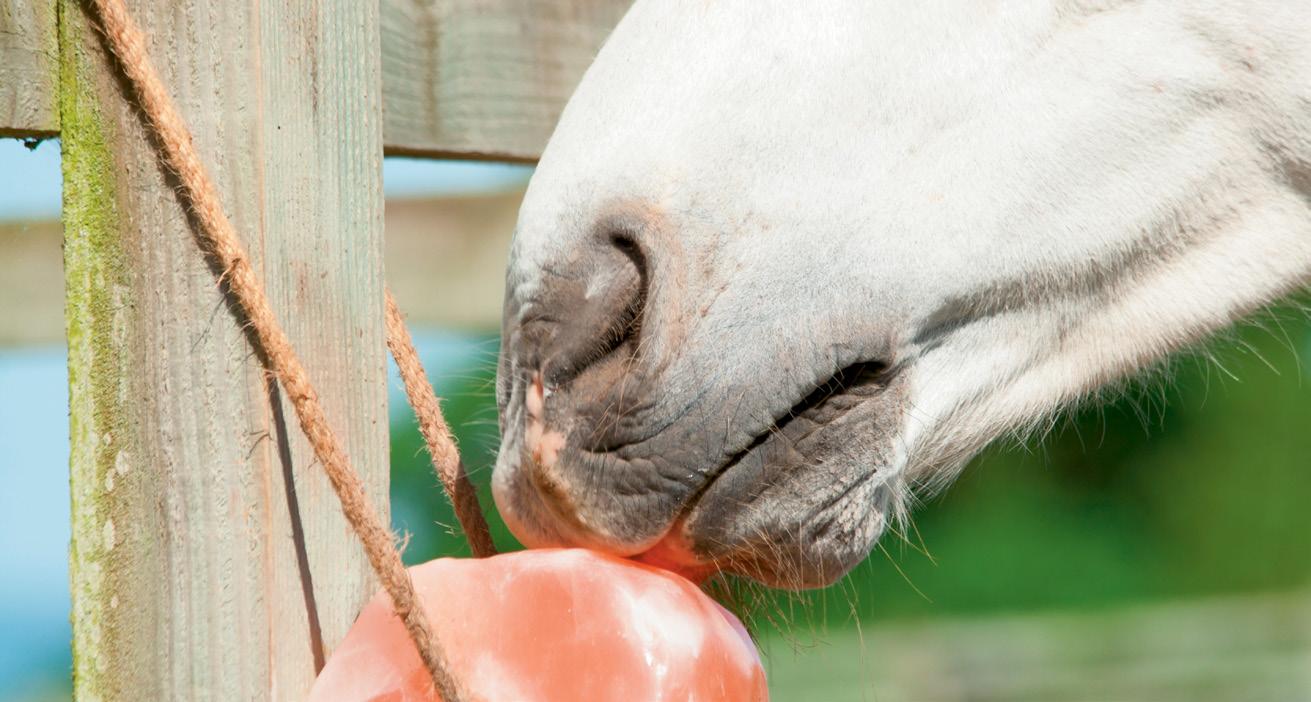
44 July/August 2023 | USDF CONNECTION
SHUTTERSTOCK
EQUINE ESSENTIAL: All horses need access to a salt block
vitamin and mineral fortification to nurture the developing skeleton.”

His solution: “I complement mother’s milk with a ration balancer for the foal, because mare’s milk, though it is adequate in energy and protein, doesn’t have enough of the trace minerals the foal needs. By using a ration balancer or supplement pellet for the foal, these needs are met.” However, “If a mare is not milking very well and the foal needs more calories, a traditional concentrate product designed for a young, growing horse would be appropriate,” Duren says.
“I want visual assurance, however, that the foal is eating it,” he continues. “I don’t want the mare eating with the foal. She can eat a couple pounds of supplement much faster than the foal can.” A foal can also get shortchanged if the farm creep-feeds a group of foals on pasture, because dominant foals may eat too much while others don’t get enough, he cautions. To avoid this problem, many breeding farms bring mares in once a day for a repro check, and the foals can be fed individually while they’re in the stalls with their dams.
After a foal is weaned, it’s easier to determine exactly what it is eating. According to Duren, “Lactation peaks at about 60 days, then begins to decline. By that time, we need to make sure the foal is eating supplemental feed, whether it’s a grain concentrate or a ration balancer, so that when we wean the foal, he is used to the routine and the feed.”
Duren points out that warmbloods are slower to mature than some other breeds—a factor that affects what and how they should be fed while they grow and develop.
“Due to the larger size and stature of the warmblood, these youngsters do not reach mature height
as early as a young Thoroughbred. They are slower-developing and continue to gain in height and mass for a longer time,” he says. That’s why, while other breeds may need higher-energy concentrates, warmbloods tend to do well on lowerenergy ration-balancer pellets.
And don’t try to get your youngsters rotund. “It’s actually healthy to see the faint outline of a rib on a yearling warmblood,” says Duren, “rather than having these youngsters too fat. We are feeding for slower growth.”
“With warmblood horses especially, some people set them up for failure and contribute to OCD by overfeeding them, especially as weanlings and yearlings,” says Kidd.
Yes, yearlings can be gawky. “We call them yaklings because they are hairy and funny-looking,” Kidd quips. “It might mean you can’t show them, but we feel it’s better to set them up for future success; we don’t want to overfeed them at that stage. It’s OK to have a little rib showing as long as they are healthy. It’s hard for people to see them in that funky stage, but we need to resist the urge to overfeed them.”
In feeding the youngster, says Hansis, “The emphasis should be on providing an adequate ration that is well balanced, with the proper amounts of all the nutrients they need for growth. And free-choice hay is absolutely required for any growing horse.”
Likewise, the staple for Kidd’s youngsters is orchard grass/alfalfa hay. After weaning, the babies begin receiving a ration balancer “and feed aimed at growth rather than high energy.”
Performance Starts from Within
If a horse doesn’t eat well, it can’t perform or develop correctly. That’s
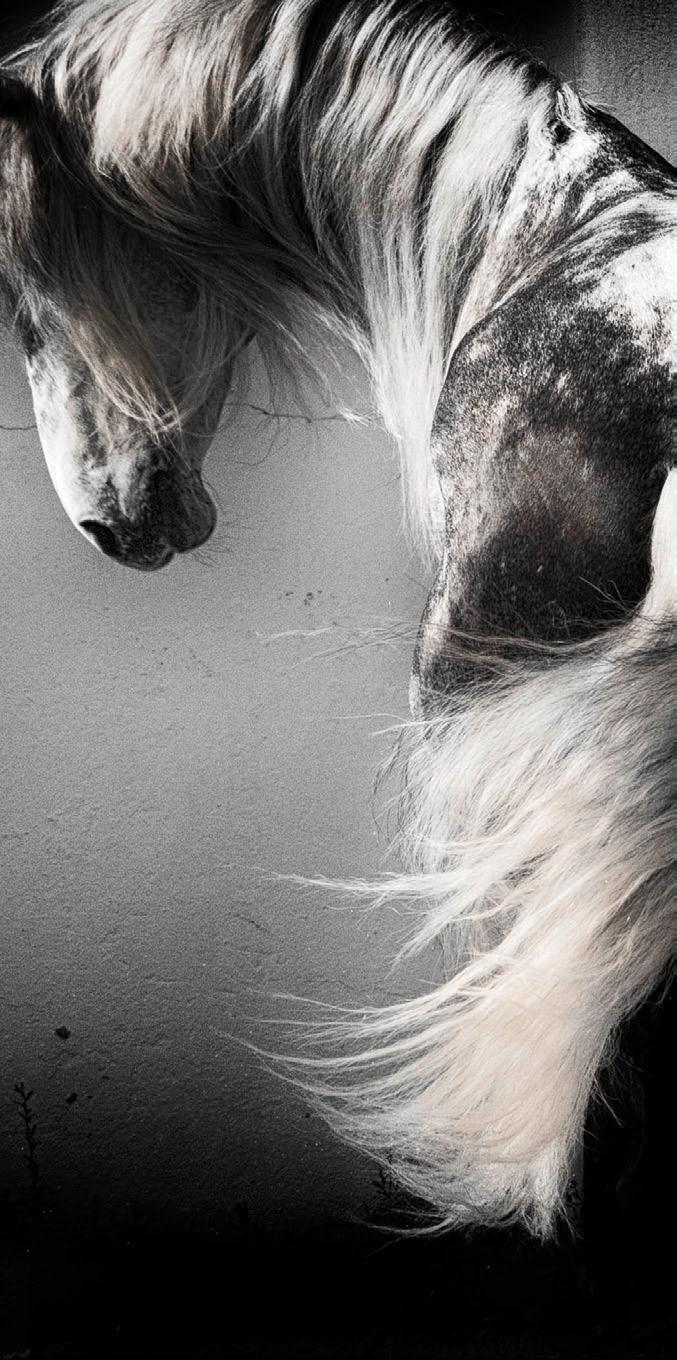
why Devens insists on feeding the horses in her care herself every morning.
That way, she says, “I know which horses are happy with their grain and which ones are not. I make sure that they are all hungry and willing to eat. You have to listen to your horse.”
Heather Smith Thomas raises cattle and a few horses on a ranch near Salmon, Idaho. She has raised and trained horses for 50 years and has been writing articles and books about them for nearly that long.
USDF CONNECTION | July/August 2023 45
Submit your dressage stories, content, and photos to yourdressage@usdf.org www.yourdressage.org
Prepare for the Worst
Of course you hope for the best—but when severe weather threatens, you’d better have a plan in place. First of two parts.
BY JUDY NAUSEEF
SEEKING SAFETY: Horses try to find higher ground in the wake of catastrophic flooding

46 July/August 2023 | USDF CONNECTION
As I write this, it’s been a little more than three weeks since a tornado ripped through our 10-acre Iowa farm in late March. I was already working on the article you’re reading, but now the topic of disaster preparedness has particular relevance.
Thankfully, in our case, the two horses, the dog, and my husband and I survived without injury. The farm itself wasn’t so lucky, although the damage could have been much worse. The 30-year-old run-in shed stood, keeping the horses safe. The fencing enclosing the horses was nearly down in some places, but it kept them in. The rest of the fence was torn out. The hay barn lost part of its roof and one side collapsed, but the hay was still there and stayed dry.
The entire property, especially around the house, was littered with large pieces of metal that had wrapped themselves around trees. Our 50-year-old maple trees stopped a neighbor’s dumpster and one-ton steel bin from crashing into our house. The house itself sustained porch and roof damage but otherwise was intact. The debris was from a friend’s farm a half-mile away; he lost nearly everything. We lost many large trees and much of my garden.
The aftermath of the storm stretched from days to a week and more. Cleanup and repairs are ongoing, and we’ve spent hours contacting insurance agents and contractors. I think back on our preparation on the day of the event, as well as in the months and years prior, and I am sure we should have done more. Here’s what I learned for next time—because in today’s increasingly volatile climate, it’s wise to assume there will be a next time.
Make a Plan
Don’t wait until an ominous forecast to get your horses and your farm ready to weather a storm, or to evacuate if it becomes necessary. Get your emergency plan in order well in advance. Here’s what you need to do.
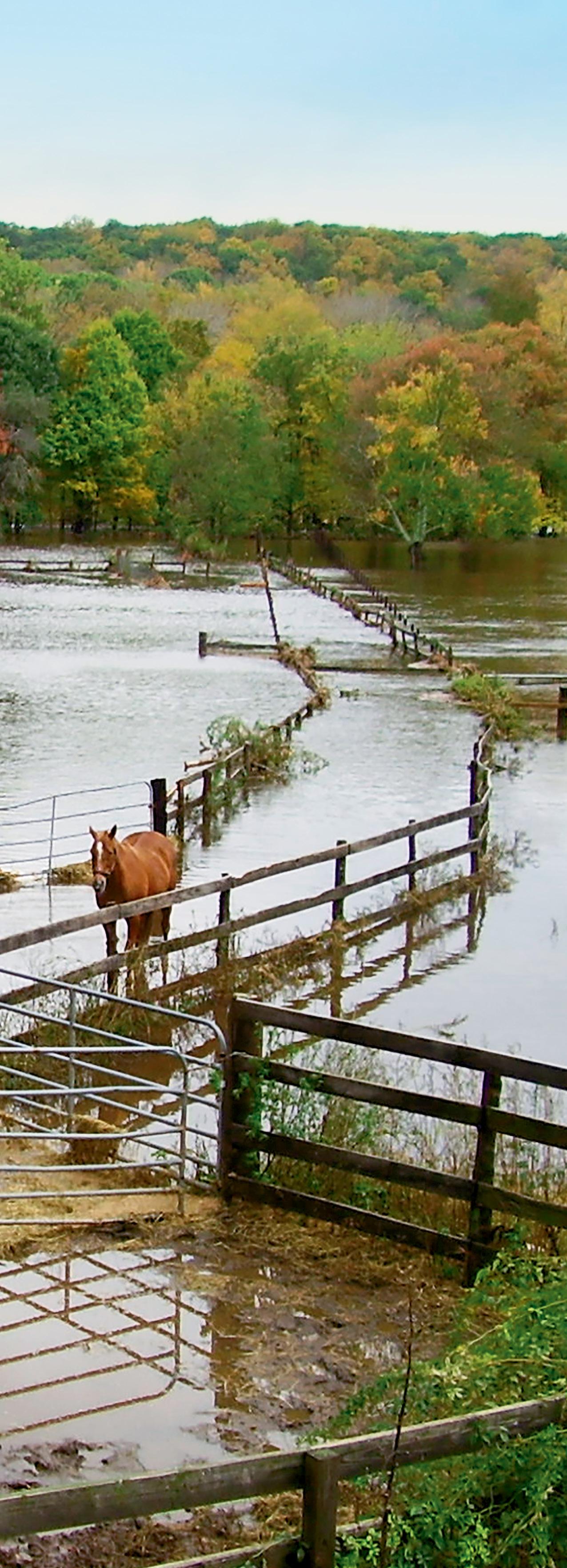
Invest in several sturdy flashlights, and keep fresh batteries on hand. Check them regularly and replace batteries as needed. Spotlight models throw extra light, and headlamp styles are handy when you need both hands free.
Make an evacuation plan. If you don’t own a truck and trailer, or if your rig alone isn’t enough to remove all horses from the property, work with boarders or other area horse and farm owners to create a list of people willing to evacuate horses. Include drivers’ mobilephone numbers and how many horses their trailers
USDF CONNECTION | July/August 2023 47
LAURA STONE/SHUTTERSTOCK
hold. Review the list periodically to ensure that it’s up to date.
Identify farms, show grounds, or other facilities within driving distance that are willing to take evacuated horses. Make a list of names, addresses, and contact information.
Get paperwork in order. Keep personal and farm records up to date and in a safe and easily accessible place. Include health and medication records for both humans and horses.
All horses should have a tetanus toxoid vaccine within the past year. Due to the increase in mosquitoes
after massive rainfall, all horses should receive West Nile virus and Eastern/Western encephalitis vaccines at the beginning of the hurricane season, if your area is prone. A negative Coggins will be necessary if the horse needs to be evacuated to a community shelter or across state lines, and a health certificate is required to cross state or international lines. If you live near a border, you may need one. Check state regulations.
The North Carolina State University Extension Service offers a list of necessary documents for traveling
Choosing a Generator
When power goes out, the need to supply horses with drinking water is of primary concern. Many farms rely on well pumps, so no power = no water. That’s why lots of farm owners invest in standby electric generators, either smaller portable models or permanently installed units.
How big and powerful a generator your farm needs depends on the property size, number of horses, typical length of outages and how common they are, amount of power needed to run the well pump (and what else you want to be able to operate during an outage), how portable the generator needs to be, and how much space you have to safely store fuel. Talk to an electrician, the well service, and generator vendors to help you select the type, size, and fuel type that’s best for your situation.
portable or permanently installed, like the one pictured--can power essentials (or even entire buildings) during outages
For an overview on choosing and operating standby electric generators, including a safety video, see this information page from North Dakota State University: ndsu.edu/agriculture/ag-hub/ag-topics/ag-technology/machinery/ standby-electric-generators.
The Outdoor Power Equipment Institute (OPEI), a manufacturers’ trade association, offers information about buying and using generators safely, as well as storm-preparedness tips, at its website, opei.org (type “generator” into the search box).
with horses, as well as tips on disaster preparedness, evacuation, first aid, and other useful information, at ncdisaster.ces.ncsu.edu/2016/10/ horses-and-horse-farms-hurricanepreparedness. (For additional disaster-preparedness resources, see “Important Resources” on page 51.)
Collect emergency-contact information. Maintain an up-to-date list of horses’ names, owners’ names, horses’ identifying information (see “Equine-Safety Action Plan” on page 50), and any specific handling instructions. Keep a list of phone numbers and e-mail addresses for owners, grooms, and riders. Take detailed identifying photographs of each horse.
Also have on hand: contact information (and account numbers, if applicable) for insurance companies (farm, home, medical, equine, vehicle), utility companies, telecommunications providers, emergency services, and fence and building contractors. You may need to have a name for a contractor who can repair a broken water line.
Consider investing a standby electric generator. In the event of severe weather, you may lose power. Decide what must stay on—the wellwater pump, lights, refrigerator, and so on—and purchase a unit that will generate sufficient electricity to power these items. (See “Choosing a Generator” at left for more.)

Keep enough hay and grain on hand. Have enough grain, supplements, and medications to last at least one week—although some farm owners have learned to stockpile more.
“I learned from experience that I really need to have one month of hay and grain on hand” in case a storm disrupts the supply chain, says Jean Kaplan Thornton, a
48 July/August 2023 | USDF CONNECTION
SHUTTERSTOCK
BACKUP PLAN: Standby electric generators—either
USDF gold medalist and USDFcertified instructor/trainer through Second Level who owns and operates Equivale in DeLeon Springs, Florida. As a 24-year central Florida resident, Thornton has experienced many hurricanes, and has found that advance-warning times can vary wildly, from as much as five days to as little as three hours, in the case of Hurricane Charley in 2004.
Assemble a supply of tools and first-aid items for horses and humans. Fence-repair materials, chain saws, wire cutters, heavy work gloves, crowbars—these and more may be needed to deal with storm damage to buildings, trees, or fencing. The NCSU Extension’s hurricane-preparedness webpage listed above includes a suggested list of tools to have on hand.

Veterinarians and emergency services may not be able to reach your property as quickly as usual, so be sure you have well-stocked equine and human first-aid kits, as well (see “Important Resources”).
When a Storm Looms: Final Preparations
You have an emergency plan in place, and now the weather forecast isn’t looking good. As you monitor the weather reports, see to the following while there’s still time.
Have a trusted weather app on your phone. Buy a weather radio— especially important if at your farm you cannot hear sirens activated in your county or nearest town.
Take safety precautions as advised by the apps and TV/radio reports. Secure all items that high winds could turn into weapons. Store jumps and lawn furniture in a safe place. Park trucks, trailers, and farm equipment in areas where trees will not fall on them. Remove items
hanging in hallways and barn aisles. Bring pets indoors. Secure barn cats in the tack room or other indoor space.
Charge all cell phones, portable electronic devices, and power packs. Make sure your supply of batteries for flashlights and other devices is ample.
Fill water troughs, buckets, and other clean or lined containers with fresh water. An idle horse of average size drinks six to as many
as 15 gallons each day, and more if it’s hot or he’s working, according to the American Association of Equine Practitioners (AAEP). Fill plastic-lined garbage cans, as well. If necessary, adding two drops of chlorine bleach per quart will purify contaminated water; let it sit for 30 minutes before allowing animals to drink, according to North Carolina State University Extension animalscience representative Alaina Cross.
As part of Jean Thornton’s hur-
USDF CONNECTION | July/August 2023 49
GO TIME: When one of these (or a tornado, or a wildfire, or…) is bearing down, it’s time to execute your disaster-preparedness plan. Satellite image shows Hurricane Ian approaching southwest Florida in September 2022.
NOAA PHOTO/PUBLIC DOMAIN
Lucky Breaks and Lessons Learned
Sometimes severe weather arrives with very little warning. Just ask Tammy Lisi, owner of the dressage facility Tamarack Stables in Anamosa, Iowa, which was nearly flattened by a surprise severe storm in 2020.
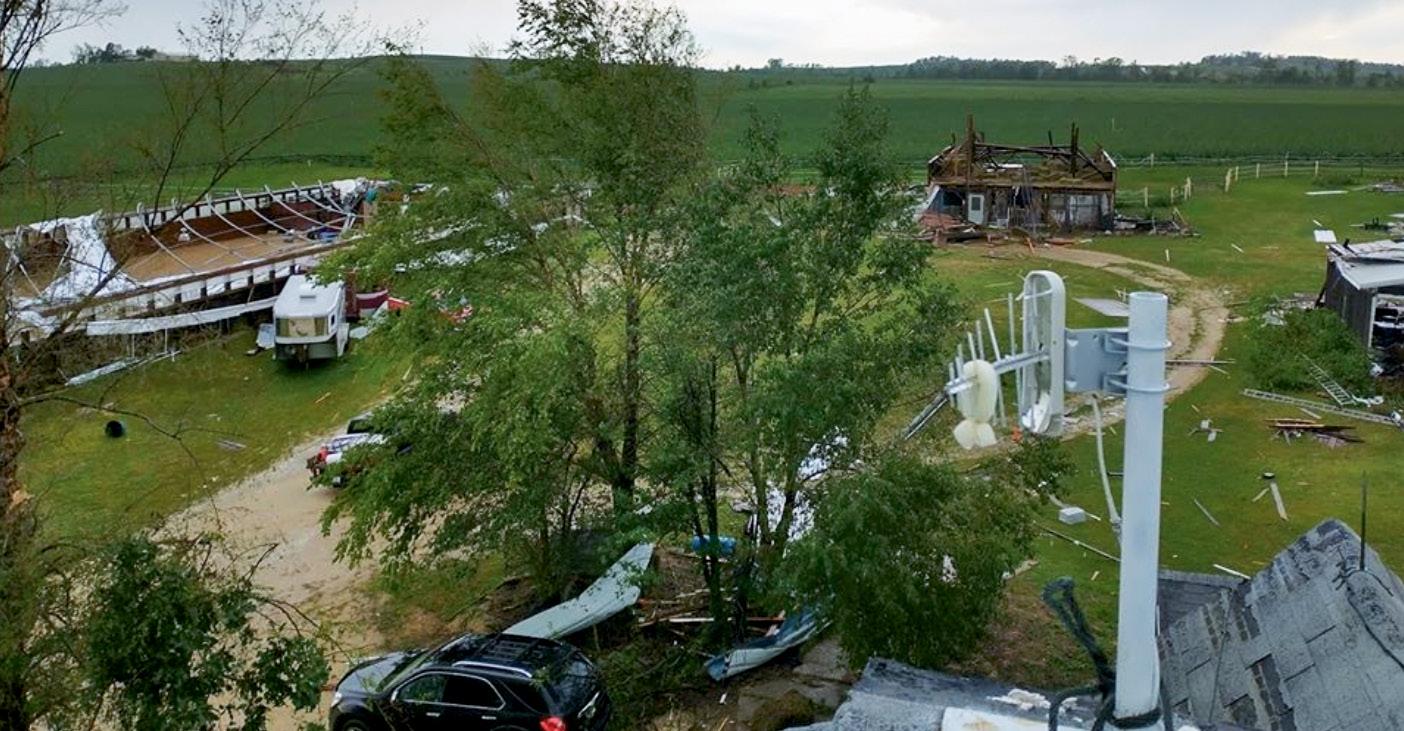
Summer thunderstorms are a way of life in the Midwest, and Lisi heard a typical forecast of storms predicted for that August afternoon. “I did my normal bring-in of horses about an hour before it hit,” she recalls. There was no warning that something far more dire was approaching until her husband, Tom, texted her from work, urging her to “Take cover NOW!” Less than five minutes later, as Lisi sat on her couch frantically searching for weather information, her windows blew out.
ricane prep, “I have always filled all of my water troughs, but I learned through experience that they should either be covered or brought under cover,” she says. “You should fish all the sticks and debris out of the water immediately after the storm passes.”
Fill clean jugs with tap water for human consumption. If power goes out, households that rely on well water will lose access to water.
Store grain in watertight containers. Protect hay from wind and rain by stacking bales on pallets and covering tightly with water-repellent tarps.
Equine-Safety Action Plan
Before disaster looms, think about how best to keep the horses in your care safe.
What hit was a derecho, a long-lived, widespread storm characterized by powerful straight-line winds, usually in conjunction with fast-moving severe thunderstorms. “Our farm experienced winds in excess of 120 miles per hour for an estimated 45 minutes,” Lisi recalls. The winds destroyed the barn roof (the horses survived), indoor arena, fencing, and stored hay; the house was rendered uninhabitable.
In one incredible stroke of luck, “We had found out in July that our carrier had dropped insurance on our indoor riding arena” due to some previous storm damage, Lisi says. “We put [a new] policy in place and paid for it in full at 10:30 a.m. the day of the derecho. By 1:30 p.m., [the structure] was leveled.” Lisi sums up the lessons learned and steps taken as a result of the storm.
1. If she had it to do over, “I would have chatted with my insurance agent every year. I now have an excellent lawyer and can identify the best private adjuster in the area. I fully understand my insurance policy and how to deal with adjusters.”
2. After the storm, the Lisis purchased “a full farm generator.”
3. “We rebuilt and reinforced the power station that feeds all our buildings.”
4. “Always keep cash on hand in a locked safe. When power is out for multiple days and communication is down, cash is king.”
5. Keep all fuel tanks full.
Nearly three years later, the Lisis are still living in a camper because their house remains structurally unsound, she says. The main barn has been rebuilt, but “We are gearing up for another construction season after a long battle with our insurance company; we won, but it was a slow process.” Lisi remains grateful for the help and support they received from friends and neighbors, saying, “The people in our lives made it bearable.”
Will they be best off in your wellbuilt barn, with stalls and doors you can secure? In an indoor arena? Or might they be safer outside in pastures or paddocks? Opinions vary, as do individual circumstances. There is always the chance that a barn or other building could collapse in a storm, or that a horse outdoors could be injured by flying debris or a falling tree. Know your horses, your farm, and your neighborhood. Are there obstacles or dangers beyond the fences? Are there any potential hazards in turnout areas? If heavy rain is predicted, is there a location on the property that’s especially flood-prone?
Whatever you decide, before the storm arrives, place identifying information on each horse. Options include a breakaway halter with identifying and contact information sealed in a zip-lock bag and ducttaped to the halter; owner’s name and phone number written on the horse’s body in livestock marker;
50 July/August 2023 | USDF CONNECTION COURTESY OF TAMARACK STABLES
DEVASTATED: What was left of Tamarack Stables in Iowa after an August 2020 derecho
and a waterproof luggage tag containing contact info, braided into the horse’s tail. Use more than one method. Thornton now braids cow ear tags into horses’ manes.
After the Storm
That fateful March day, my husband and I were working from home, but after a point we could no longer concentrate, so we turned on the television to watch the weather reporters track the storms. As the red boxes of bright colors moved through towns closer and closer to us, we could hear our weather radio and cell phones alerting us to seek shelter.
The power out, we took refuge in our basement family room with blankets and flashlights. As the tornado came through, the sound was of rain and persistent wind. Eventually the noise stopped, and we ventured upstairs to assess the damage.
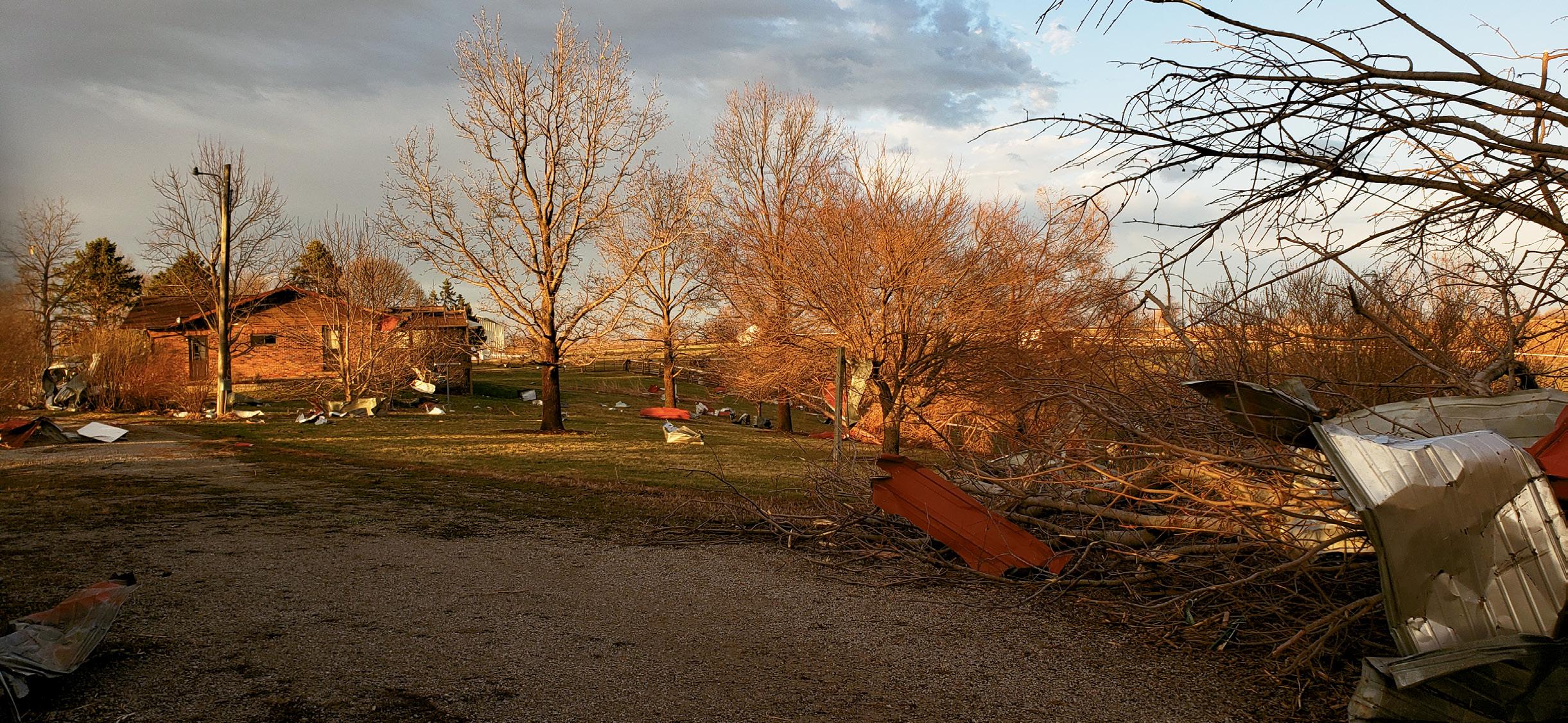
After a storm passes, inspect each horse for injuries, including its eyes. Check legs and feet carefully for punctures, cuts, abrasions, and heat. Look for signs of lameness. If a horse is missing, notify local police and sheriff, and post a notice with
photo on social media, including your personal and farm’s pages and any area horse-related groups.
Check the property for hazards, such as hanging or downed utility lines. Do not try to move lines yourself; report the damage to your local utility company. Shut off electricity in any damaged buildings. Look for damaged fencing, and relocate horses to a secure area if needed. Move debris that poses an immediate threat to horses or people, but take photos of all damage for insurance-claims purposes before cleanup begins.
In part 2 of this series, we’ll delve into what show management and competitors need to know in the event of an impending severeweather threat at a dressage show.
Important Resources
The American Association of Equine Practitioners (AAEP) publishes links to national resources and disaster-planning advice on its Owner Emergency and Disaster Preparedness page: aaep.org/horseowners/owner-guidelines/owneremergency-disaster-and-preparedness. Suggested equine first-aid items are listed in the Disaster Planning links. Discuss any additional or special needs, such as tranquilizers, with your veterinarian.
Assemble your human first-aid kit with help from the American Red Cross: redcross.org/get-help/how-toprepare-for-emergencies/anatomy-ofa-first-aid-kit.html.
Judy Nauseef is a freelance writer interested in equestrian and gardening topics. She lives on an acreage with her husband, two horses, one dog, and many gardens. Find her at JudyNauseef.com.
See the Federal Emergency Management Agency’s (FEMA) list of “10 Items to Include in Your Emergency Kit”: fema.gov/blog/10items-include-your-emergency-kit.
USDF CONNECTION | July/August 2023 51
JUDY NAUSEEF
THE AFTERMATH: After a tornado went through the writer’s farm, debris from neighboring properties was scattered around the landscape
Building the Para-Dressage Pipeline
Through designated Centers of Excellence, US Equestrian aims to expand the sport, beginning at the grass roots
 BY RILEY GARRETT
BY RILEY GARRETT
GATEWAY TO PARA-DRESSAGE: Thorncroft Therapeutic Horseback Riding Inc. in Pennsylvania, a USEF Para-Dressage Center of Excellence, in April hosted a USEF Para-Dressage Development Clinic. USEF para-dressage development coach Lisa Hellmer works with Victoria Yu, Coatesville, Pennsylvania, on Thorncroft’s Rusty, a 19-yearold Quarter Horse gelding donated by Jason and Kristine Lisi.
52 July/August 2023 | USDF CONNECTION
The US has no system of community riding clubs, and the sport of dressage has no official training centers in this country. But one equestrian discipline is creating its own means of attracting and developing aspiring athletes for competitive sport: para-dressage.
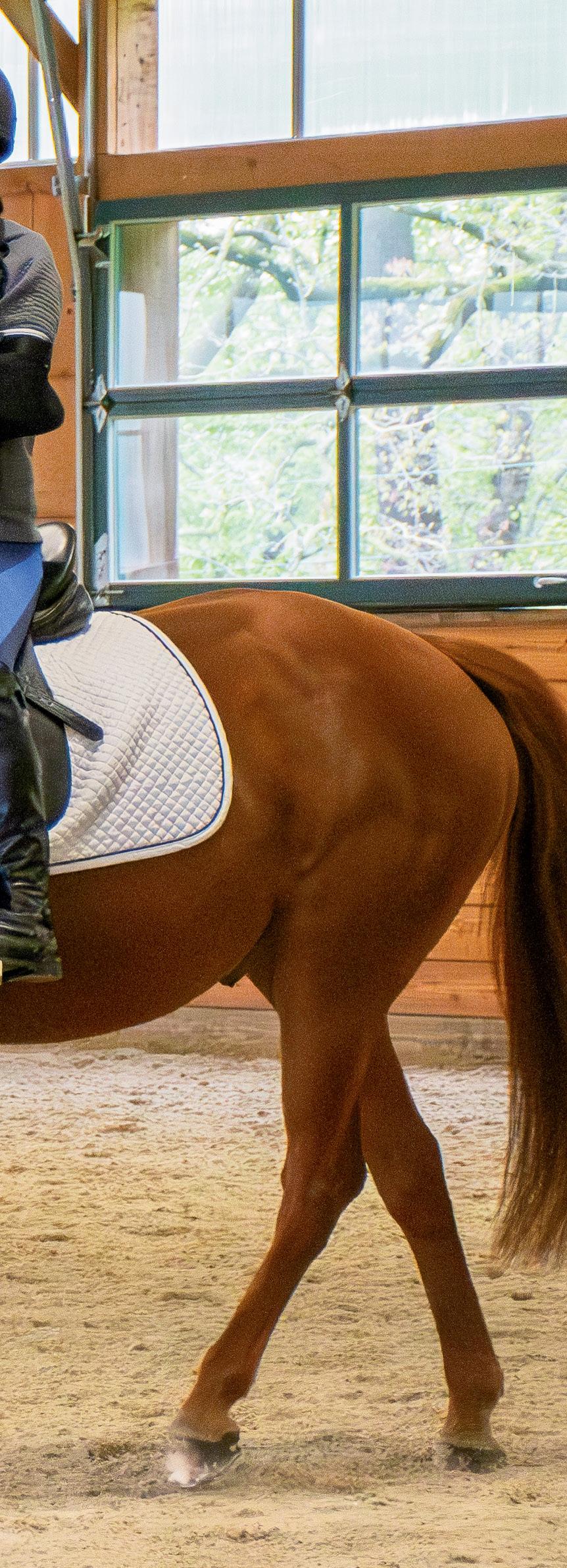
In 2015, working with US Equestrian Federation (USEF) para-equestrian director Laureen Johnson and USEF para-dressage technical advisor Michel Assouline, then USEF director of sport programs Will Connell created a designation for para-dressage training facilities: the USEF Para-Dressage Center of Excellence (COE).
Any equestrian training facility that follows the program’s specified guidelines and criteria may apply for the COE designation. To become a COE, a facility must offer para-equestrian sport programs for athletes with disabilities, including para-dressage: lessons with certified coaches and trainers, competition and educational opportunities, classification into the para-dressage athlete grades (see “Introduction to Para-Dressage” on the next page), and access to adapted equipment and facilities. A COE also provides outreach and education programs to the local community in order to promote awareness and understanding of para-equestrian sport. The USEF Para-Equestrian Sport Department, which oversees the COE program, is responsible for ensuring that COEs meet the program’s standards and guidelines.
“I love being able to provide opportunities to new athletes considering para-dressage through education, clinics, and various opportunities,” says US ParaEquestrian Association (USPEA) vice president Carole Laulis, a USEF para-dressage silver coach based at Thorncroft Equestrian Center, Malvern, Pennsylvania, a para-dressage COE (see page 54). “Being a COE is an opportunity to offer newly disabled individuals a safe space to explore the equestrian sport and guide them in the process, which is so empowering and joyful.”
The USEF and the USPEA aim to develop a pipeline from the introductory levels to high performance, creating opportunities for developing para-dressage athletes. Equipped with USEF-certified para-dressage coaches like Laulis, the COE sites are positioned to attract new and aspiring athletes and then to help them advance.
Meet the COEs
At press time, eight equestrian centers held the USEF COE designation. They are:
Carlisle Academy at Spring Creek Farm, Lyman, Maine. Founded in 1998 as the Equest Therapeutic
USDF CONNECTION | July/August 2023 53
JENNIFER BRYANT
Riding Center, Carlisle Academy has since expanded to offer a range of equine-assisted activities and therapies. In 2011, the program was renamed Carlisle Academy Integrative Equine Therapy & Sports.
Healing Strides of VA, Boones Mill, Virginia. Established in 1991, this facility, located south of Roanoke, offers a range of therapeuticriding programs for individuals with disabilities. In addition to its paradressage COE designation, Healing
Introduction to Para-Dressage
Para-equestrian dressage (“para” is short for parallel, as in parallel to the able-bodied sport counterpart) is a dressage discipline designed for riders with permanent, measurable physical disabilities. The sport is governed by the International Equestrian Federation (FEI) and is included in the Paralympic Games.
Para-dressage athletes are assessed by a panel of specially trained national USEF or international FEI classifiers and, if deemed eligible to compete, are each assigned a grade based on their level of impairment, with Grade I athletes being the most impaired and Grade V athletes being the least impaired. The classification system considers the rider’s balance, coordination, strength, and range of motion, as well as the impact of their impairment on their riding abilities. Each para-dressage grade has its own dressage tests, which range from walk-only (Grade I) to walk-trot-canter with lateral movements in trot and canter (Grade V).
Strides of VA is also a Professional Association of Therapeutic Riding International (PATH) Premier Accredited Center.
Maryland Therapeutic Riding, Crownsville, Maryland. This facility, the newest COE on USEF’s roster, offers adaptive and therapeutic riding; equine-assisted psychotherapy; speech, occupational, and physical therapy; education and mentoring; school groups and summer camps; equine services for heroes, and riding for wellness.
North Texas Equestrian Center, Wylie, Texas. NTEC owner and head trainer Kai Handt has coached Paralympic dressage riders and is a former US national para-dressage chef d’équipe and technical advisor. A native of Germany, Handt established NTEC in the greater Dallas area in 1985 as a full-service dressage and jumping training and boarding facility.
Ride On Therapeutic Riding Center, Chatsworth and Newbury Park, California. This facility, founded in 1994, promotes the welfare of at-risk youth and people with disabilities through equine-assisted activities and therapies in its two locations in the greater Los Angeles area. Ride On managed and hosted the 2015 Special Olympics World Games equestrian competition, for athletes with intellectual disabilities.
Therapeutic Riding Inc., Ann Arbor, Michigan. Founded in 1984, TRI outgrew its original facility by 2001 and later was able to acquire 46 acres on which to build a new therapeutic-riding center, with construction completed in 2010. This COE also offers adaptivehorsemanship programs for people with varying needs and abilities.
Thorncroft Therapeutic Horseback Riding Inc., Malvern,
Pennsylvania. Established in the western suburbs of Philadelphia in 1969, Thorncroft specializes in therapeutic riding and other equineassisted activities for children and adults with mental, emotional, and physical disabilities. Carole Laulis, who has been an instructor there for 30 years, is a USEF para-dressage silver coach and the current USPEA vice president.
Wheatland Farm Equestrian Center, Purcellville, Virginia. The northern-Virginia facility offers programs for riders with disabilities as well as for able-bodied equestrians: from para-dressage to adaptive riding, Pony Club activities (Wheatland is also an inclusive USPC Riding Center) to eventing and able-bodied dressage. Co-founder Muriel Forrest is a USEF silver para-dressage coach.
The Pipeline Starts with Inclusivity
To earn the COE designation, a facility must meet specific criteria, including disability-compliant facilities, such as mounting ramps and accessible restrooms; USEFaffiliated and certified para-dressage coaches; FEI-standard arena footing; an indoor arena; and access to suitable horses.
Once accredited, a COE must undergo an annual review and periodically reapply in order to maintain its status. The USEF wants to see that a COE is an active participant in the process of developing the para-dressage sport, such as by hosting coach- or athlete-development seminars, hosting talent searches or championship competitions, participating in COE conference calls, and bringing riders to para-dressage competitions.
54 July/August 2023 | USDF CONNECTION
Although medals in national and international para-dressage competition may be the ultimate high-performance goal of USEF’s COE initiative, the COE overview published on the USEF website makes it clear that the intent of the program reaches far beyond the medal podiums.
The overview states that COEs “are also essential instruments in the continuous effort to make equestrian sports more equitable, inclusive, and available to disabled competitive riders in the United States…. [A]s the FEI has emphasized, the inclusion of disabled equestrians in our often-exclusive sport is inspiring to the general public, many of whom may not otherwise find themselves captivated by equestrian sport.”

Because “USEF commits to supporting the COEs annually through marketing, outreach, program sup-
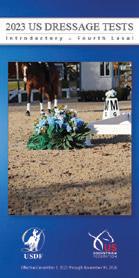



port, and possible access to USEF funding,” as the overview states, COE facilities can benefit from the increased visibility and support. Most important, the initiative can benefit aspiring athletes with physical disabilities by introducing them to the joys of horses and the sport of para-dressage.
To learn more about the USEF’s COE program, visit usef.org/compete/disciplines/para-equestrian/ para-equestrian-dressage-programsforms/centers-of-excellence.
Riley Garrett is a para-dressage rider and competitor, and an instructor at Thorncroft Therapeutic Horseback Riding Inc., Malvern, Pennsylvania, a USEF Para-Equestrian Dressage Center of Excellence.
USDF CONNECTION | July/August 2023 55 JENNIFER BRYANT
Testpro: USDF App On The Levels DVDs US Dressage Tests Booklet 2023 US DRESSAGE TESTS
ONBOARDING: COEs offer opportunities for riders to learn about para-dressage competition. At the USEF development clinic, Thorncroft therapeutic-riding regular Priya Russell, Drexel Hill, Pennsylvania, gets an assist from instructor and USEF para-dressage silver coach Carole Laulis (left) while a volunteer holds Thorncroft’s Rosie, a 23-year-old Quarter Horse/pony mare donated by Rita Chambers, and another rider looks on.
Made in America
The three US entrants wowed the home-country crowd at the 2023 FEI World Cup Dressage Final in Omaha

56 July/August 2023 | USDF CONNECTION
STORY AND PHOTOGRAPHS BY JENNIFER O. BRYANT
PROMISING DEBUT: US World Cup Dressage Finals first-timers Alice Tarjan and her American-bred mare, Serenade MF

USDF CONNECTION | July/August 2023 57
he only thing missing from the 2023 FEI World Cup Dressage Final presented by Havensafe Farm was the hoped-for matchup between the world’s current top two horses.

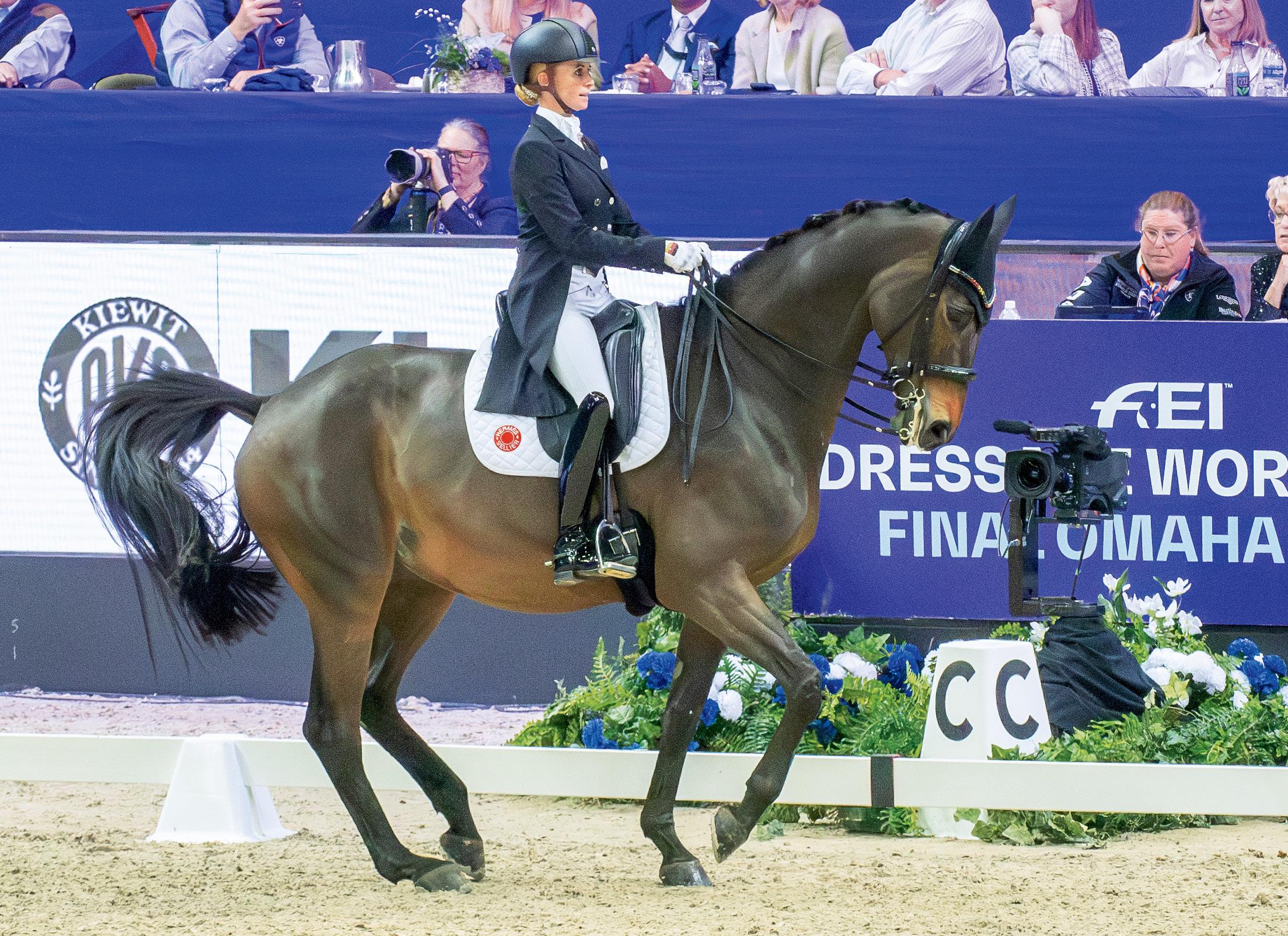
The stars of the FEI World Dressage Championships Herning 2022, Glamourdale and rider Charlotte Fry of Great Britain, sat out the 2023 World Cup Final because owner Van Olst Horses wanted its white-hot black KWPN stallion (Lord Leatherdale x Negro) busy in the breeding shed. And last year’s World Cup Dressage Final champion, TSF Dalera BB, stayed home from Herning because rider Jessica von BredowWerndl of Germany was soon to give birth to her second child at the time.
That disappointment aside, the largely American audience reveled in its first opportunity since 2017 to see the world’s top dressage horses (save one) compete on US soil. Following the World Cup Final’s well-received first staging in Omaha, Nebraska, that year, the 2023 Finals (in jumping and vaulting as well as in dressage) returned to Omaha, April 5-8 at the CHI Health Center Omaha Convention Center. The 1.1-million-square-feet structure easily swallowed under its single roof the 18,000-seat sports arena, spacious stable block, equine exhibition arena, and—best of all—unfettered access to the competition warmup arena, which was ringed on all four sides by the tempting wares of nearly 80 trade-fair vendors.
She’s All That
Dalera, a 16-year-old Trakehner mare (Easy Game x Handryk), led the way through the entire competition. Although the Grand Prix is
more of a formality at World Cup Dressage Finals, serving mostly to determine the order of the draw for the Grand Prix Freestyle and otherwise not counting toward the final placings, Dalera and von Bredow-Werndl notched a decisive GP win of 79.922% over the secondplace finisher, fellow German Isabell Werth on her 2022 World Championships mount, the 13-year-old DSP (German Sport Horse) gelding DSP Quantaz (Quaterback x Hohenstein) (77.485%). Third in the Grand Prix were the lone pair from Denmark, Nanna Skodborg Merrald on the 15-year-old Oldenburg gelding Blue Hors Zepter (Blue Hors Zack x Wolkentanz II), on 76.165%.
The FEI World Cup Dressage Final was created in 1984 as a means of promoting freestyle. It is the Grand Prix Freestyle alone that decides the annual champion. The Final is an individual-only competition for which horse/rider combinations worldwide strive to qualify in one of four designated geographic leagues. Qualifying is a prestigious achievement; typically only 18 pairs take part. A different city hosts the Final each year; the 2024 edition
will be in Riyadh, Saudi Arabia.
As the title defenders, von Bredow-Werndl and Dalera earned an automatic invitation to Omaha. After winning the Grand Prix, they claimed their second consecutive World Cup Dressage Final championship title, becoming the only pair to break the
58 July/August 2023 | USDF CONNECTION
T
C’EST BON: Riding to iconic French melodies, Germany’s Jessica von Bredow-Werndl and TSF Dalera BB danced away with the 2023 World Cup Dressage Final trophy
LOVE MATCH: Von Bredow-Werndl strokes the neck of the mare she called her soulmate during the victory lap
90% barrier with a final Grand Prix Freestyle score of 90.482%.
Dalera may be a powerhouse performer, but her long legs and slender neck lend her a dancer’s air, as does her nearly flawless balance. Von Bredow-Werndl showcased those elegant qualities by setting her freestyle to music by the quintessential French chanteuse, Edith Piaf; the rider commented afterward that hearing the Little Sparrow warble “Non, je ne regrette rien” as she piaffed and passaged down the final center line gave her goosebumps. The judges were enchanted by the pair’s piaffe-passage tour, balance— there were only a couple of bobbles, including a tiny step back after the initial halt before Dalera passaged away—and artistry, with the president of the ground jury, Janet Foy of the USA, awarding them a score of 99.600% for artistic presentation.
(For Foy’s take on the competition, see “Janet Foy: The View from C” on page 61.)
Given von Bredow-Werndl’s choice of music, it is a “nice coincidence,” as she put it, that next year’s Olympic Games will be in Paris, where she and Dalera will aim to defend their Tokyo 2020 team and individual gold medals.
Although von Bredow-Werndl is a fierce competitor in the show arena, she, like many other dressage riders, claimed that her favorite riding moments happen at home, when it’s just herself and the mare she called her soulmate.



“She is so special,” she said of Dalera. “I enjoy cantering through the forest as much as doing piaffe with her. She’s just such a special creature to spend time with.”
Although Isabell Werth clearly thought her freestyle performance was good enough for the win—she exited the arena with a confident smile and an index finger thrust skyward—she had to settle for third on a score of 85.761%. As she had in Herning 2022, the six-time German Olympian appeared to relish her “heart”-themed freestyle set to such 1980s hits as Bonnie Tyler’s “Total Eclipse of the Heart” and “Straight from the Heart.”
“Oh, that was super!” Werth enthused afterward. “That was his best freestyle, and he was so with me and the music. It was perfect. I was really happy.”
If Werth were a circus performer, her choreography would have been described as death-defying. “I have no time to breathe; no time to
think about what is going on” in the extraordinarily difficult freestyle, she said. In Omaha, Quantaz gave his rider “the security that he was with me [so] I could take risks. Because I have no choice in this freestyle. There is [sic] only risks. But it worked.” Among the feats the duo pulled off were a piaffe pirouette
USDF CONNECTION | July/August 2023 59
TO THE MAX: Isabell Werth always goes for broke, and this extended trot aboard DSP Quantaz was no exception
LIKE FATHER, LIKE SON: Denmark’s Nanna Skodborg Merrald rode Blue Hors Zack to World Championships team gold in Herning 2022. Zack’s son, Blue Hors Zepter, carried her to second place at the World Cup Dressage Final in Omaha.
ON THE PODIUM: Nanna Skodborg Merrald of Denmark, Jessica von Bredow-Werndl of Germany, and Isabell Werth of Germany
immediately following the entry halt and salute, one-tempis to a canter pirouette, and a canter pirouette directly into a piaffe pirouette.
Merrald improved her position in the freestyle to take second place on 87.146%, to a stirring instrumental version of “A Time to Say Goodbye.”
The Danish rider, who is the head trainer at the famed Blue Hors Stud, admitted that although she loves the music and thinks it fits “Zepter” perfectly, “The theme [saying goodbye] is a little bit weird. I will change it for the competitions.”
Merrald expressed astonishment at besting the great Isabell Werth, especially considering the fact that she had been paired with Zepter for only four months prior to Omaha. (The gelding had previously been campaigned by fellow Dane Daniel Bachmann Andersen.) The pairing and the placing were even more meaningful for Merrald because she rode Zepter’s sire, Blue Hors Zack, to team gold last year in Herning.
Strong Finishes for the US Pairs
As the host nation, the USA had the opportunity to send three horse/ rider combinations to Omaha. One veteran rider and two relative newcomers made the most of the opportunity, and all earned top-10 finishes.
Raves for the “Rave Horse.”
Putting in arguably their best freestyle performance to date was Captain America himself, Steffen Peters, San Diego, California, on Suppenkasper, his GP partner since the 2018 FEI World Equestrian Games in North Carolina. Affectionately known as Mopsie, the 15-year-old KWPN gelding (Spielberg x Krack C), owned by Akiko Yamazaki and Four Winds Farm, occasionally has a little trouble keeping his 18.2-hand frame in perfect balance but has extraordinary range, elasticity, and ability to collect. The pair finished fifth in the Grand Prix on 74.581%,

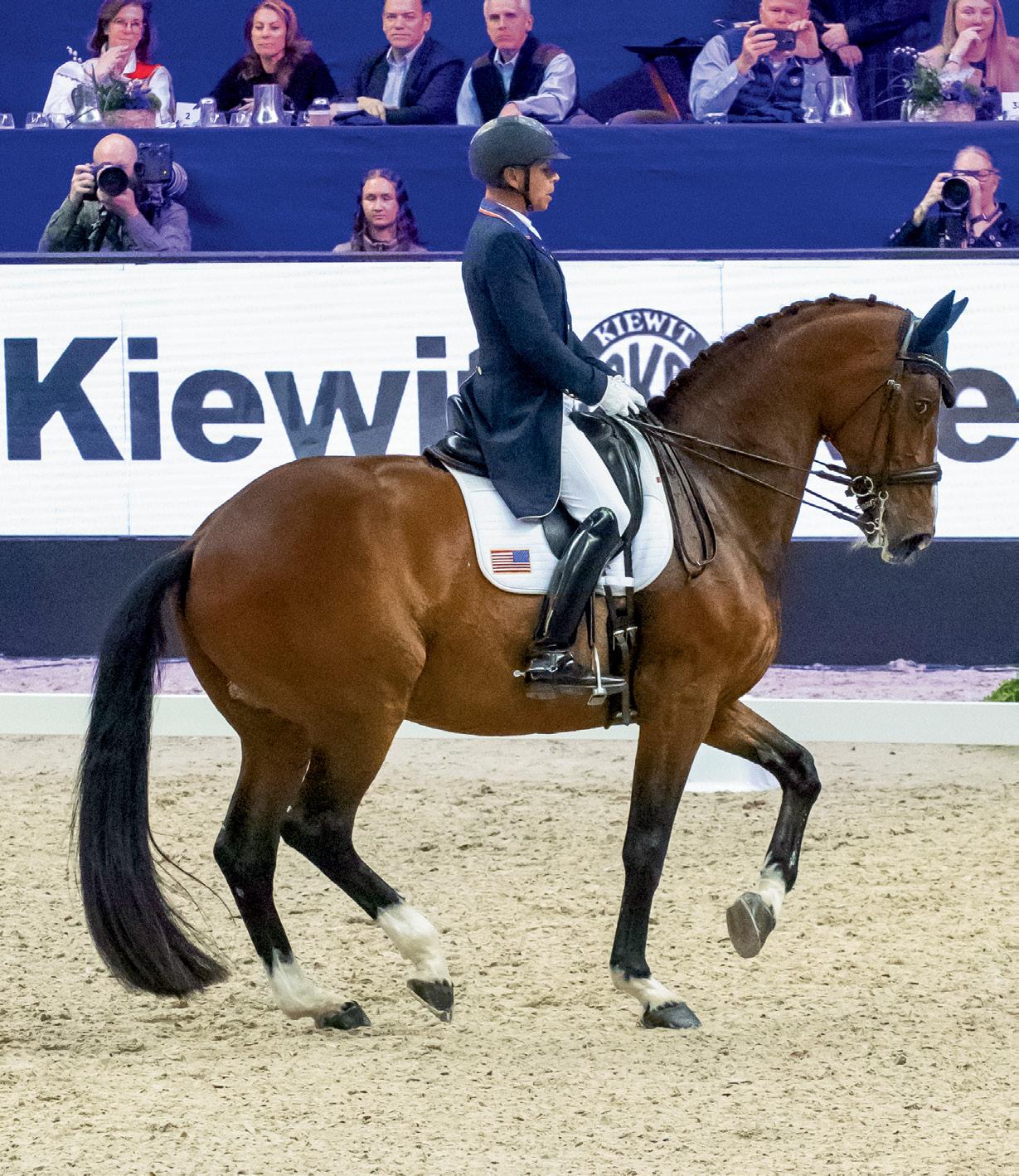
but where they shone was in the freestyle.
“We had to try and top it from Tokyo,” said Peters, 58, a dancemusic enthusiast and sometime DJ. His dance-music freestyle with Mopsie went viral on TikTok during the 2020 Tokyo Olympics when a fan posted a clip and enthused about the “Rave Horse.” Peters’ music for Omaha did in fact kick it up a notch—an amalgam of dance music and other danceable tunes, including the affirming “OK” by Robin Blunt and James Schulz; the rider’s longtime favorite “We can dance” refrain from the 1980s classic “Safety Dance”; and a new, inspired injection of the Bee Gees’ disco classic “Stayin’ Alive” (which was perfect with Mopsie’s passage). The freestyle concluded with what has become Peters’ signature ending: a final center line of spoken rhyming patter, this time in the persona of the horse who’s “from California by the seashore / I roll with fever on the dance
60 July/August 2023 | USDF CONNECTION
SPIN ME ’ROUND: Steffen Peters put his dance moves to good use in his fresh, funky freestyle aboard Suppenkasper, including this piaffe pirouette
SOARING: Anna Buffini and FRH Davinia la Douce gave an inspiring performance to music from the movie Top Gun: Maverick
floor.” The performance earned a score of 83.921%—not quite high enough for a podium finish; Peters ended up fourth.
Buffini lights the afterburners. Another top-notch all-American freestyle was the performance by Anna Buffini, who rocked the CHI Health Center with a medley of songs from Top Gun: Maverick The multitalented athlete from San Diego even performed her own vocals that accompanied the walk work, and at just 28 she became the youngest US athlete ever to compete in a World Cup Dressage Final. She’s coached by three-time US Olympian Guenter Seidel.
With her own 16-year Hanoverian mare, FRH Davinia la Douce (Don Frederico x A Jungle Prince), Buffini put in a compelling, exciting ride with a few minor bobbles, to earn a sixth-place finish on a score of 77.843%.
“I’m thrilled,” Buffini said afterward. Davinia la Douce “really gave everything to me. She’s listening even when it’s so difficult—a 10 out of 10 difficulty. And she’s just with me. She tries so hard, and she felt incredible today.”
US-bred mare makes the USA proud. Omaha was the first time on an international stage of this size for Alice Tarjan, Oldwick, New Jersey, and her 10-year-old Hanoverian mare, Serenade MF (Sir Donnerhall x Don Principe). The pair’s qualifying for the World Cup Final was all the more exciting to US dressage and sport-horse enthusiasts because Serenade was bred by the well-known sport-horse breeder Maryanna Haymon at her Marydell Farm in North Carolina.
Tarjan, 43, purchased “Shrimp” as a foal from her breeder and has done all of the mare’s training
herself, with help from her coach, Marcus Orlob.
The pair had what Tarjan termed a “serious miscommunication” in the Grand Prix, in which Shrimp thought her rider asked for a halt instead of piaffe. “That was really honest on her part,” Tarjan said afterward. The mistake was costly, however, and they finished fifteenth on a score of 67.065%.
Tarjan’s freestyle improved markedly—the rider quipped that “we kind of redeemed ourselves from last time.” There were a few pilot errors, but the pleasing ride ride to light instrumental music earned a score of 75.207% for ninth place.
“It’s really exciting to be here,” Tarjan said of her first World Cup Final experience. “The experience has been really fun.”
See “A Finals First-Timer’s Perspective” on page 64 for our exclusive interview with Tarjan.
Three Tough Breaks
The field of 18 horse/rider combinations sadly dwindled over the course of the competition, and only 15 started in the GP Freestyle.
The 11-year-old KWPN stallion Hermes N.O.P. (Easy Game x Flemmingh), who made a splash by winning the Grand Prix Special and Grand Prix Freestyle bronze medals at last year’s World Championships with Dutch rider Dinja van Liere, did not start in the Grand Prix in Omaha. The decision to withdraw must have come quite close to van Liere’s start time, as even the FEI stewards in the warm-up area were in the dark until the last minute. The Royal Dutch Equestrian Federation issued a terse statement the following day that Hermes was withdrawn because he “was not fit to compete.”
Audiences and supporters were further disappointed when, one day after they finished fourth in the Grand Prix on 75.543%, Germany’s Ingrid Klimke announced that her mount, the 15-year-old Hanoverian stallion Franziskus FRH (Fidertanz x Alabaster), had taken a “misstep” and would not start in the freestyle.
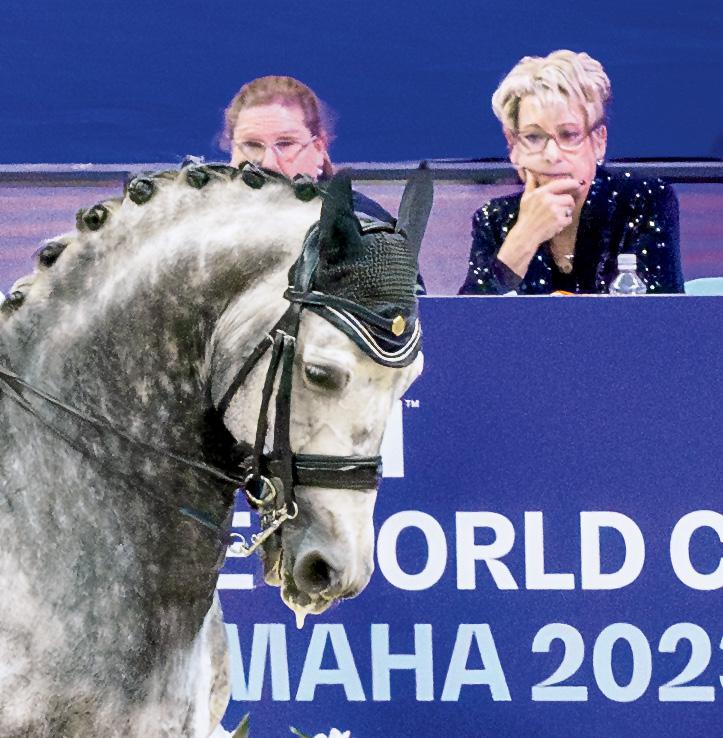
The final blow, and another setback for the Dutch, came the morning of April 7, freestyle day, when the 11-year-old Danish Warmblood gelding Torveslettens Titanium RS2 (Totilas x Stedinger) colicked and was withdrawn. He had finished eighth in the Grand Prix on 70.776%. “It has never happened before,” the Dutch federation stated, and rider Marieke van der Putten was understandably “devastated” at the turn of events.
Janet Foy: The View from C
FEI 5* dressage judge Janet Foy was the US representative on the World Cup Dressage Final ground jury, and for the Grand Prix Freestyle she sat at C.
“It’s a great honor to be president,” Foy said afterward. “It’s the first time I’ve been president of the ground jury. It was fun.”
As compared to an Olympic Games
USDF CONNECTION | July/August 2023 61
MADAM PRESIDENT: The USA’s Janet Foy (scrutinizing Dutch entry Hexagon’s Ich Weiss, who finished fifth) was at C for the Grand Prix Freestyle. Her scribe was USDF Region 5 director Heather Petersen.
2023 FEI World Cup Dressage Final Results (Grand Prix Freestyle)
Judges:
K: Katrina Wüst (GER)
E: Leif Törnblad (DEN)
H: Jean-Michel Roudier (FRA)
C: Janet Lee Foy (USA)
M: Maarten van der Heijden (NED)
B: Magnus Ringmark (SWE)
F: Stephen Clarke (GBR)
or a World Championships, judging a World Cup Final is “a totally different competition,” Foy said. With the former, “you have two days of Grand Prix with almost 40 to 45 horses a day, so you have two very, very long days. This competition is almost a vacation because you have 18 horses.” And “with the total spotlight being on the freestyle…it’s a special competition. Everybody loves to judge it.”
Asked how she deals with judging so many types of horses, Foy was unfazed.
“Every piaffe of course has a little bit different technique,” she said. “Some [horses] sit more; Dalera sits a lot; some of the others were very active and very regular but didn’t sit as much. For a [mark of] 10, [the FEI rule] says they have to sit and take weight. But you can still give an 8 or a 9 if they stay active and keep the rhythm and are in a nice, soft frame and it’s harmonious. There’s 10s for lots of different reasons, and different ways to achieve that.”
* A = Technical-execution score. B = Artistic-presentation score.
Two very different types of horses are the two that haven’t yet competed against each other: Dalera and Glamourdale.
“I have to say, seeing Glamourdale and Dalera together in the same ring is going to be something,” Foy said. She admitted to feeling “sort of relieved that [Glamourdale] didn’t come because it would have been a lot of pressure [on the judges] for that first time head to head. So I’m happy to let that happen at the European Championships [this September] and let Mike Osinski [US FEI 4* judge, who’s on the panel for that competition] deal with it!” she laughed.
Regardless of whom they’re judging, judges strive to apply uniformly the standard that they have been taught, said Foy, who is also a USDF L program faculty member.
“We do our best. We sit in our chair, we let our training take over, and we judge what we see. Sometimes our scores are a little different because we have seven people
around the arena, and sometimes you see a little bit of a tongue or a mouth open, or the neck is short, and you don’t see that someplace else,” she explained. “Overall, I think, if you look at the placings, they were very, very good tonight.”
For a detailed look at the judges’ marks and placings, see “2023 FEI World Cup Dressage Final Results” above. And for more photos, video, and behind-the-scenes reporting from Omaha—including a look at how the world’s top riders warm up their horses—go to yourdressage. org/2023/04/17/2023-fei-worldcup-finals-omaha.
Jennifer Bryant is the editor of USDF Connection.
62 July/August 2023 | USDF CONNECTION
RIDER/HORSE K E H C M B F TOTAL 1.
BB (GER) A B % 81.250 97.200 89.225 (1) 84.750 97.000 90.875 (1) 85.750 96.000 90.875 (1) 83.250 99.600 91.425 (1) 82.000 98.600 90.300 (1) 83.250 97.600 90.425 (1) 83.500 97.000 90.250 (1) 90.482 2.
A B % 79.750 94.200 86.975 (2) 82.500 95.600 89.050 (2) 81.750 90.200 85.975 (2) 78.500 95.200 86.850 (2) 79.250 94.500 86.825 (3) 81.000 95.800 88.400 (2) 79.500 92.400 85.950 (3) 87.146 3. ISABELL WERTH/ DSP QUANTAZ (GER) A B % 76.250 93.600 84.925 (4) 79.750 96.000 87.875 (3) 76.000 88.800 82.400 (3) 77.250 95.200 86.225 (3) 97.500 94.400 86.950 (2) 78.000 90.800 84.400 (3) 80.500 94.600 87.550 (2) 85.761 4. STEFFEN PETERS/ SUPPENKASPER (USA) A B % 78.500 91.400 84.950 (3) 79.000 90.000 84.500 (4) 76.750 86.200 81.475 (4) 76.750 95.000 85.875 (4) 75.750 90.200 82.975 (4) 77.250 88.600 82.925 (4) 78.500 91.000 84.750 (4) 83.921 6. ANNA BUFFINI/ FRH DAVINIA LA DOUCE (USA) A B % 71.750 85.000 78.375 (6) 70.500 83.800 77.150 (6) 69.500 82.600 76.050 (8) 73.250 83.600 78.425 (5) 70.00 86.800 78.400 (7) 71.000 82.800 76.900 (6) 74.000 85.200 79.600 (5) 77.743 9. ALICE TARJAN/ SERENADE MF (USA) A B % 69.000 78.200 73.600 (11) 69.750 80.600 75.175 (9) 69.750 81.200 75.475 (9) 71.000 83.200 77.100 (8) 70.250 82.000 76.125 (9) 69.750 80.200 74.975 (8) 70.000 78.000 74.000 (10) 75.207
JESSICA VON BREDOWWERNDL/TSF DALERA
NANNA SKODBORG MERRALD/ BLUE HORS ZEPTER (DEN)
World Cup Finals Photo Gallery
COLORFUL VENUE: Whimsical statuary graces the apron of Omaha’s CHI Health Center, which sported a giant banner promoting the 2023 FEI World Cup Finals and its theme of honoring native-American cultures and their proud equestrian traditions
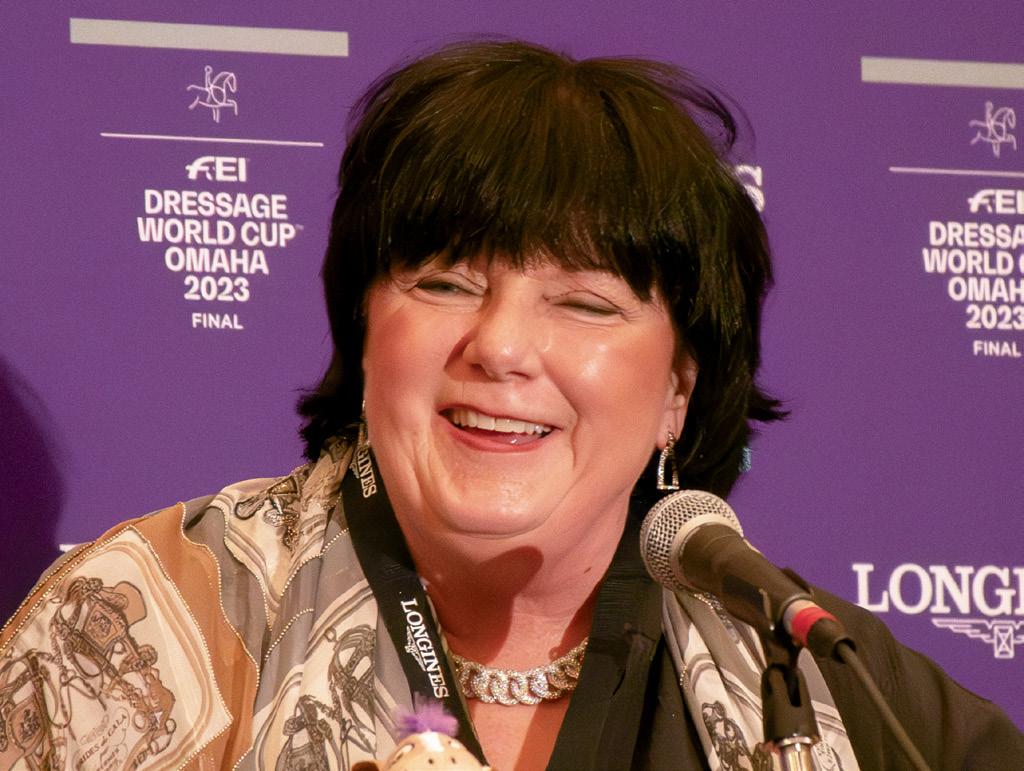

MESSAGE OF SUPPORT: The first Lithuanian rider to compete in a World Cup Dressage Final, Justina Vanagaite on Nabab was an audience favorite. Blue-and-yellow ribbons on her coat showed her support for Ukraine, as did her freestyle, with its good-vs.-evil theme apparent in her music, including “The Imperial March (Darth Vader’s Theme)” from Star Wars and music from the Indiana Jones franchise.
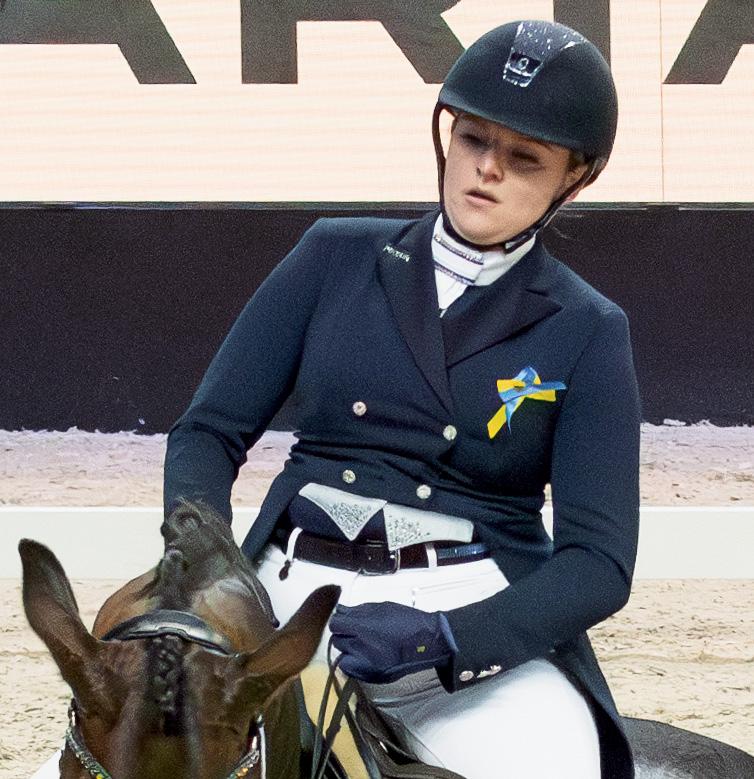
SPRAY TIME: Dousing one another (and sometimes the officials) with bubbly has become a tradition during World Cup Dressage Final prizegiving ceremonies. Champion Jessica von Bredow-Werndl lets fly at third-place finisher Isabell Werth.
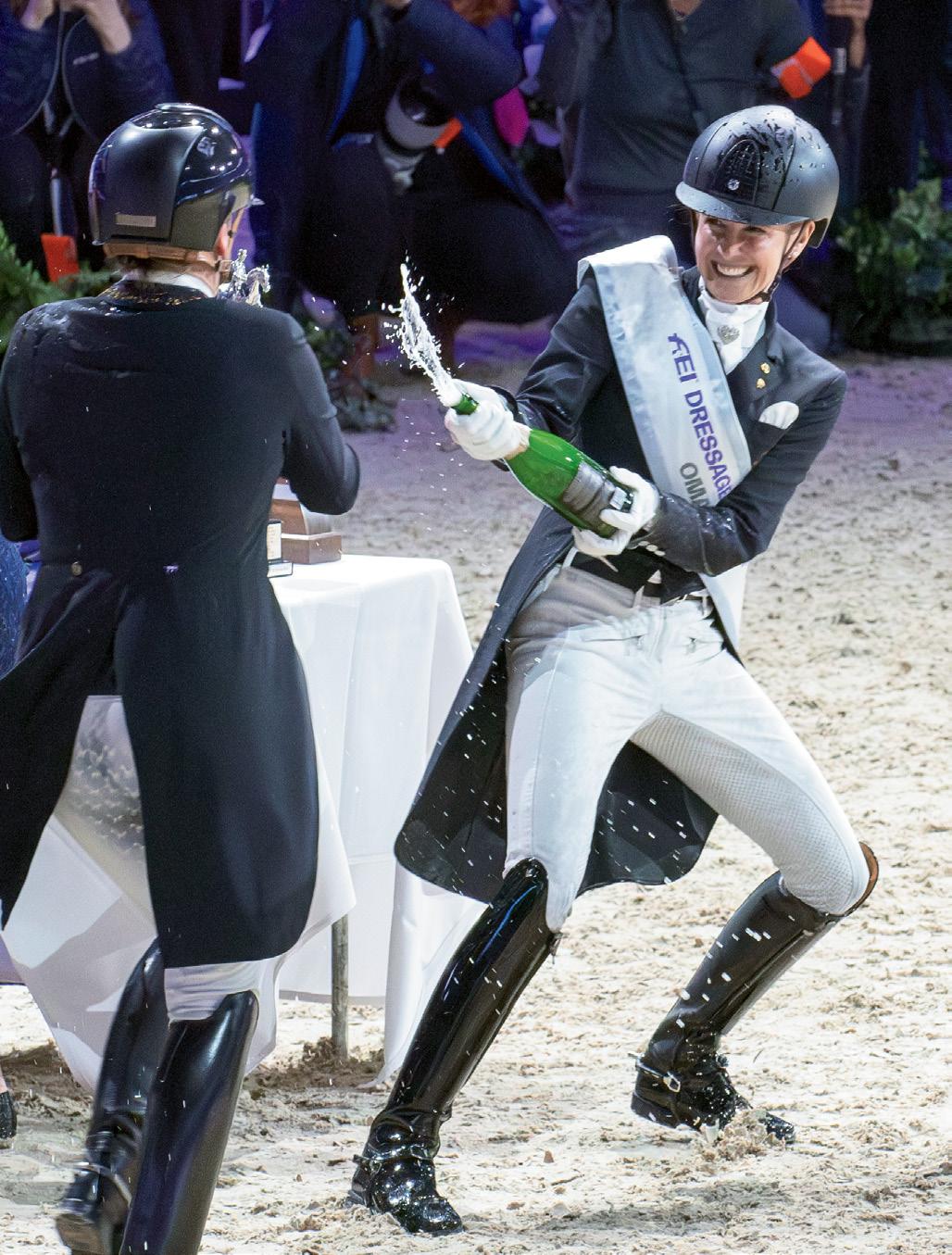
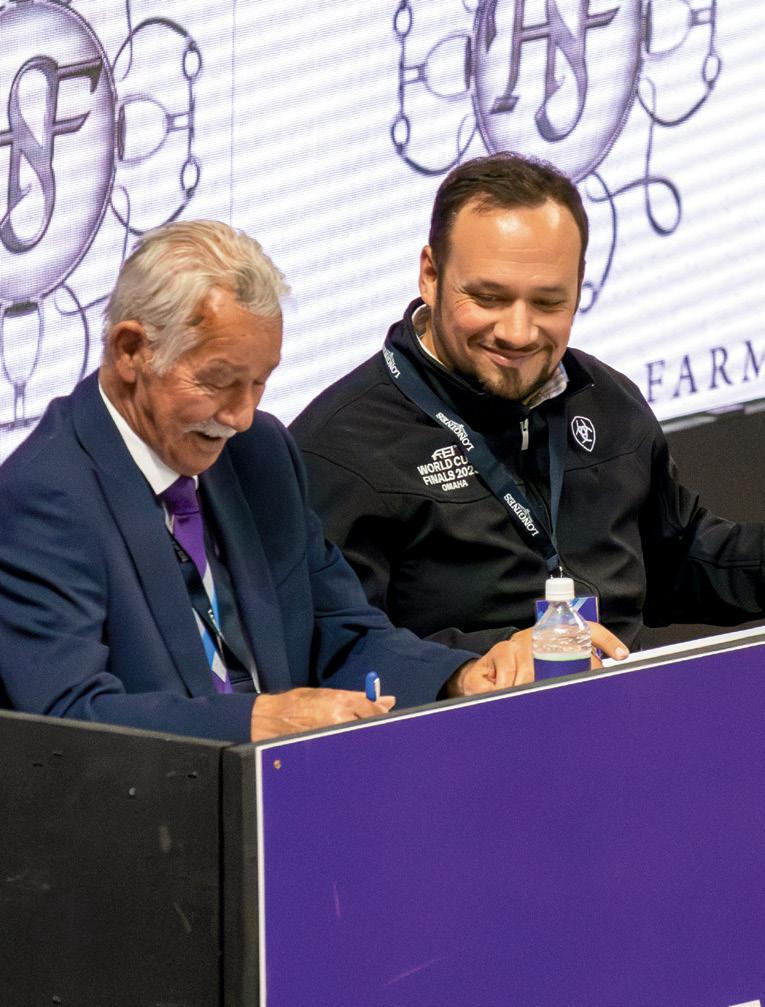
NOT JUST DRESSAGE: Omaha also hosted the FEI World Cup Jumping (pictured) and Vaulting Finals
 USDF IS IN THE HOUSE: USDF Region 6 director Noah Rattner (right) scribed for judge Stephen Clarke of Great Britain
THANKS TO OUR SPONSOR: Betsy Juliano, owner of 2023 World Cup Dressage Final presenting sponsor Havensafe Farm, at the Grand Prix Freestyle press conference
USDF IS IN THE HOUSE: USDF Region 6 director Noah Rattner (right) scribed for judge Stephen Clarke of Great Britain
THANKS TO OUR SPONSOR: Betsy Juliano, owner of 2023 World Cup Dressage Final presenting sponsor Havensafe Farm, at the Grand Prix Freestyle press conference
USDF CONNECTION | July/August 2023 63
A Finals First-Timer’s Perspective
The step up to the world stage brings competitors excitement and opportunity—and also unprecedented levels of scrutiny and media interest.
One who was taking it all in for the first time in Omaha was the USA’s Alice Tarjan. The New Jersey native—who stepped away from a law career to focus on dressage full-time and who competes nationally as an adult amateur—is well known to American dressage audiences for her string of successes at the Adequan® Global Dressage Festival, the US Dressage Festival of Champions, and many other top shows; but the 2023 FEI World Cup Dressage Final was her first foray into major international championship waters.
USDF Connection caught up with Tarjan on the morning of the Grand Prix Freestyle, to get her newcomer’s perspective and to learn how she keeps her barn so well-stocked with top talent. Following are edited excerpts from our interview.

USDF Connection: How has your World Cup Final experience been so far?
Alice Tarjan: It’s sort of what I expected. It’s super exciting to be here. It’s amazing to see all the European riders and horses. Any time you get to watch them, it’s such a learning experience.
Tell me about Serenade MF.
I bought her as a foal. I just thought she was pretty; she was black with white socks. And I liked the breeding, At the time, I think there were a lot of Sir Donnerhalls [offspring] that were doing well in the Young Horse classes, so he was sort of an exciting sire; and [breeder] Maryanna Haymon’s mare [Duet MF, by Don Principe] had done pretty well in the breed shows and looked like a decent horse, so I thought I would just buy her and see what she turned into.
You have a reputation as someone who’s really good at spotting young-horse talent.
Yeah. I kind of think buying foals is a complete lottery, in fact. For sure this one [Serenade] ended up being a super horse, of course, but I think the training has a lot to do with it. When we broke her, I was not impressed at all: She was really little, and she cribbed, and she moved like a little hunter. And I thought, I don’t want to keep it, but how am I going to sell it? So I said to a friend, get the horse going, bring the
horse to [Dressage at] Devon, do the Materiale, hopefully get some scores so we can sell it. [After some training] I was like, wow, that horse has actually got some movement to it….So I kept her and trained her up, and she won the Four-Year-Olds [USEF national championship].
It’s amazing how drastically some horses can change from the training. It’s a credit to her, too: She’s a very trainable horse and has a great attitude, and she works really hard. She obviously has natural athletic ability, too; you can’t [make] a horse go like that.
I buy these horses off video, right? They come over [from Europe], or I buy foals and you get them under
SPOTLIGHT: Competitors at international events must learn to cope with media attention. Alice Tarjan gives an interview to FEI TV after her Grand Prix test.
64 July/August 2023 | USDF CONNECTION
saddle, and plenty of times you’re like, wow, this isn’t quite what I thought, or I don’t love this ride, but you’re stuck and I’ve got to get it trained. [As a result] you end up training all types, and it makes you a better trainer. The more you do, the better you get at it.
Where did your eye for horses come from? Is that something you worked to develop?
I rode a lot of horses. I got the horse bug in fourth grade. I did Pony Club and evented a little bit through college. I wasn’t able to buy a Young Rider horse. I basically rode anything that anybody would let me ride for free. I got $200 horses off the track.
It sounds like quite a journey, from off-the-track Thoroughbreds to these incredible horses.
You talk to young people coming up, the numberone question is: How do I find a sponsor to go buy me a trained horse? First of all, if the horse is well trained and ready to go in the ring, the amateur owner wants to ride it and isn’t going to pay you to ride it. So you’re going to end up with the problem ones, and you’d better learn how to fix the problems.
I guess my message is, yes, that’s one path—try to find one wealthy sponsor, and hope they have enough money to buy you a good horse. But there’s another path, and that’s to learn to train them. You can get to know your horse much better, and you can end up with a way better horse than you could buy because you couldn’t afford that horse once it’s trained.
It gives you so much more independence. I don’t have a sponsor or an owner I’ve got to keep happy. I don’t have to [tell a sponsor], “Yes, I’ll get you to Paris [2024 Olympics].” If I get the scores, I get the scores. I don’t have to explain it to anybody.
US sport-horse enthusiasts have talked for years about the importance of breeding good horses here and bringing them along.
It’s the only way you get the really top ones. I have some pretty decent horses in my barn, and I know the offers I’m turning down from the Europeans. You can’t buy these horses [once they’re trained]. If you want horses with the potential for [scores of] over 75%, there aren’t that many out there, and they are astronomically priced. Probably the easiest and most efficient way is to produce them yourself.
Somewhere along the line, I figure, you must have sold a couple.
I sold a whole bunch—some not quite the quality that I want, and some that are fantastic. Quite often you end up selling really fantastic horses because they’re really saleable and you can get good money.
Hopefully my story can excite people and show them that there’s another way of doing it. You can train them, and it gives you independence and it gives you good horses, and you can fund yourself through it because trained horses are worth a lot of money. Then you buy the next young ones and have a pipeline that keeps coming.
You’re getting ready for tonight’s freestyle. How are you feeling going in?
It’s not as polished and presented as I’d like it to be, but she’s a good horse and she’ll take a good stab at it.
I don’t feel that much pressure in this kind of class of riders. In some shows, you’re the heavy favorite and all eyes are on you, and you feel a lot more pressure. Here, I feel like I’m here to learn, and it’s a process. It takes lot of pressure off. There is pressure: It’s on American soil, and there are lots of people who want me to do well, and I want to do well for the Americans. But when it’s me and the horse in the arena, I’m kind of at peace, and you just do your job as best you can.
It’s all relative. [The winter circuit in] Florida’s hard because it’s so competitive. I always feel so unconfident, like, all these people must look up to me, like I know what I’m doing: “You must have your s*&t together!” I’m like, no.
Have you given any thought to what might be next for Serenade?
She’s going to get a rest, for sure. We [Tarjan and her coach, Marcus Orlob] haven’t really discussed what the summer looks like going forward.
I think you follow the horses [in making plans]. I’m never going to tell you, my goal is to go here or there. My goal is to train the horses the best I can and try to present that well in the ring. The scores are what end up dictating what you’re doing or not doing. At the end of the day, if my horses are all sound and happy, that’s good enough for me.
USDF CONNECTION | July/August 2023 65
Practical Advice
New books offer heaps of how-to equestrian advice— plus a generous dollop of theory for you dressage philosophers
By Jennifer O. Bryant
A
Perfect Book if Your Horse Isn’t

The first edition of Dressage for the Not-So-Perfect Horse was a hit because, well, that’s what most of us have. It’s frustrating when the horse doesn’t react the way the textbooks say it should, or when we encounter a problem that’s outside the purview of conventional-wisdom training theory.
Rider/trainer Janet Foy, a USDF L program faculty member and an FEI 5* dressage judge; and co-author Nancy J. Jones have updated their successful book with new photos and lots of tips on dealing with “imperfections and evasions” in the daily training and in the show ring (Trafalgar Square, 218 pp., HorseAndRiderBooks.com). Foy includes many photos of and anecdotes about her own mounts— most of which were quirky—and there are many examples of professionals and amateurs alike achieving good results with equines of all sorts. If you yearn for a book that’s practical and inspirational, not just aspirational, you’ll love Dressage for the Not-SoPerfect Horse.
The Price of Ambition
Riders and trainers inevitably make mistakes, and our horses bear the cost, no matter how much we love
them. It can be difficult to reckon with our equestrian pasts, but David De Wispelaere does not shy away from hard truths in his equestrian memoir, My Horses Have Something to Say (Xenophon Press, 118 pp., XenophonPress.com).

De Wispelaere recounts his unassuming start with horses growing up in New York state, and later his introduction to dressage and his rise through the ranks, which brought him training and competitive opportunities both in the US and abroad, including with such renowned masters as Dr. Reiner Klimke and Arthur Kottas. He punctuates the book using recollections of his most unforgettable mounts, many of which taught him valuable and sometimes hard lessons. The most painful memories, he writes, stem from failures to listen to what his horses had to say.
The stories in My Horses Have Something to Say will resonate with most dressage enthusiasts, and De Wispelaere provides insights into the intersection of classical training and modern dressage. The attractive design and many photos could have benefited from a touch more editorial scrutiny, but this little book is still a worthy read.
The KISS Approach to Training
Yes, the cartoon on the cover of The Sport Horse Problem Solver (Trafalgar Square, 256 pp., HorseAndRiderBooks.com) is rudimentary. But this is one book you shouldn’t judge by the proverbial cover, because this is actually a helpful guide for dressage riders, eventers, and jumpers.
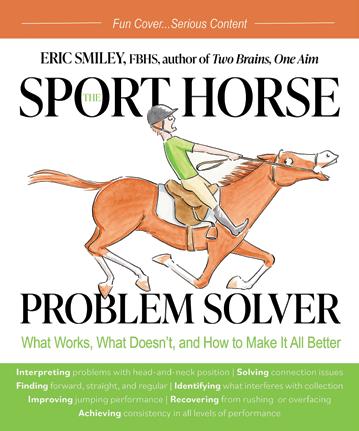
Author Eric Smiley (Look… No Hands!; Two Brains, One Aim), a
former international event rider representing his native Ireland, is a British Horse Society Fellow, a former FEI judge, and coach of the 2012 Belgian Olympic eventing team, among others. Those in the highperformance realm often seem to lose the “common touch” with the average horse and rider, but Smiley hasn’t, and he is remarkably able to explain complex concepts, issues, and solutions in simple and concise language. If you get flummoxed by the pyramid of dressage training, or if you sometimes have trouble figuring out what the dressage judge actually meant by those comments, The Sport Horse Problem Solver will help you make sense of it all—and will point the way toward better riding and training.
Essential Guide
Hoof care and shoeing are so critical to a horse’s soundness and performance that entire professional journals have been devoted to the topic.
So it’s surprising that relatively little on the subject has been written for the rider and horse owner.
Steven Kraus and co-author Katie Navarra have remedied this lack with their book, Shoeing the Modern Horse: The Horse Owner’s Guide to Farriery and Hoof Care (Trafalgar Square, 220 pp., HorseAndRiderBooks.
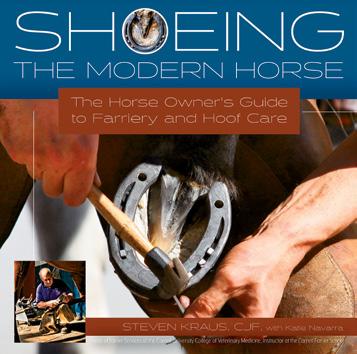
66 July/August 2023 | USDF CONNECTION
Reviews
com). Kraus, an American Farriers Association certified journeyman farrier, is the head of farrier services at Cornell University College of Veterinary Medicine in New York. He shares his vast experience in shoeing a wide range of breeds for practically every purpose, as well as in treating foot problems.
Shoeing the Modern Horse goes way beyond the typical descriptions of horseshoe types, abscess treatments, and trimming basics. Kraus explains how conformation affects the feet and legs and ultimately a horse’s soundness; how to choose shoes for different needs; hoof care for foals; why horses lose shoes and what you can do about it; how foot problems are diagnosed and treated; how to train your horse to be “farrier friendly”; how farriers are educated; and much more. Shoeing the Modern Horse is an invaluable reference that belongs in every horse owner’s library.
The “Lightness” Debate Continues
Deep divisions in beliefs didn’t start with mid-2010s US politics. In the dressage world, it’s been around for decades, and it’s known as “German vs. French” or “modern vs. classical” approaches to training and riding.
“Lightness” advocates Dominique Barbier (Dressage for the New Age) and Liz Conrod present their arguments against straying from the established classical and FEI rules and principles in Broken or Beautiful: The Struggle of Modern Dressage (Xenophon Press, 130 pp., XenophonPress.com).
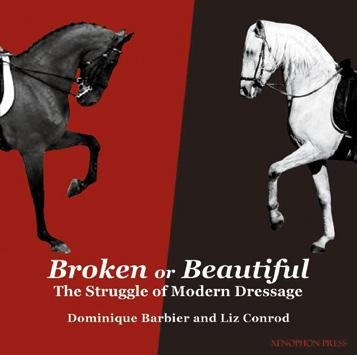
Barbier and Conrod are by no means the first to call out the bad and the ugly in competitive dressage. Some readers will take issue with a thinly disguised photo of British Olympic champions Charlotte Dujardin and Valegro being shown as an example of bad riding, and the
book would feel more balanced if a few photos of successful presentday competition horses had been included as “good” examples. The theorists will have a field day debating whether the many images of Iberian horses working on slack reins depict correct dressage. But the authors’ hearts are in the right place—wanting to see relaxed, willing mounts in the sport instead of tense, unhappy-looking horses.
Neuroscientific Training for Equestrians
At the 1992 winter Olympics in Albertville, German ski jumper Marc Nölke suffered a bad crash. He never returned to his pre-Games performance level—the result, he eventually determined, of neurological damage from a concussion that was never properly rehabilitated.
The life-changing experience sparked Nölke’s interest in learning how to “train the brain” to improve balance, proprioception, breathing, and vision, among others. He is now a certified trainer who works with athletes in many sports, including equestrians, and he presents what he calls neuro-rider training in his book, Neuroathletics for Riders (Trafalgar Square, 162 pp., HorseAndRiderBooks.com).
Through exercises for the vestibular, visual, respiratory, and other bodily systems, Nölke aims to help all equestrians—not just those who have suffered concussions or other injuries—to improve their confidence and performance.
Clever Cavalletti
In this translation from the original German, German Equestrian Federation-certified instructor Ann Katrin Querbach goes beyond the
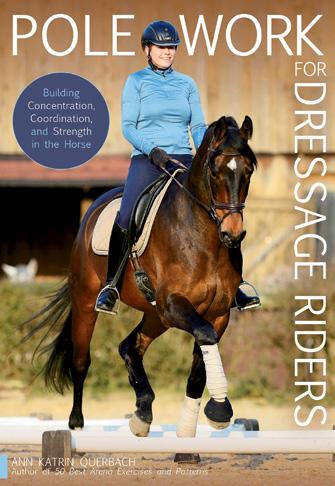
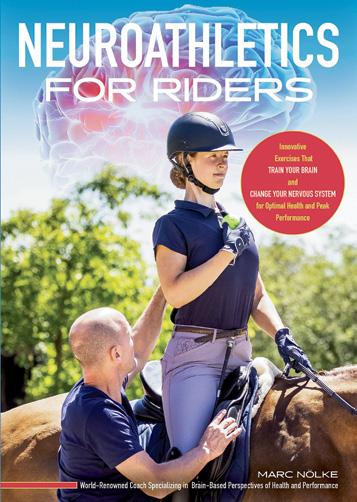
usual advice about using cavalletti to improve dressage horses’ strength, rhythm, and cadence. Pole
Work for Dressage Riders
(Trafalgar Square, 176 pp., HorseAndRiderBooks.com) presents 56 exercises that can be practiced on the lunge line or under saddle to accomplish the above, in addition to improving straightness and bend and helping to correct weaknesses and asymmetries. Querbach also shows the importance of correct rider alignment in achieving optimal results.
USDF CONNECTION | July/August 2023 67
Hilton Omaha nov 29–Dec 2 2023
celebrate usdf’s 50th anniversary o m a h a, n e
Jennifer Bryant is the editor of USDF Connection.
Adequan®/USDF
DRESSAGE TESTS YOUR CONNECTION TO DRESSAGE EDUCA TION • COMPETITION • ACHIEVEMENT
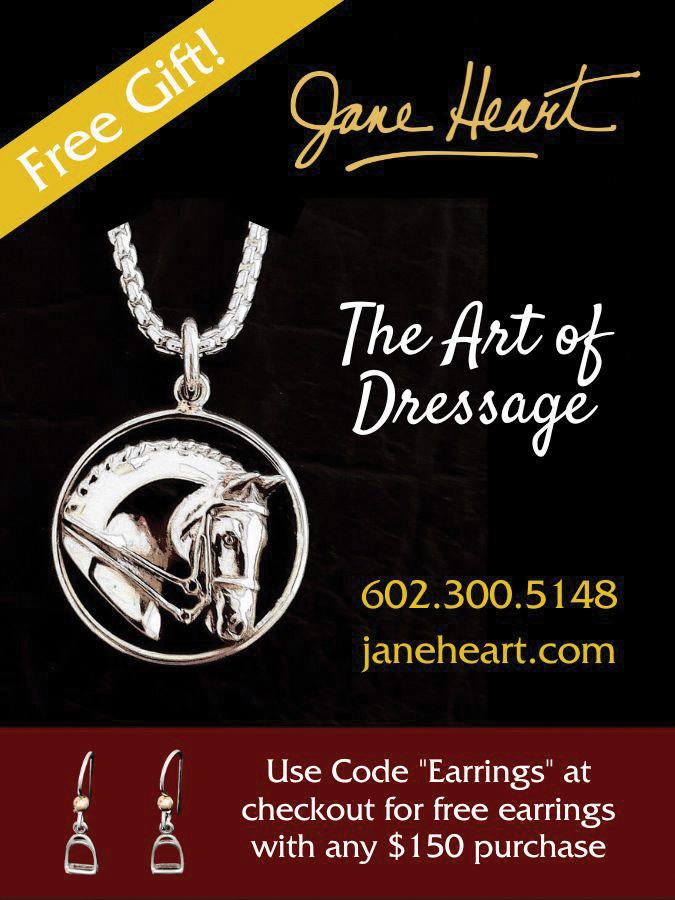




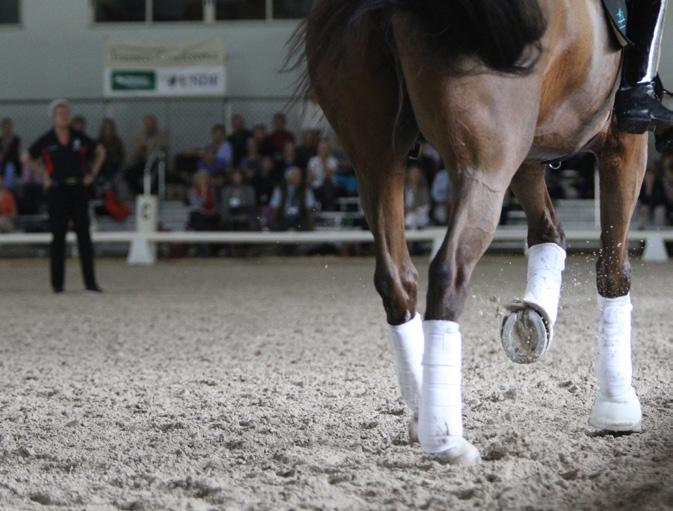



BREED REGISTRY
BREED REGISTRY
www.usdf.org
EDUCATION
HORSE BEDDING
T aylor S elec T H or S e B edding
Mention this ad and receive $100 off of your first semi load
LARGE FLAKE l BLENDED FLAKE MINI FLAKE l PINE PELLETS CHOPPED STRAW


S elect the B e S t 815.601.3002 www.taylorselect.com call / text / email SHIPPING NATIONWIDE



HORSE BEDDING
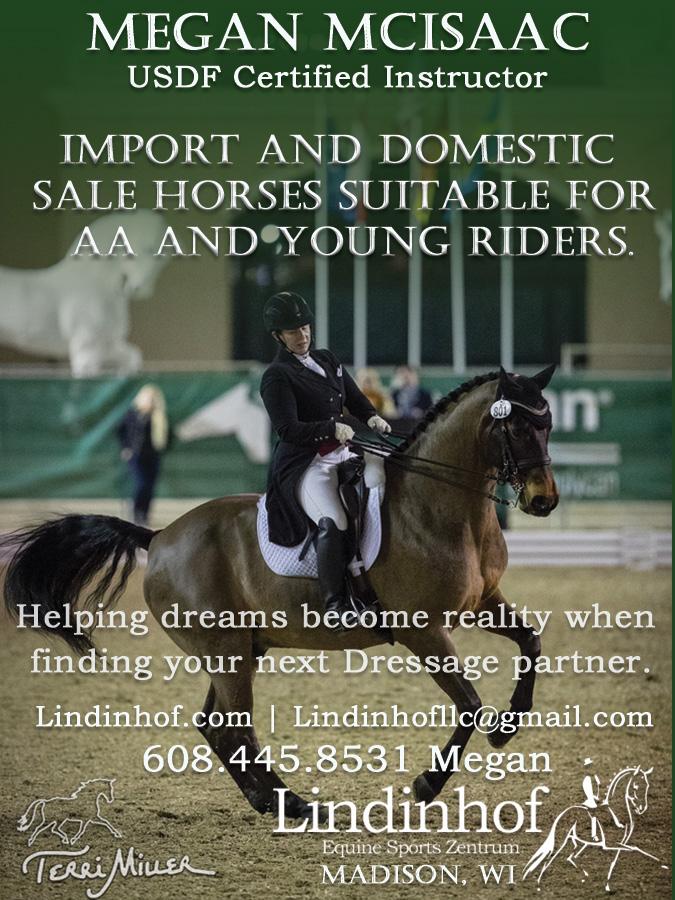
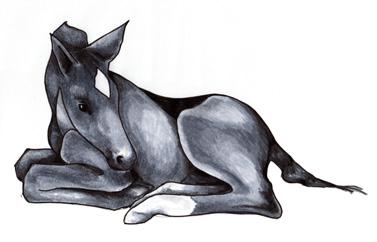

SALE HORSES
EDUCATION
JEWELRY
HORSE HEALTH
SALE HORSES
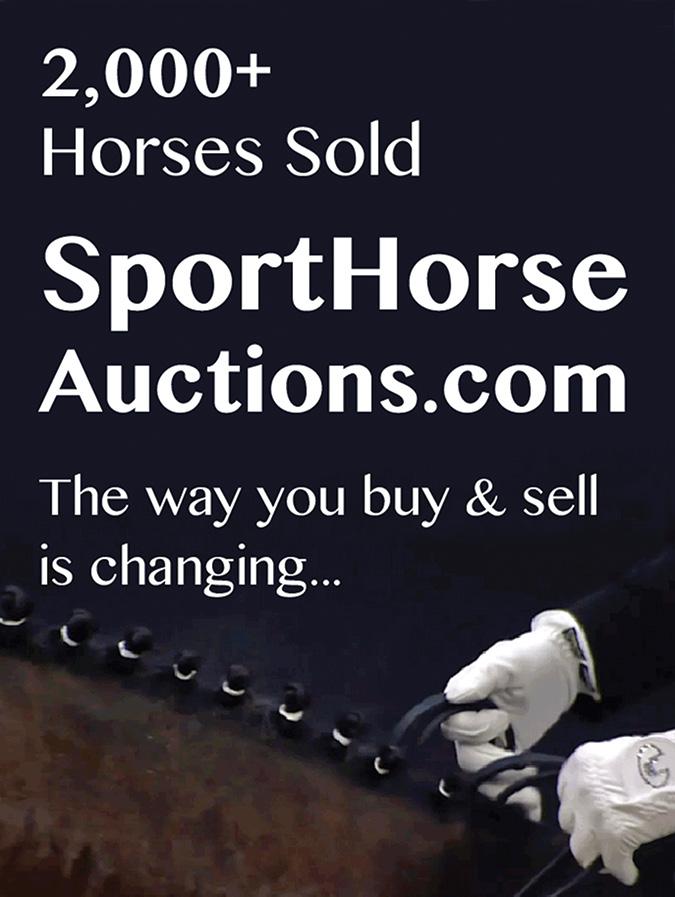
68 July/August 2023 | USDF CONNECTION RIDER'S MARKET
ACCESORIES
APPAREL &
ART & DESIGN PHOTOGRAPHY
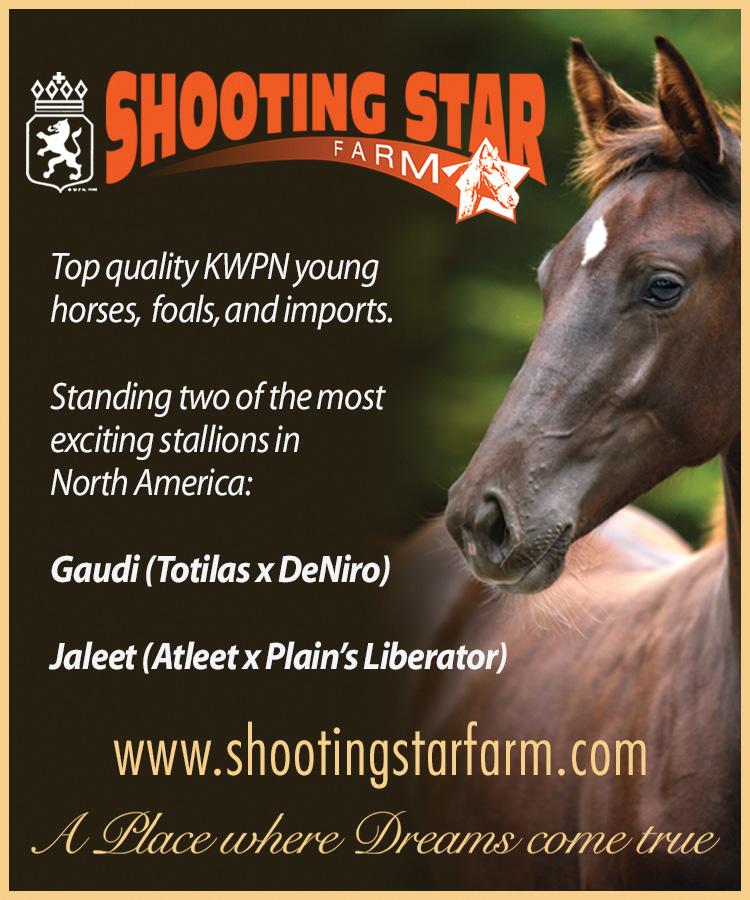
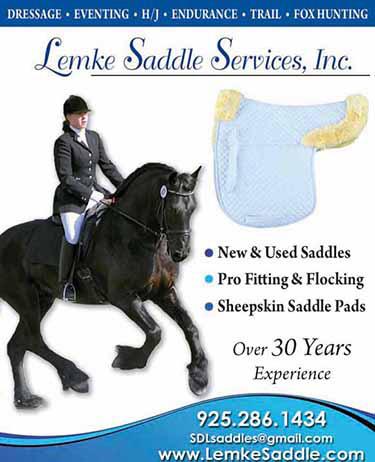
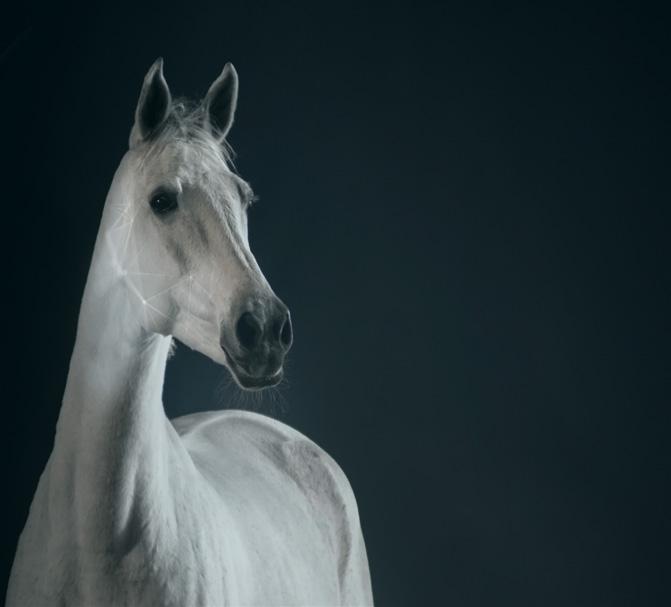

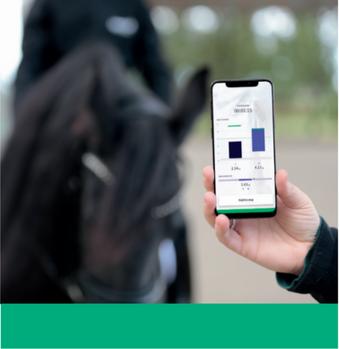
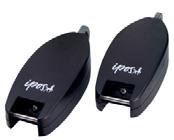












































































































































































































































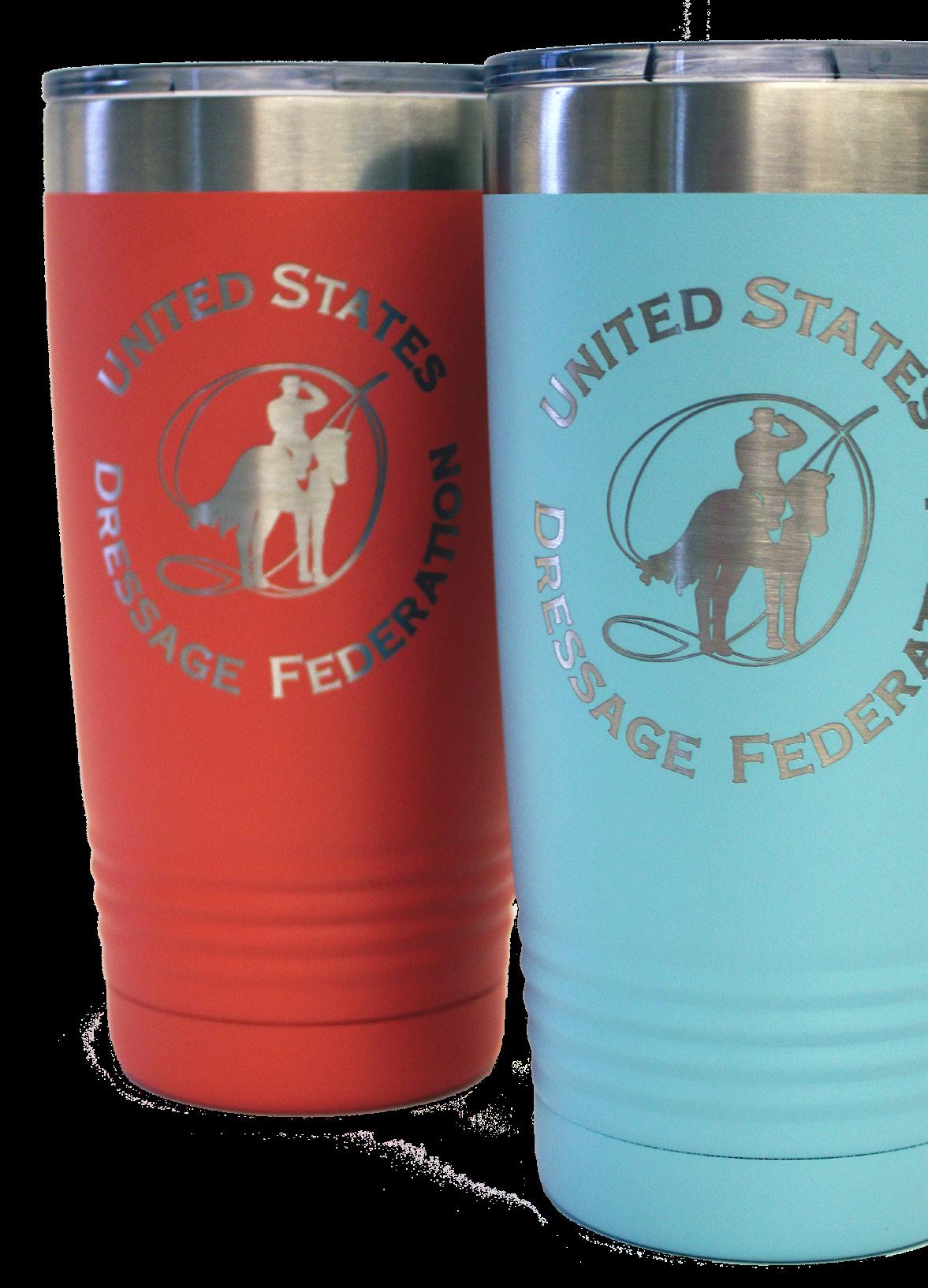

USDF CONNECTION | July/August 2023 69 Demos and more info about the FREE Online Coaches Course available on our website Achieve lightness and symmetry with the Ipos Rein Sensors, and quantify the ‘equestrian feel’! The Ipos Rein Sensors measure rein tension on the left and right side, giving equestrians insights to improve performance. www ipostechnology com TACK TACK SALE HORSES USDF travel tUmbler $19.95 USDF DiamonD Polo $39.95 IN MENS AND WOMENS www. USDF .org/ S tore order online at H ello
USDF OFFICE CONTACT DIRECTORY
For specific staff contacts visit the USDF Web site.

USDF Connection wants YOU to be a contributor.
Here’s how.
Air Your Views
USDF Connection welcomes letters to the editor. Please send your digital submission by e-mail to jbryant@ usdf.org. Please include your hometown, state, and daytime telephone number. We’ll publish letters as space allows; all submissions are subject to editing. Unsigned letters will not be considered, although writers may request that their names be withheld. All letters become the property of USDF.
Ask a Question
Do you have a dressage- or USDFrelated question? Send it to “FAQ” and you may get an expert response in a future issue of USDF Connection.

Send your question, along with your full name, hometown, state, and daytime telephone number to editorial@usdf.org. Include “FAQ” in the subject line of your message.
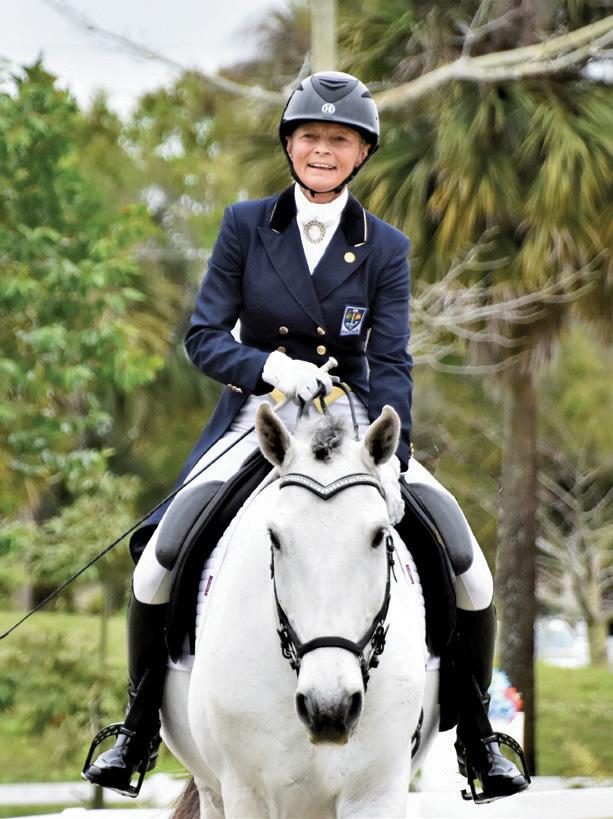
70 July/August 2023 | USDF CONNECTION NONPROFITORG. U.S.Postage PAID Dr. Hilary Clayton on Donzi MC July/August 2021 Official Publication of the United States Dressage Federation FOCUS ON HORSE HEALTH Buyer’s Guide to the Prepurchase Exam (p. 44) Handling GMO Conflict (p. 20) Raise Your Training Standards with Sue Blinks (p. 30)
MAKE THE CONNECTION
Phone: (859) 971-2277, Fax: (859) 971-7722, E-mail: usdressage@usdf.org Accounting (859) 271-7891 accounting@usdf.org Address and E-mail Updates (859) 971-2277 changes@usdf.org Adult Education Programs (859) 271-7894 education@usdf.org All-Breeds Awards ....................................................................... (859) 971-7361 ............................ allbreeds@usdf.org Applications Submitted at Competitions ................................ (859) 271-7880........................... affidavits@usdf.org Breeder Championship Series (859) 271-7878 sporthorse@usdf.org Demographics and Statistics (859) 271-7083 stats@usdf.org Donations (859) 971-7826 donate@usdf.org FEI Youth Clinics (859) 971-7317 jryrclinics@usdf.org GMO Education Initiative (859) 271-7894 education@usdf.org Group Membership (859) 971-7048 gmo@usdf.org Hall of Fame and Lifetime Achievement Awards ................. (859) 271-7873 ........................ halloffame@usdf.org Horse Performance Certificates ............................................... (859) 971-7361 .......... horseperformance@usdf.org Horse Registration (859) 271-7880 horseregistration@usdf.org Human Resources/Career Opportunities (859) 271-7885 hr@usdf.org Instructor Certification (859) 271-7877 instructorcertification@usdf.org Insurance Certificates for Competitions (859) 271-7886 compins@usdf.org L Education and Continuing Education (859) 971-7039 lprogram@usdf.org Licensed Official Education (859)-271-7877 loeducation@usdf.org Mailing Lists (859) 971-7038 mailinglist@usdf.org Musical Freestyle .......................................................................... (859) 971-7039..............musicalfreestyle@usdf.org NAYC Criteria and Procedures ................................................. (859) 971-7317 .................................... nayc@usdf.org Nominations – Delegates, Regional Directors (859) 271-7897 nominations@usdf.org Participating and Business Memberships (859) 271-7871 membership@usdf.org Prize List Questions (859) 271-7896 prizelist@usdf.org Regional Championships Program (859) 271-7886 regchamps@usdf.org Rider Awards (859) 971-7361 riderawards@usdf.org Safe Sport (859)-271-7894 safesport@usdf.org Score Corrections (859) 271-7895 scorecorrections@usdf.org Secretary/Manager Services .................................................... (859) 271-7895.................... competitions@usdf.org Show Results ................................................................................. (859) 271-7895................................ results@usdf.org Sponsorship Opportunities (859) 271-7887 sponsorship@usdf.org Sport Horse Education and Programs (859) 271-7894 sporthorse@usdf.org Store Merchandise (859) 971-7828 merchandise@usdf.org University Accreditation and Credit Check (859) 271-7894 university@usdf.org USDFScores.com (859) 271-7878 reports@usdf.org USEF/USDF Dressage Seat Medal Program & Semi-Finals (859)-971-7886 youth@usdf.org Year-End Awards .......................................................................... (859) 971-7361 ................................awards@usdf.org Young Rider Graduate Program................................................ (859) 971-7317 ...................................youth@usdf.org Youth Education and Programs (859) 971-7317 youth@usdf.org
USDF CONNECTION | July/August 2023 71 ADVERTISING INDEX Arenus............................................................. arenus.com......... inside front cover, inside back cover Auburn Laboratories, Inc. .......................... auburnlabs.com............................................................... 19 American Warmblood Society & Sporthorse Registry awssr.org 68 Equine Design ............................................... stradi.us ........................................................................... 68 Dehner Company ......................................... dehner.com ..................................................................... 27 Dressage Collections ................................... dressagecollections.com................................................ 8 Great American Insurance Group ............. greatamericaninsurancegroup.com ............................. 5 IPOS Technology ipostechnology.com 69 Kentucky Performance Products............... kppusa.com ................................................................. 16-17 Lemke Saddle Services ............................... lemkesaddle.com ........................................................... 69 Lindinhof Equine Sports Zentrum ............. lindinhof.com .................................................................. 68 Platinum Performance ................................. platinumperformance.com............................ back cover Shooting Star Farm shootingstarfarm.com 69 Sox For Horses soxforhorses.com 21 Sporthorse Auctions.com ........................... sporthorseauctions.com ............................................... 68 TaylorSelect Horse Bedding....................... taylorselect.com ........................................................... 68 The Dressage Foundation .......................... dressagefoundation.org ................................................ 31 United States Lipizzan Federation ............ uslipizzan.org ................................................................ 68 USDF Convention ........................................................................................................................................ 1, 67 FEI Young Rider Clinic ........................................................................................................................... 7 Horse Registration .............................................................................................................................. 35 Store Merchandise ....................................................................................................................... 55, 69 University 23 US Dressage Finals - Patrons 9 US Dressage Finals ....................................................................................................................... 36-37 YourDressage.org............................................................................................................................2, 45 United States Dressage Federation Official Page USDF Vimeo @USDF @USDFOfficial GET CONNECTED with #USDF YOUR CONNECTION TO DRESSAGE EDUCA TION • COMPETITION • ACHIEVEMENT
Para-Dressage Is Her Life’s Work
US Para-Equestrian Association (USPEA) interim president Christina “Tina” Wentz has a goal: “to see Olympic and Paralympic as one—parallel.”
It’s a mission Wentz didn’t seek out, but rather one that found her when her son, Jonathan Wentz, announced his intention to become a Paralympian. And it’s one she continues to carry out today, 11 years after Jonathan’s sudden death at the age of 21.
By Katherine Walcott
After her marriage to James Wentz, the couple found themselves back in Texas for his job. They had two children, the younger of whom was born with cerebral palsy.
“We put him on a horse at age two for therapy,” Wentz says, “never dreaming that would be the start of such an incredible journey.”
Jonathan loved horses and riding, and his passion inspired his mother to extend her own professional training to include equine-assisted PT. She began working as a contract and consulting physical therapist, and she also learned to ride English.
In 2004, at the age of 13, Jonathan announced his goal: to become a Paralympian in the sport of paradressage. Eight years later, just weeks before his death, he became the highest-placing US athlete across all equestrian sports at the 2012 London Olympics and Paralympics.
mother found herself being “pulled away from work more and more, and thankfully James supported us 100 percent.” She is grateful that the entire family was able to watch Jonathan achieve his Paralympic dream in London.
As it happened, Tina Wentz’s personal and professional background were excellent preparation for her future roles. As a child growing up in the Texas panhandle, “Two of my best friends’ families owned ranches,” she recalls, “and we would ride all over, often incorporating a stop at their grandmas’ houses for cookies.”
The family later moved to Oklahoma, and Wentz continued to ride when she could, always in a Western saddle. She trained as a physical therapist, eventually becoming director of physical medicine with Mercy Health Center in Oklahoma City.
While her son was racking up awards in para-dressage competition, Wentz rode dressage at home. She rode some of the para-dressage tests “just for fun,” but also in order to appreciate the levels and to understand what it takes to score well, she says. “I just did enough to know, ‘Wow, there’s a lot to it.’”
Tina Wentz’s first official foray into the world of para-dressage came in 1997, when she got certified as a national (USEF) classifier. Classifiers, who evaluate athletes’ degree of impairment and assign them one of para-dressage’s five grades (competition levels), must have a PT or similar background, so Wentz was ideally suited.
As Jonathan’s riding and showing ramped up in pursuit of his first big goal—making the US para-dressage team for the 2010 Alltech FEI World Equestrian Games in Kentucky—his
Wentz views her role since her son’s death as “carry[ing] on his mission of helping to get US paradressage acknowledged as parallel and on the medal podium,” and also “to try and give back for all those who gave, encouraged, and helped Jonathan on his amazing journey.” In fact, her involvement in the sport has been deepening for years. In 2009, along with the late Hope Hand, she helped to found the USPEA; she served as the organization’s secretary (2009-2018) and vice president (2019-2022) before stepping up to interim president last year after Hand’s death. Wentz has also served on a variety of related sport committees and is now an FEI paradressage classifier and a USEF paradressage selector.
After 35 years in Texas, Wentz now divides her time between Oklahoma City and Buena Vista, Colorado. She says that a recent high point was watching the US team win the bronze medal at the FEI World Para-Dressage Championships Herning 2022.
Wentz says she is “thrilled with the funding and sponsors and recognition the sport has received in recent years. And my hope is that it will continue to grow. If I’ve been able to help even a little bit toward that growth, I achieved our goal.”

72 July/August 2023 | USDF CONNECTION
Katherine Walcott is a freelance writer living in Alabama.
Tina Wentz’s son, Jonathan, wanted to be a Paralympian. Even after his untimely death, she remains at the forefront of US para-dressage.
COURTESY OF TINA WENTZ Salute
CARRYING ON: Tina Wentz (left) with US bronze medalist Rebecca Hart at the FEI World Para-Dressage Championships Herning 2022


Complete Wellness
A wellness formula with all the benefits of Platinum Performance® Equine, designed to support all aspects of horse health from head to hoof.
Research
More than 30 veterinary research projects have supported the effectiveness and development of Platinum formulas.
Show Safe
All Platinum formulas are subjected to extensive testing for over 200 banned substances for athlete protection.
Go with the Gut
To Support Digestion & Immunity
Advanced GI Support
Platinum Performance ® GI includes a powerful combination of probiotics, prebiotics and glutamine to support healthy equine digestion and immunity.
Quality
We choose quality and efficacy over low-cost ingredients, ensuring formula protection, potency and purity.
Results
Developed by our veterinarians based on university research and trials in clinical practice to ensure results.
Platinum Colic Coverage™ Eligible
Platinum Performance® GI Proven Wellness + Digestive Care
It’s estimated that 70-80% of the immune system lives in a horse’s gastrointestinal system. Also closely correlated to gut health is allergic response, reproduction, metabolism, bone health, gastrointestinal function and more.
Platinum formulas are only available from your veterinarian or direct from Platinum Performance ® .
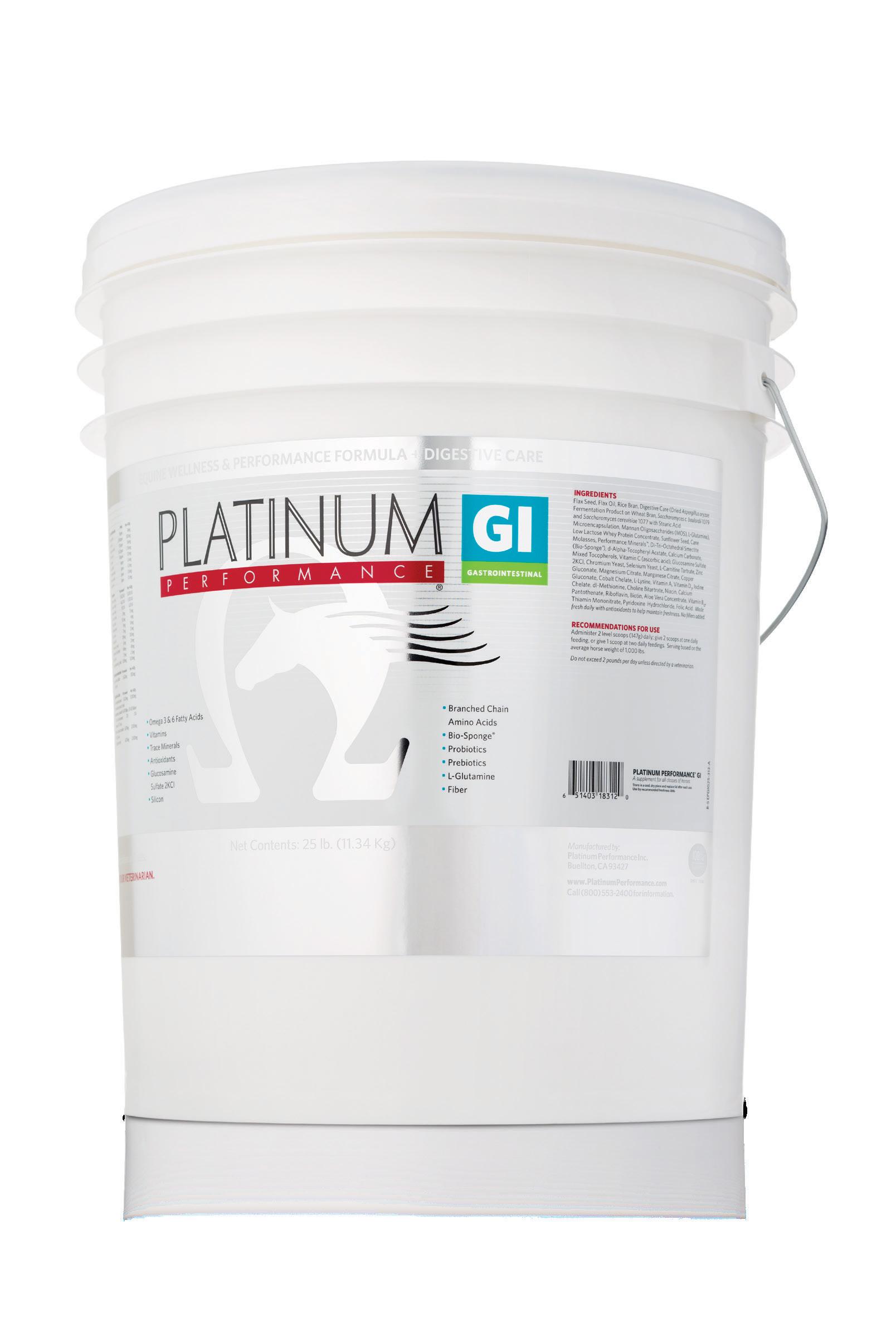
Recommended for horses: •
Platinum Performance® formulas are only available from your licensed equine veterinarian or direct from Platinum Performance®.
In training or competition
For wellness
With digestive health concerns
With difficulty maintaining weight
With loose stool
During travel
Also helpful to senior
•
•
•
•
•
•
horses
2023 PLATINUM PERFORMANCE, INC.
PlatinumPerformance.com 800-553-2400 ©













 MICHAEL BRYANT
MICHAEL BRYANT





































 By Marilyn Heath
By Marilyn Heath
 By Patti Schofler
By Patti Schofler







 By Jennifer Mellace
By Jennifer Mellace











 BY HEATHER SMITH THOMAS
BY HEATHER SMITH THOMAS














 BY RILEY GARRETT
BY RILEY GARRETT





















 USDF IS IN THE HOUSE: USDF Region 6 director Noah Rattner (right) scribed for judge Stephen Clarke of Great Britain
THANKS TO OUR SPONSOR: Betsy Juliano, owner of 2023 World Cup Dressage Final presenting sponsor Havensafe Farm, at the Grand Prix Freestyle press conference
USDF IS IN THE HOUSE: USDF Region 6 director Noah Rattner (right) scribed for judge Stephen Clarke of Great Britain
THANKS TO OUR SPONSOR: Betsy Juliano, owner of 2023 World Cup Dressage Final presenting sponsor Havensafe Farm, at the Grand Prix Freestyle press conference


























































































































